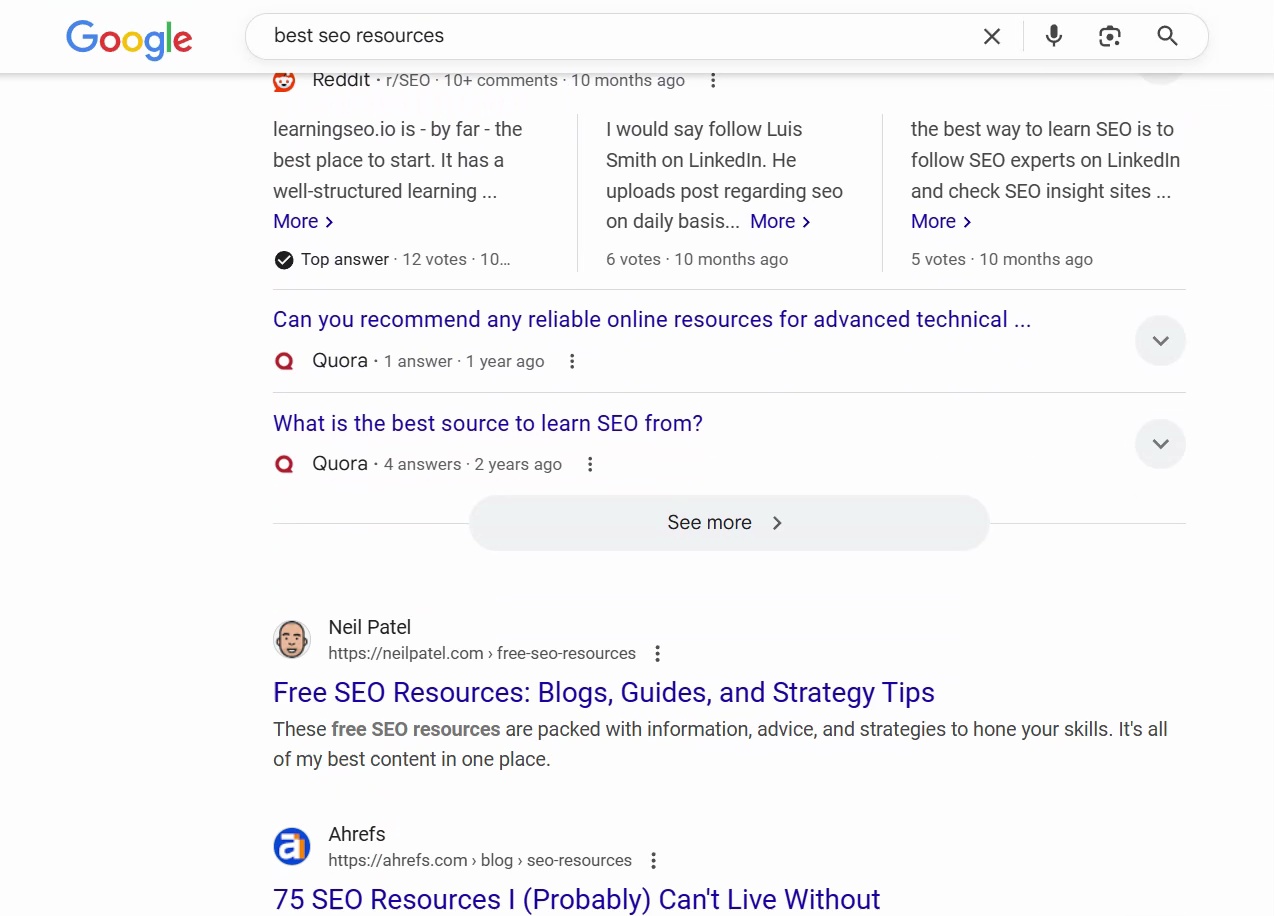I asked ChatGPT: “What are the best resources to learn SEO in 2025?”
The response mentioned Backlinko twice.
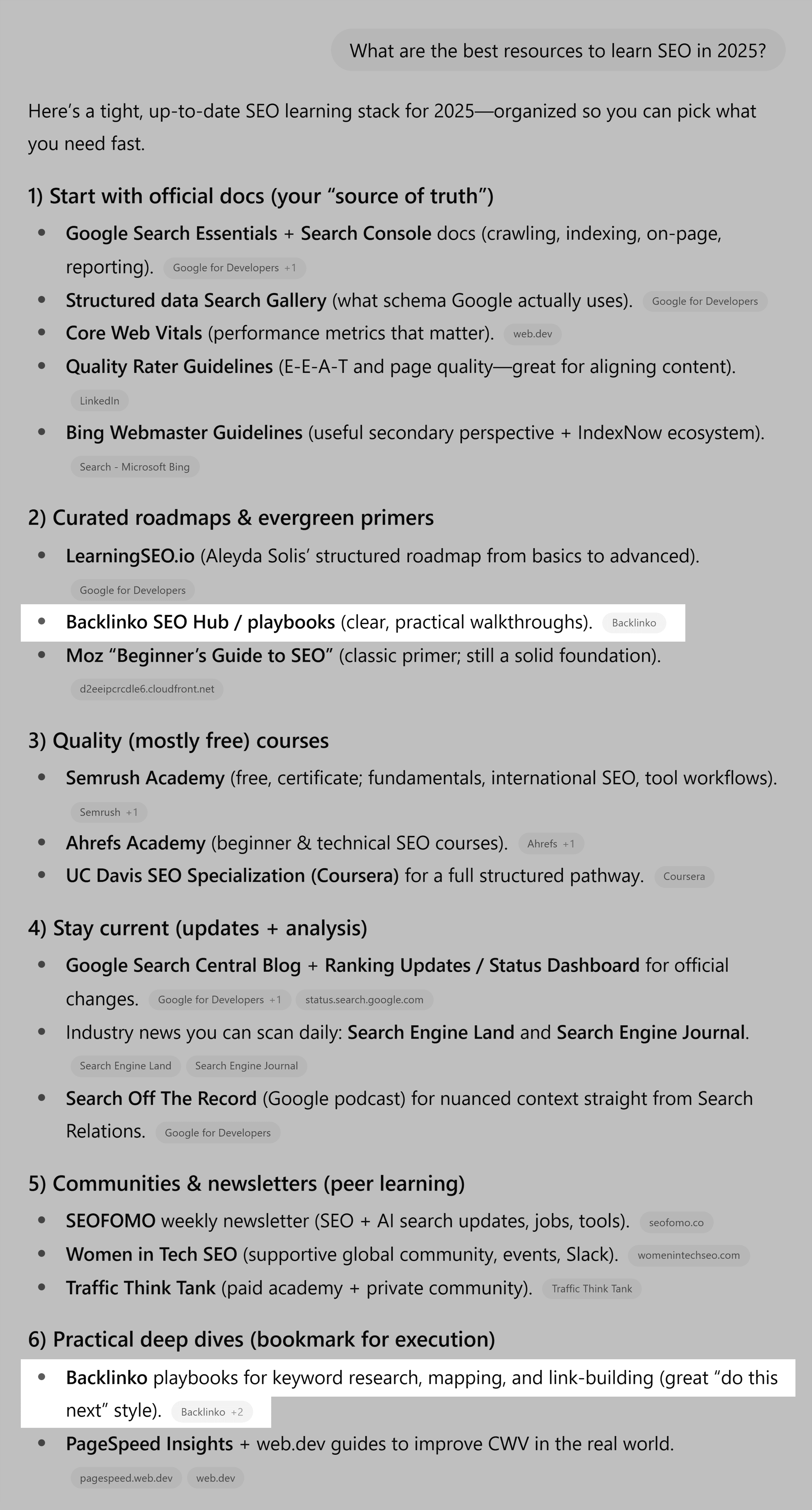
Here’s the thing: We don’t rank #1 in Google for “best SEO resources.” (Ads, Reddit, and AI Overviews take up that real estate).
We haven’t even optimized for “best SEO resources,” but we got mentioned anyway.
That’s LLM seeding in action.
Organic traffic is dropping across the board. Large language models (LLMs) are now answering your audience’s questions directly, quietly hijacking the clicks you used to count on.
Maybe you’ve already seen the dip. Maybe you see the writing on the wall.
Either way, it’s time to fight back — with a new kind of visibility strategy.
In this guide, you’ll learn:
- What to publish so LLMs actually cite you
- Where to seed your content for maximum pickup
- And how to track whether your brand is showing up
Get your brand into the conversation now — so you don’t get left behind.
What the Heck Is LLM Seeding?
LLM seeding is the practice of publishing content in the formats and places LLMs are most likely to scrape, summarize, and cite.
Here’s an example of a Backlinko article that encourages scraping with an LLM-friendly format:
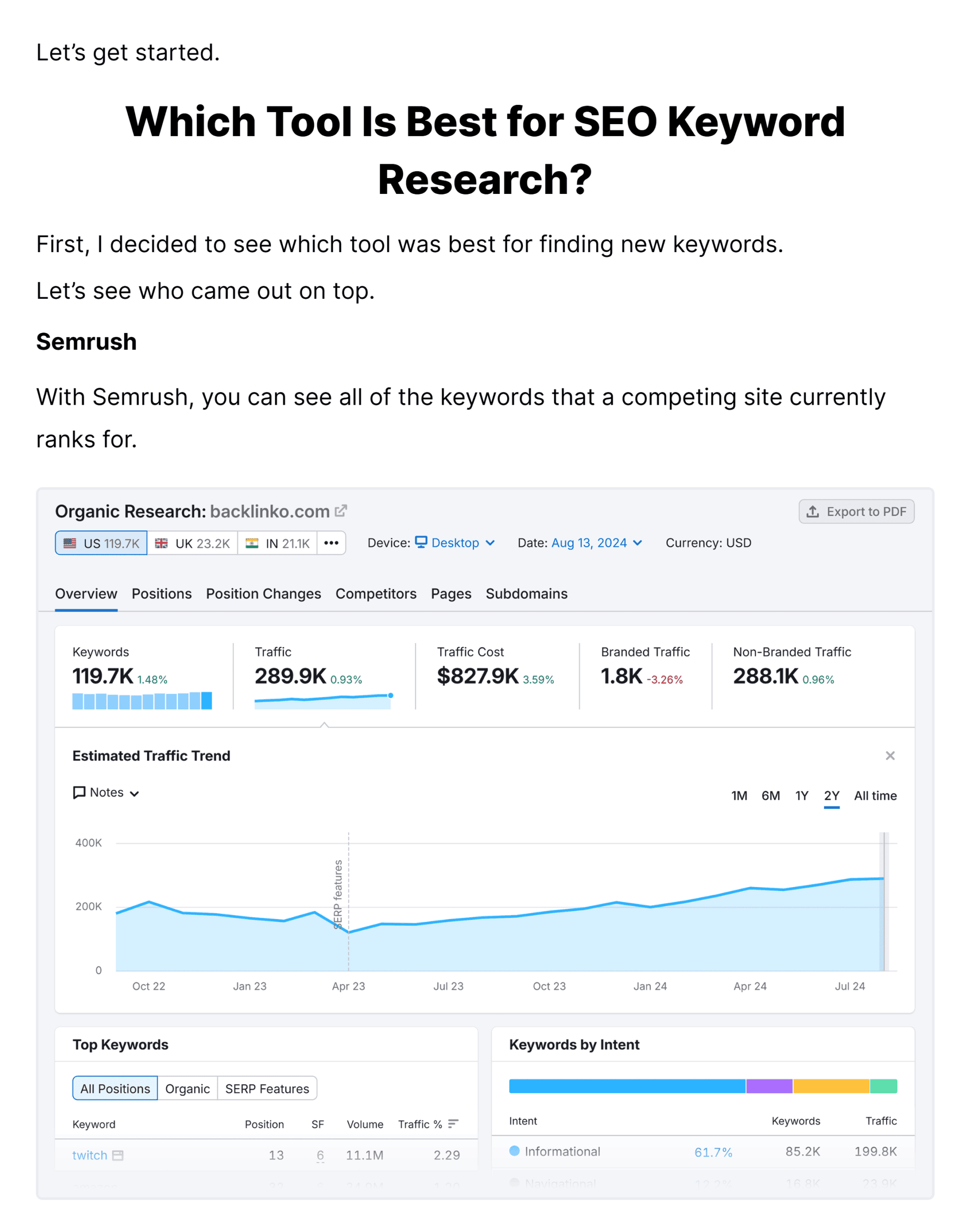
In other words: You’re not just optimizing for Google.
You’re optimizing for ChatGPT, Claude, Perplexity, and any other LLMs or AI search engines your audience uses.
Here’s how it works:
You create AI-friendly content, such as comparison posts with tables and FAQ sections.
And publish it in places LLMs look for information. (More on this later.)
When people ask LLMs for information related to your industry, they mention your brand in the answer.
Often, they don’t include a link to your site.
Still, that mention sticks.
Users notice it, remember it, and later search for your brand directly.
Over time, these citations drive more branded searches, direct traffic, and trust in your name.
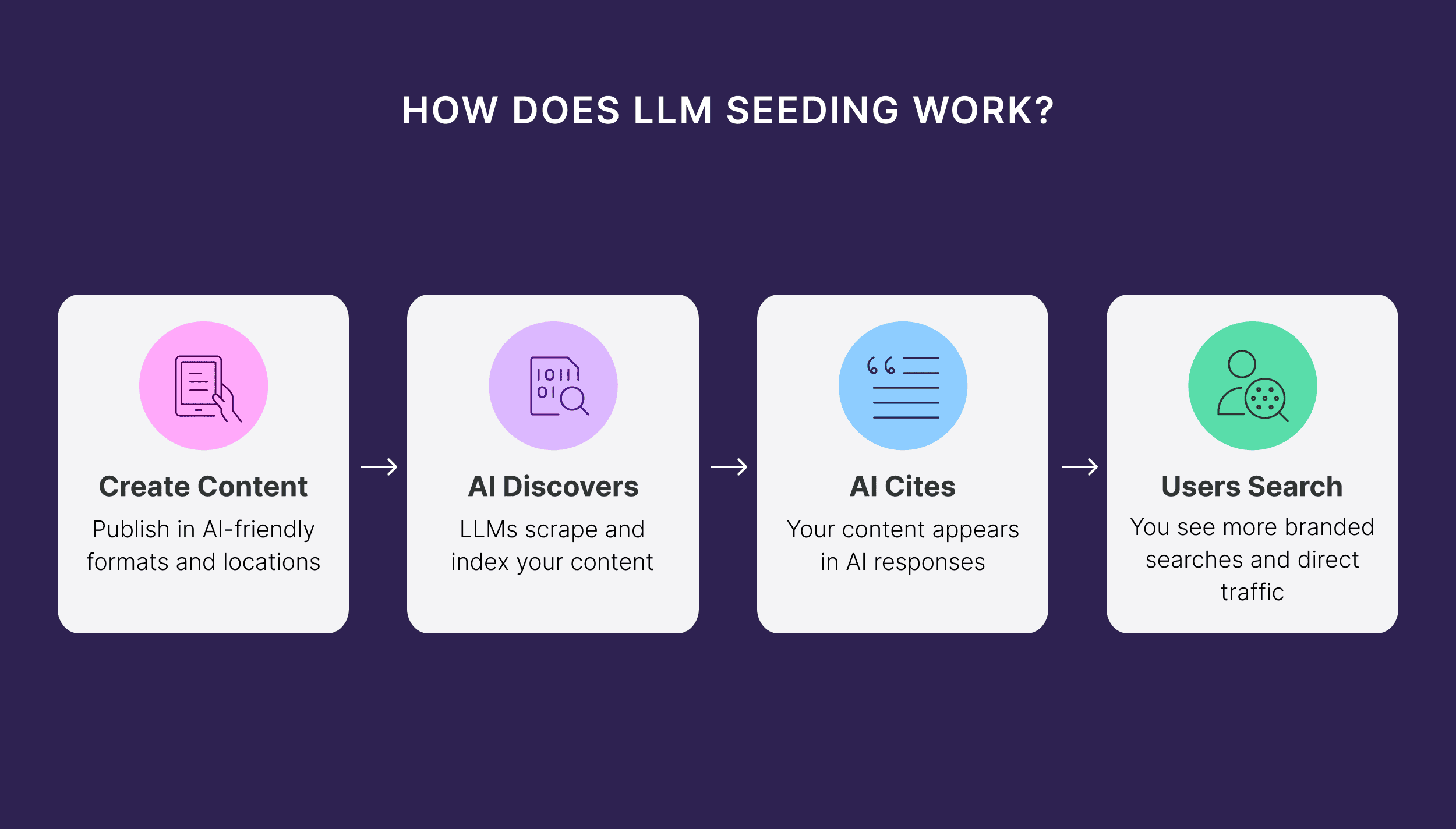
While LLM seeding is a new strategy, you’re not starting from scratch.
It builds on everything you already know about SEO, content marketing, and PR.
The difference? It requires a fundamental mindset shift.
You’re no longer optimizing for clicks. You’re optimizing for citations.
You’re building brand awareness, not backlinks.
And instead of trying to rank #1, you’re influencing what AI tools say about your brand.
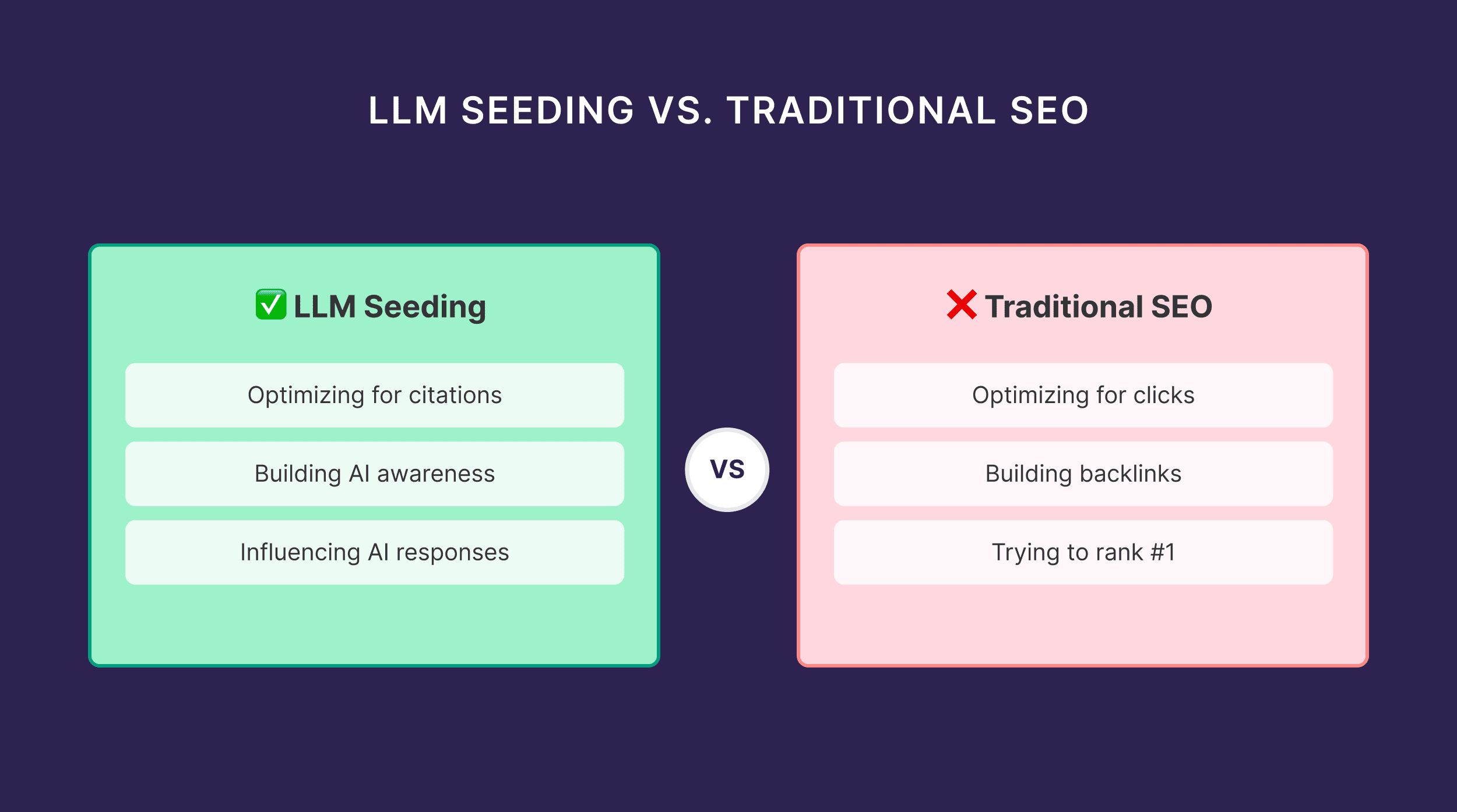
Adopting this new approach means rethinking how you show up online.
But it’s how you’ll stay visible and influential as search continues to evolve.
3 Big Benefits of LLM Seeding
Still chasing backlinks and rankings?
According to a Semrush study, AI search traffic will surpass traditional search by the end of 2027.
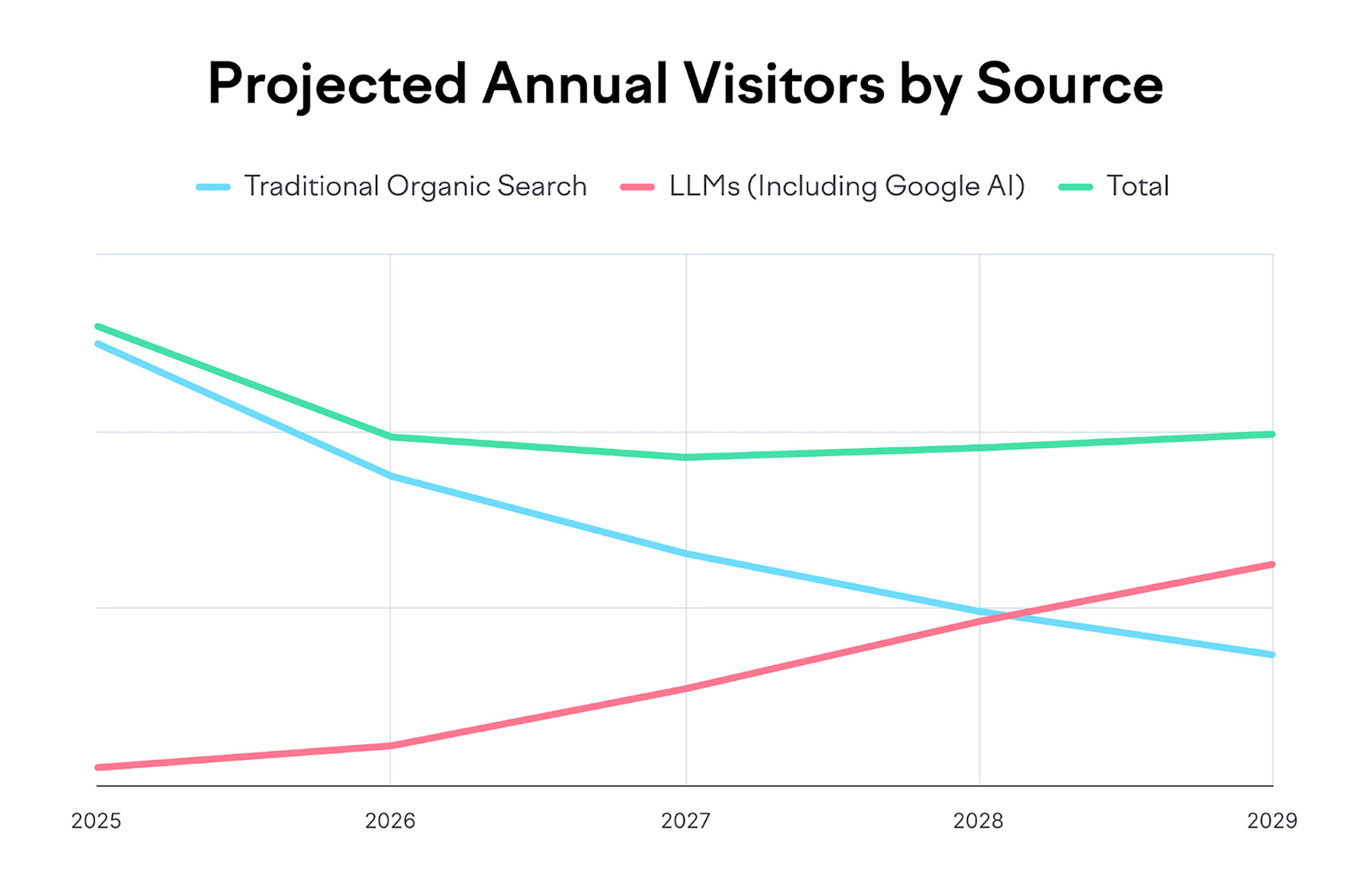
Shift your focus to LLM seeding now to stay competitive.
And prepare for a zero-click, LLM-driven world.
1. Brand Exposure Without Traffic Dependence
Here’s the problem:
Searchers no longer have to click search results to get the information they need.
Google’s AI Overviews and AI Mode provide detailed answers to questions and step-by-step instructions.
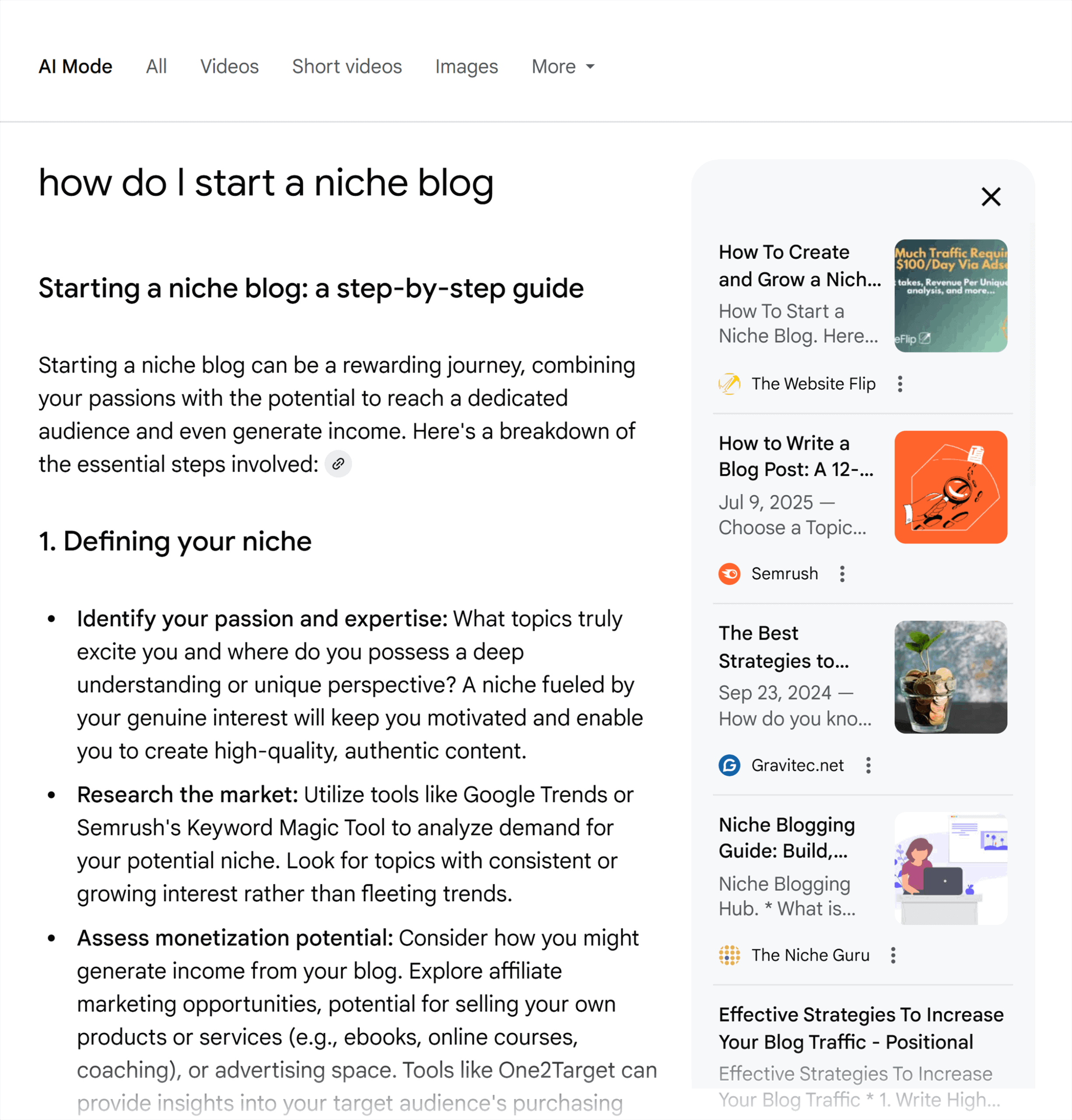
LLMs allow searchers to bypass Google and other search engines entirely.
They provide product recommendations, summaries, answers … you name it.
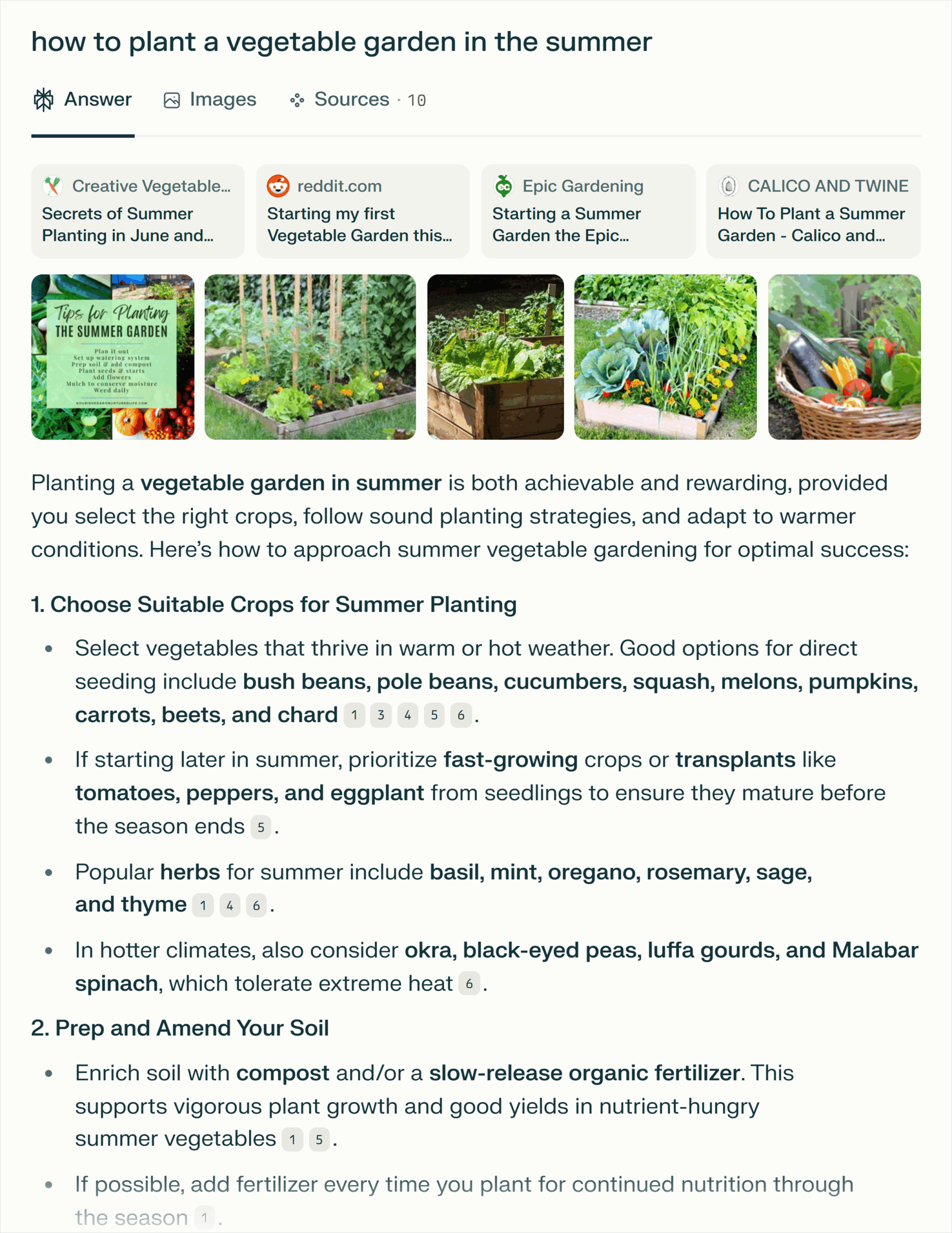
For many site owners, this is resulting in a noticeable decline in traffic.
So, what’s the answer?
Becoming the answer.
When LLMs cite your brand, you become part of the conversation.
Which helps your brand stay top of mind, even without the click.
2. Authority by Association
One of the biggest wins of LLM seeding? Instant credibility.
When large language models mention your brand alongside industry leaders, it boosts your authority.
Case in point: I asked ChatGPT to recommend products for dogs with leaky gut.
It suggested Purina and Zesty Paws, two huge brands.
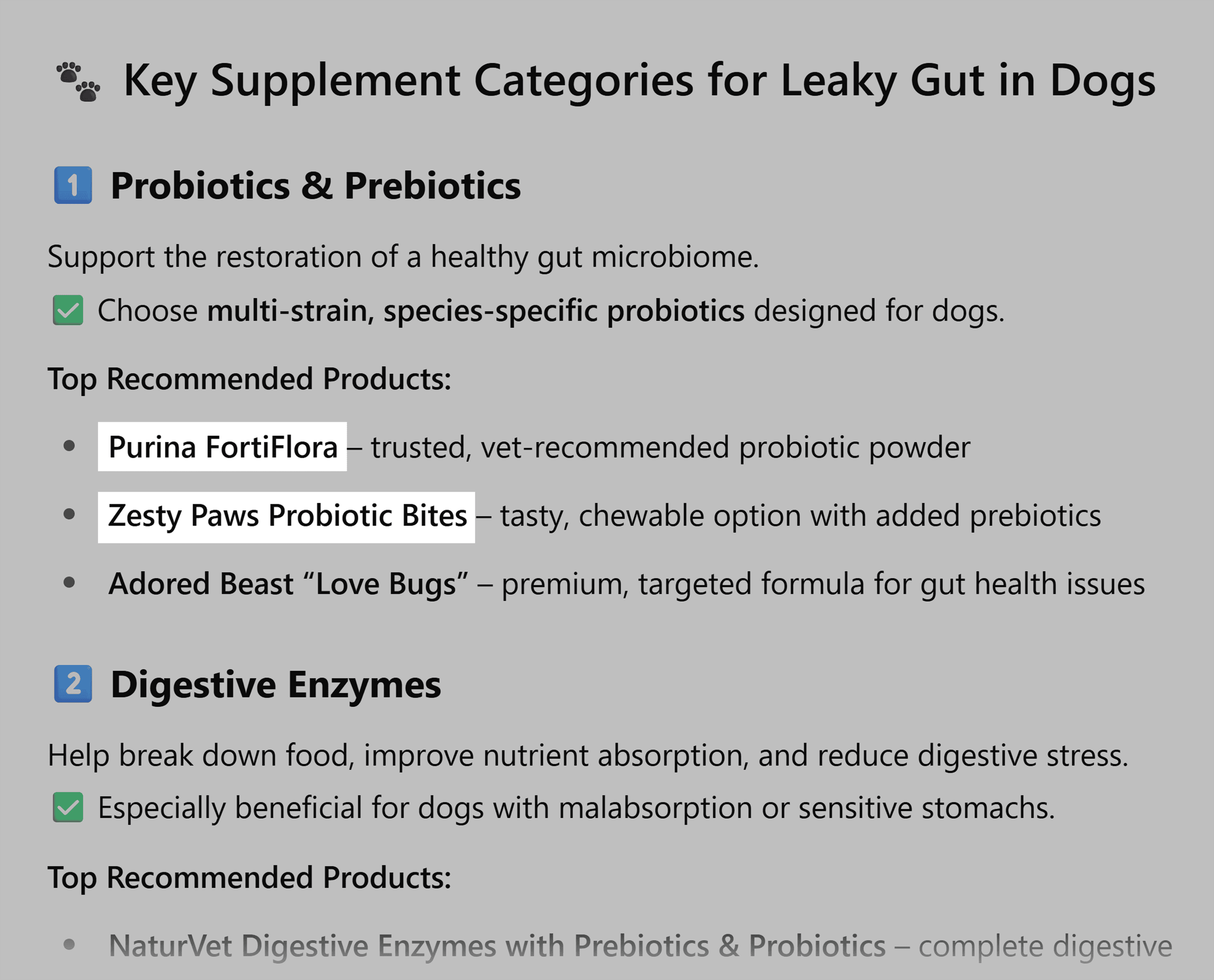
But it also recommended Adored Beast, a much lesser-known pet brand.

That’s the beauty of LLM seeding.
You don’t need a massive budget or a #1 ranking.
You just need to publish content that LLMs want to cite.
3. Leveled Playing Field
In traditional search, the highest-ranking content wins.
But LLMs work differently.
They prioritize the best answers, no matter what page they’re on.
In fact, almost 90% of ChatGPT citations come from positions 21+, according to Semrush’s study.
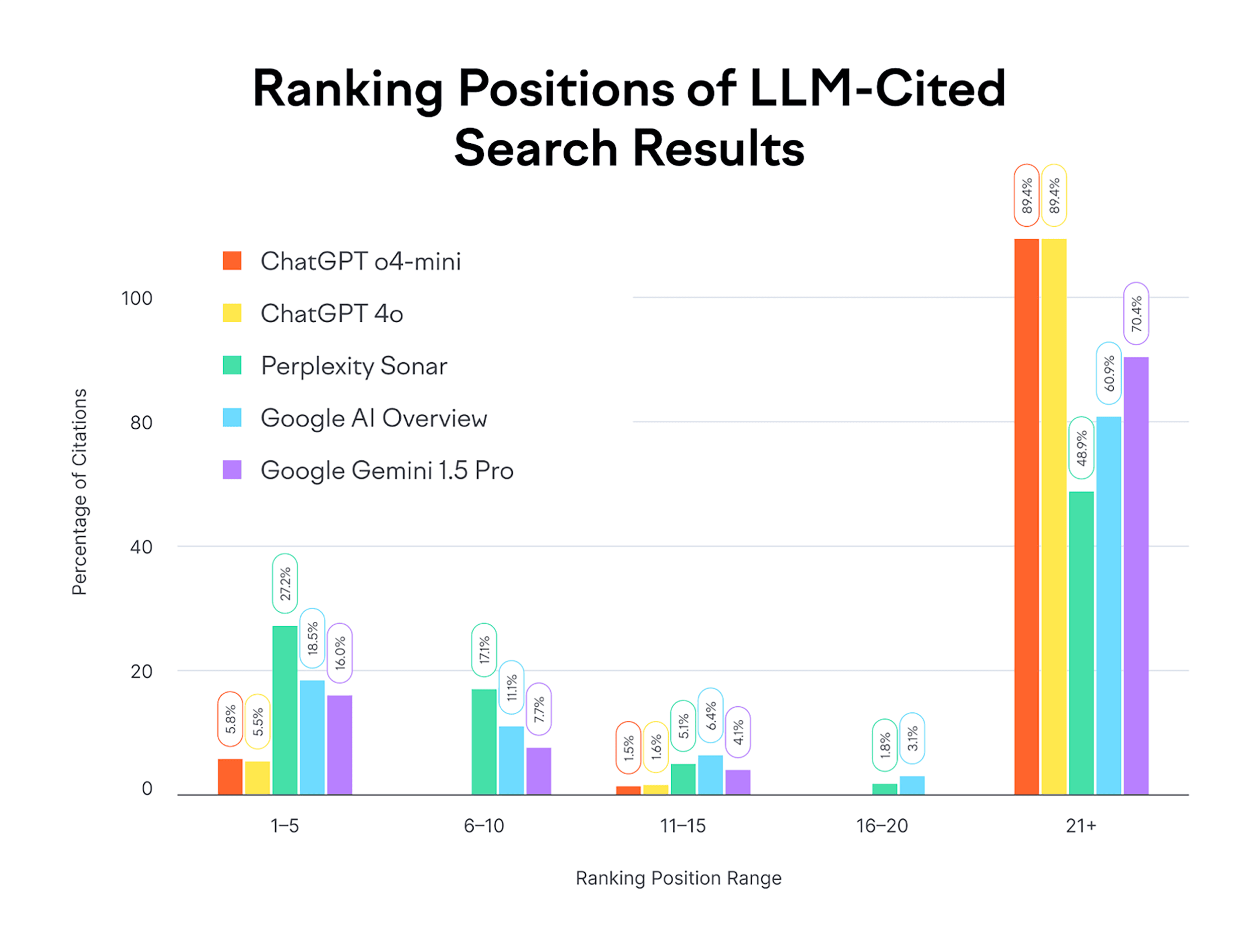
So, your comparison post on page 4 could get cited more than a competitor ranking in Google’s top 5 — if your content provides better answers.
Sounds good? Now, I’ll cover how to create LLM-friendly content.
What to Publish (So You Get Cited by LLMs)
LLMs are citation machines. But they need content from credible sources.
Here are the formats that consistently get picked up:
Structured “Best Of” Lists
Both readers and LLMs appreciate a “best of” list — especially ones with clear structure and useful comparisons.
For example, I asked Perplexity what the best mattresses are for back pain.
And review site Sleep Advisor was one of its sources.
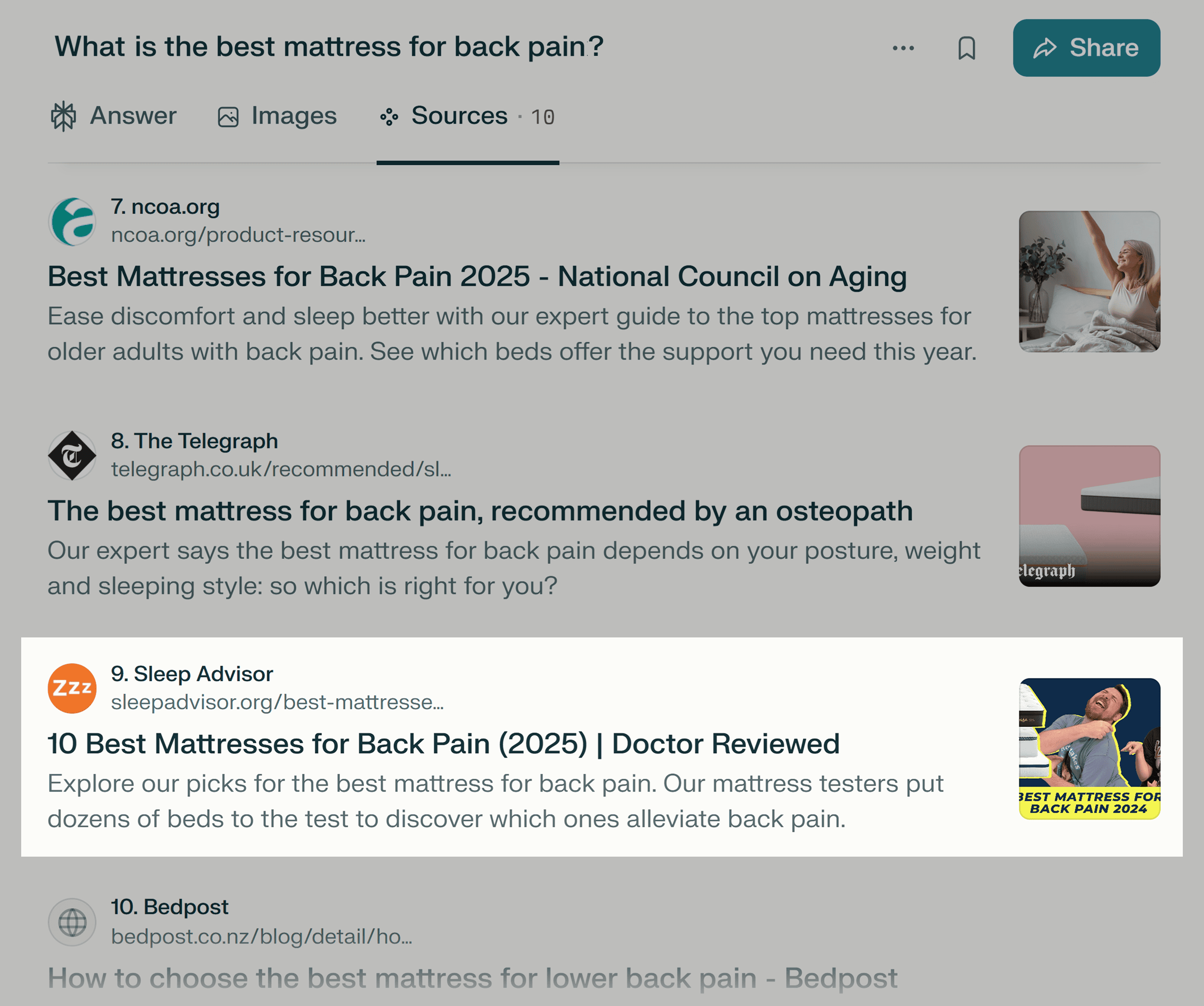
This site publishes “best of” articles often and has a rigorous testing process, two important components of LLM citations.
But to get cited, your list needs to go beyond the basics.
Start by explaining how you selected the items on your list.
LLMs prioritize content that shows transparent, well-reasoned decision-making. (Just like your readers do.)
This added context also helps LLMs match your content to the questions people are asking.
Sleep Advisor includes details about its testing process upfront in articles so readers (and LLMs) can’t miss it.
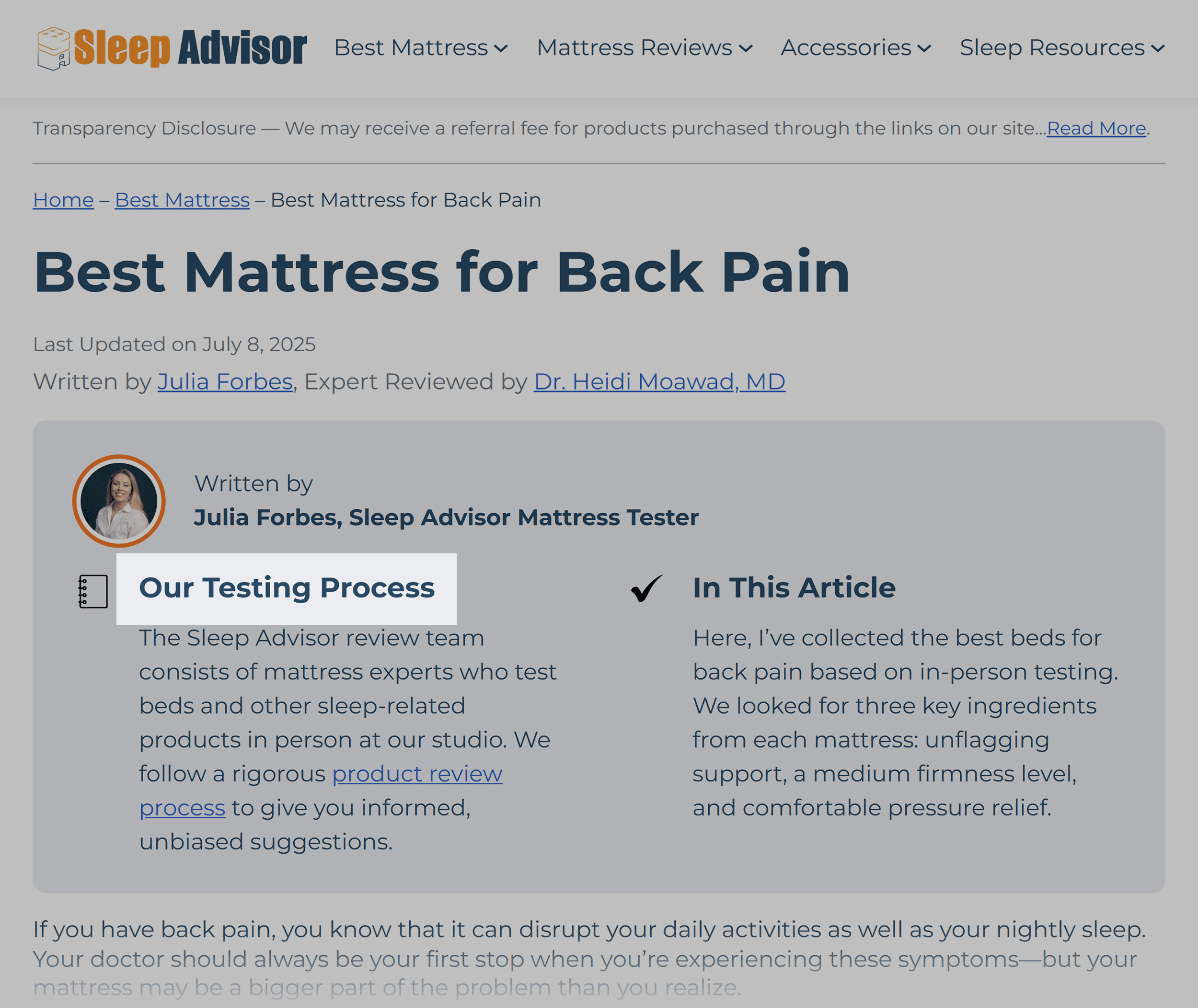
Another AI-friendly component of a “best of” list?
Giving each item a “best” rating that matches search behavior:
- Best for freelancers on a budget
- Best for advanced analytics
- Best all-in-one solution for remote teams
If you’ve used LLMs, you know they quote these phrases in responses.
But it also helps users self-identify, which can increase leads and conversions.
For instance, Sleep Advisor awards mattresses with targeted “best” ratings.
Like “best mattress for upper back pain” and “best mattress for stomach sleepers with back pain.”
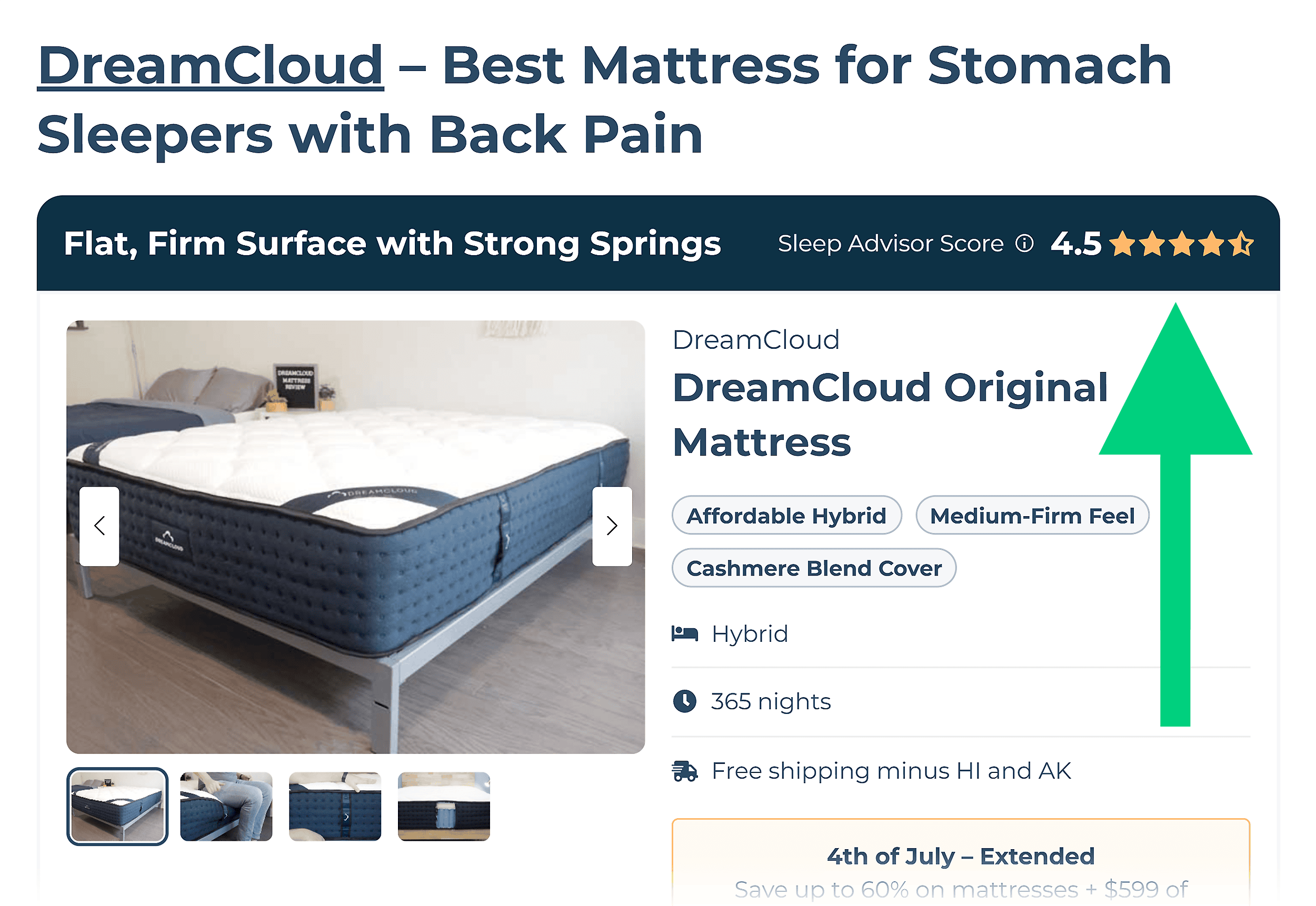
Now, consider your content’s structure.
This is where semantic chunking comes in.
Semantic chunking means organizing your content into short, clearly labeled sections that focus on a single idea or answer.
Why does it matter?
Chunked content with natural language headers makes it easier for AI to parse, understand, and pull relevant snippets into responses.
Use the same layout for every entry. A repeatable structure signals credibility and makes your content easier to extract and cite.
For example:
- Item name + best rating
- Quick summary
- Key features or standout capabilities
- Pros and cons
- Pricing
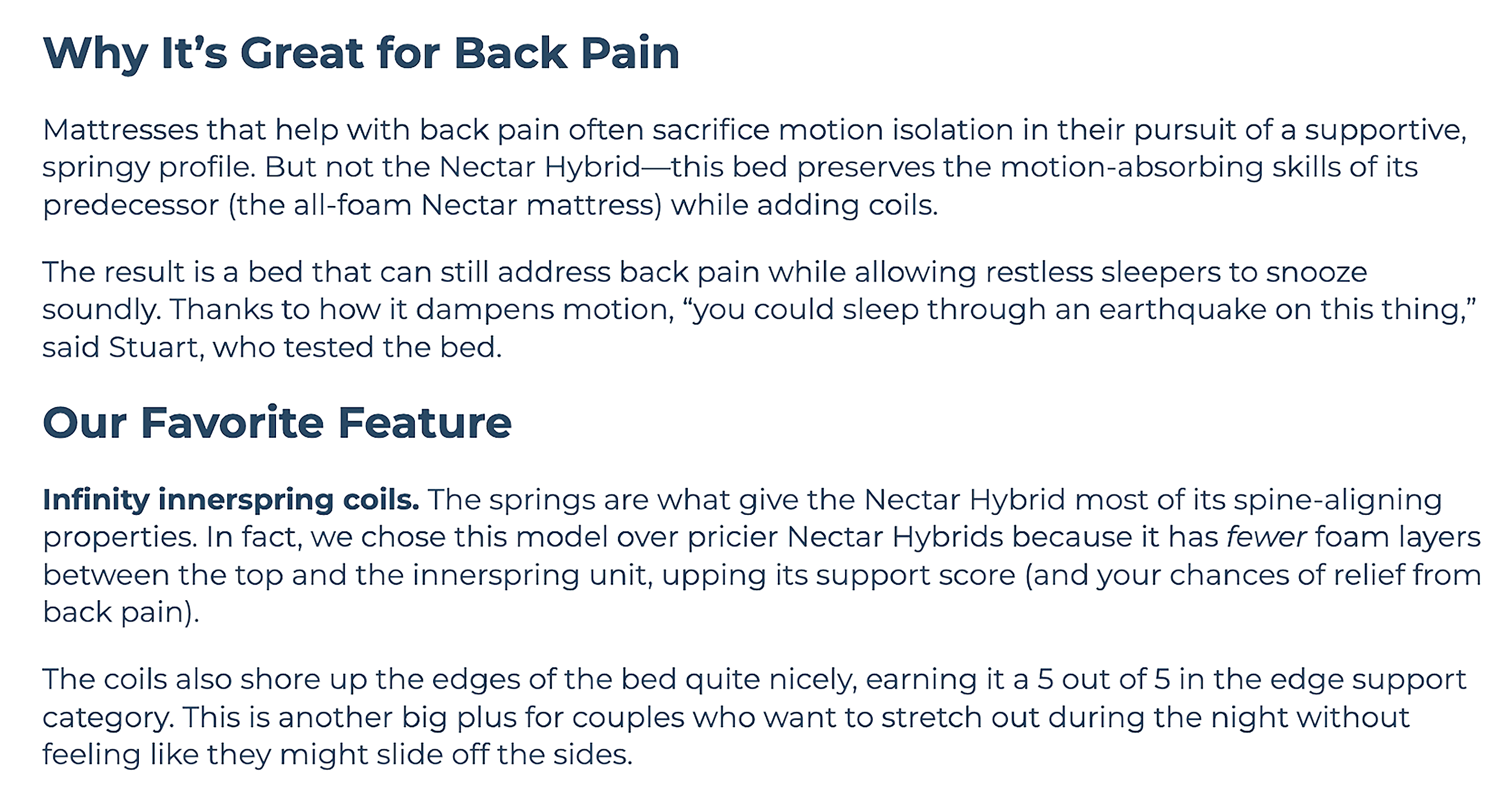
Take it even further by adding scoring systems or ratings.
Sleep Advisor awards a 1-to-5-star rating based on hands-on testing across categories like pressure relief, motion isolation, cooling, and responsiveness.
That kind of structured, criteria-based scoring makes your content more credible … and easier for LLMs to cite.
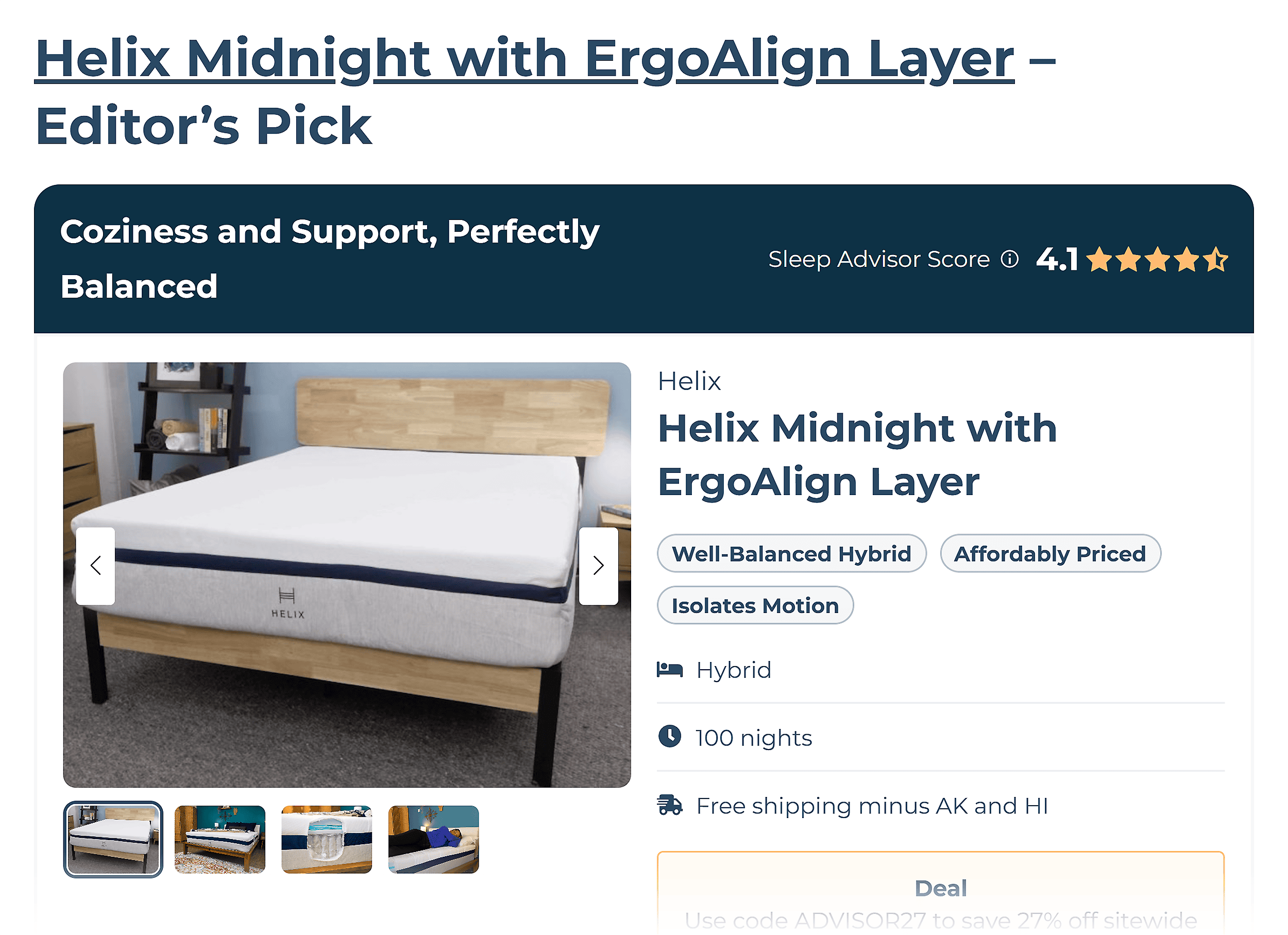
Overall, anything that makes your content easier to skim and read will also help make it LLM-friendly.
This includes bullet lists, tables, and summary boxes.
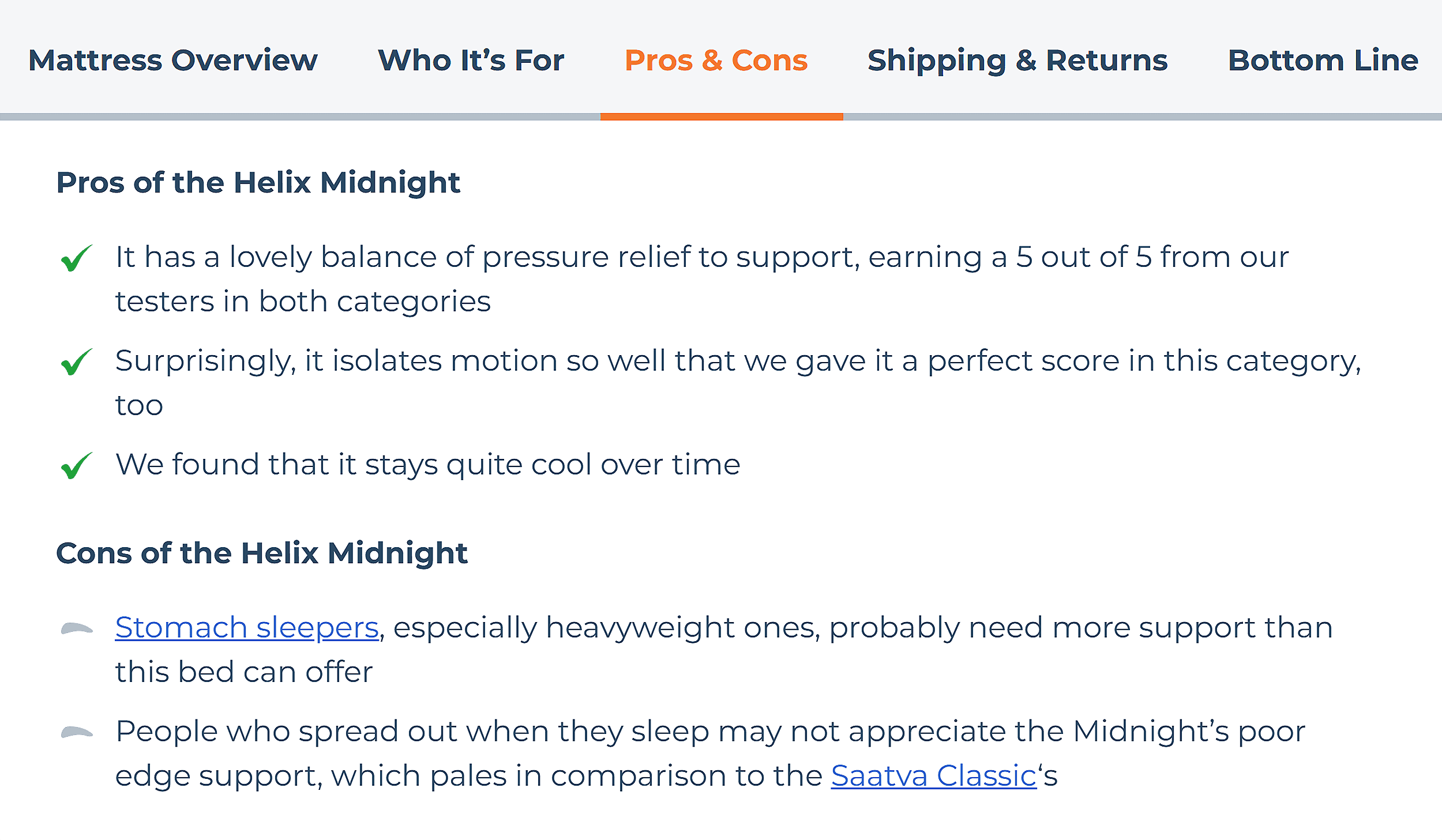
First-Person Product Reviews
Authentic, hands-on reviews are another format LLMs tend to favor.
Why?
Because real testing equals real credibility.
LLMs surface these types of reviews because they:
- Include measurable outcomes
- Follow repeatable testing processes
- Use specific, quotable phrasing
Let’s look at Wirecutter’s electric standing desk review, for example.
They have a “Why you should trust us section” that states they’ve tested 40+ adjustable desks since 2013.
This is a clear, measurable signal of expertise.
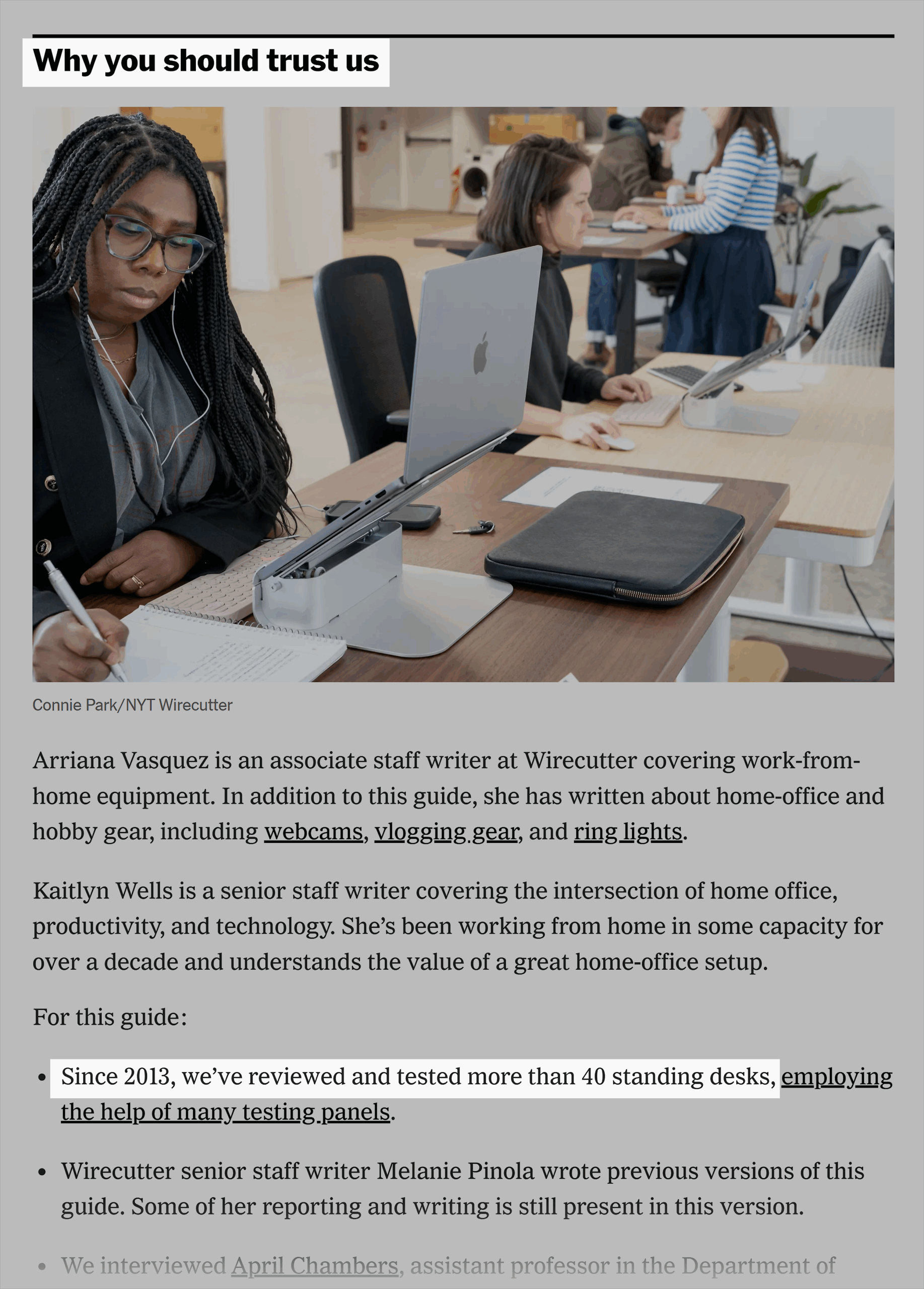
So, get granular and provide all your testing details:
- Explain how many items you tested
- Describe who did the testing, what their credentials are, and when it was conducted
- Outline your methodology or criteria
This shows LLMs and your audience that your review is authentic.
Short, declarative lines are also important to include because they’re extract-friendly.
Here’s an example from the Wirecutter article:
The Branch Duo Standing Desk is a good option if you have limited space or are over 5-foot-8. But it doesn’t offer nearly as many customizable features as the Uplift, and there’s no option to upgrade to an advanced keypad.
Did you notice it includes both positives and negatives?
Balanced statements show you’re giving a fair, experience-based evaluation, not a sales pitch.
That kind of transparency helps establish trust with users and LLMs.
Comparison Tables (Especially Brand vs. Brand)
Mid-funnel users use AI platforms to help make purchasing decisions.
This is why it’s crucial to create content that compares your product to alternatives.
The key?
Present it in a clean, structured format, such as a table or chart.
Like this Backlinko article that includes a table to help readers choose the best PPC tool for their needs.
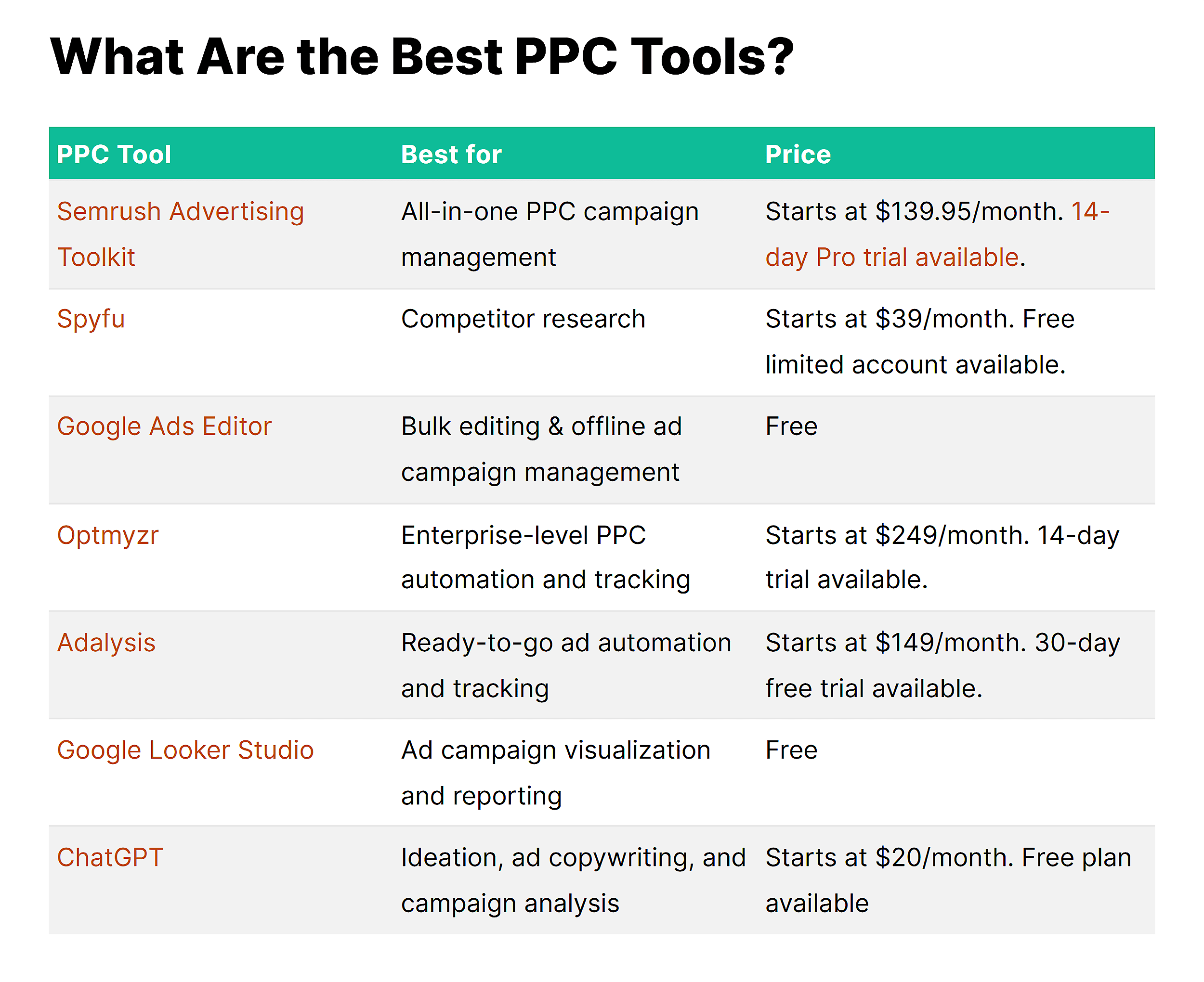
To make your comparison tables citation-worthy, focus on three things:
- Use-case verdicts: Don’t just compare features. Tell readers which option is better for freelancers, agencies, enterprise teams, and more.
- Highlight tradeoffs: Include both strengths and weaknesses for each option to add credibility
- Citation-ready phrasing: Make each recommendation easy to cite. Instead of “Tool A is more feature-packed,” write “Tool A is the best choice for teams on a budget that need features like multi-user logins and grammar checking.”
This kind of clarity makes it easy for LLMs to quote your content when users ask: “Which one is better for [my specific use case]?”
FAQ-Style Content
LLMs are trained on Q&A content from platforms like Quora, Reddit, and other public forums.
So, it’s no surprise that FAQ formats perform well. They match the structure LLMs were built to understand.
For this reason, you’ll want to add FAQ-style posts to your content rotation.
You can identify customer questions in the following ways:
- Customer support tickets
- Live chat logs
- Reddit threads
- Keyword research tools
- Quora discussions
- People Also Ask
- Please Also Search For
- Answer the Public
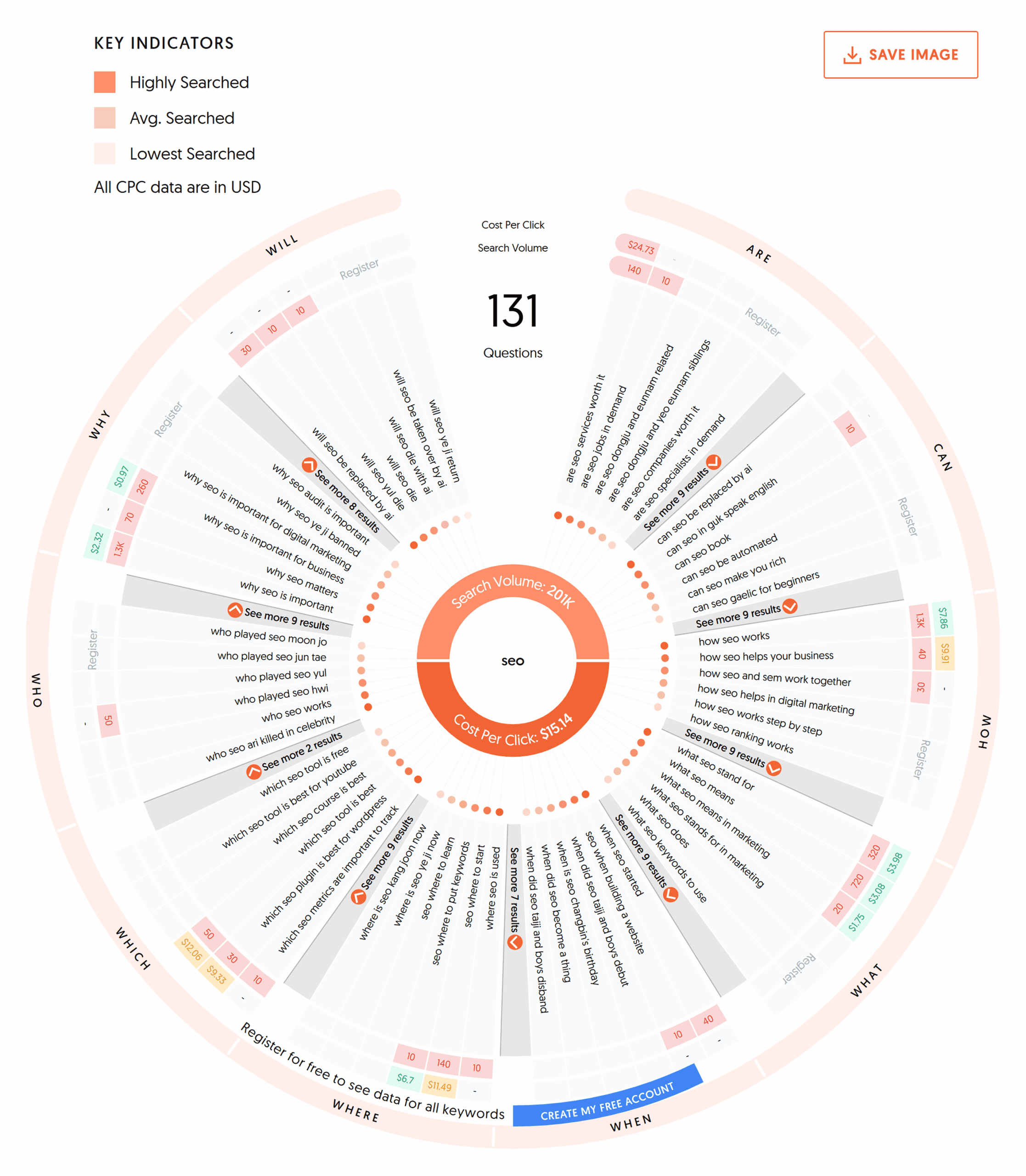
Once you’ve chosen your questions, structure them as subheadings in your article.
And write concise responses that start with a direct answer.
Semrush’s SEO FAQ article is a good example of this LLM-friendly format.
It includes questions as clear subheadings, including:
- What Is SEO?
- How Long Does It Take to Rank on Google?
- Why Has My Organic Traffic Dropped?
This is the type of post that probably wouldn’t rank super well in Google.
But is EXACTLY what LLMs use to train on.
Importantly, the content provides clear, direct answers to the questions.
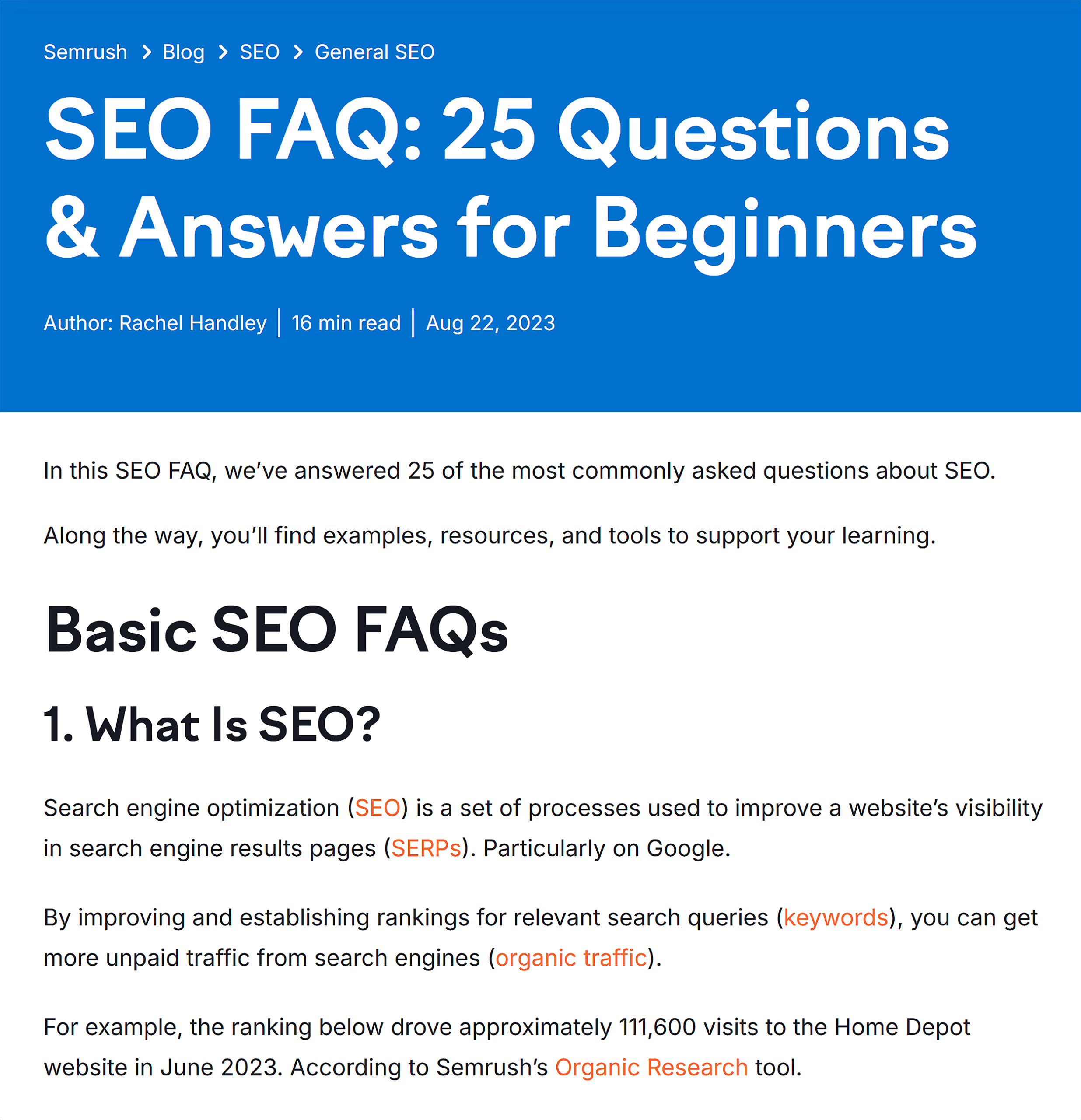
Adding structured data is another smart way to help AI search engines and LLMs better parse and interpret your content.
WordPress plugins like RankMath and Yoast can automatically add FAQPage structured data to help increase your citations.
Opinion‑Led Pieces with Clear Takeaways
Want to increase LLM citations? Come up with a unique take on something in your industry.
This could be a contrarian industry opinion or a surprising prediction — anything works when it’s done well.
The caveat?
You’ll need industry authority, experience, and evidence to support your stance.
But remember — structure matters more than ever before.
Ensure it’s well-structured and easy to summarize.
Otherwise, it’s unlikely to stand out (or get cited).
For example, in a YouTube video (yes, LLMs can pull from video transcripts and descriptions), digital growth marketer Grace Leung challenges outdated content strategies.
She explains why they’re holding brands back and what to do instead.
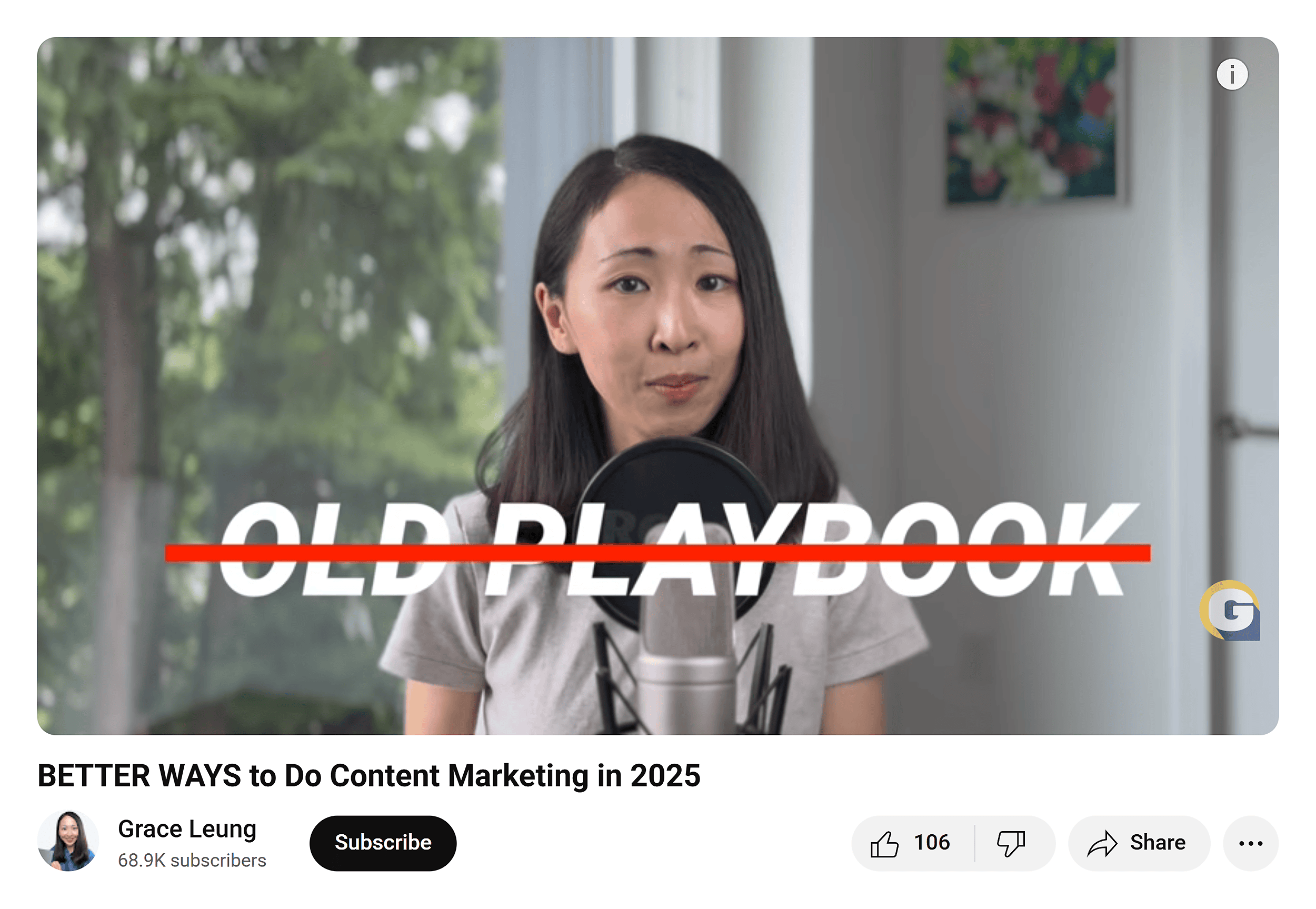
Her format is viewer- and AI-friendly with defined sections and actionable takeaways.
And she shares a strong opinion throughout the piece that is backed up by her expertise.
Want to do the same?
Include details that help LLMs understand and trust your content:
- Author credentials: Briefly explain who you are and why you’re qualified to cover the topic. This adds credibility for both readers and LLMs.
- Content overview: State what the piece covers early on (in your blog post intro or video description) so it’s easy to parse and summarize
- Internal links: Link to related posts or supporting content to signal depth and strengthen your topical coverage
In Grace’s case, her video’s description includes all of the above (and more): a video summary, quick author bio, newsletter link, and related content.
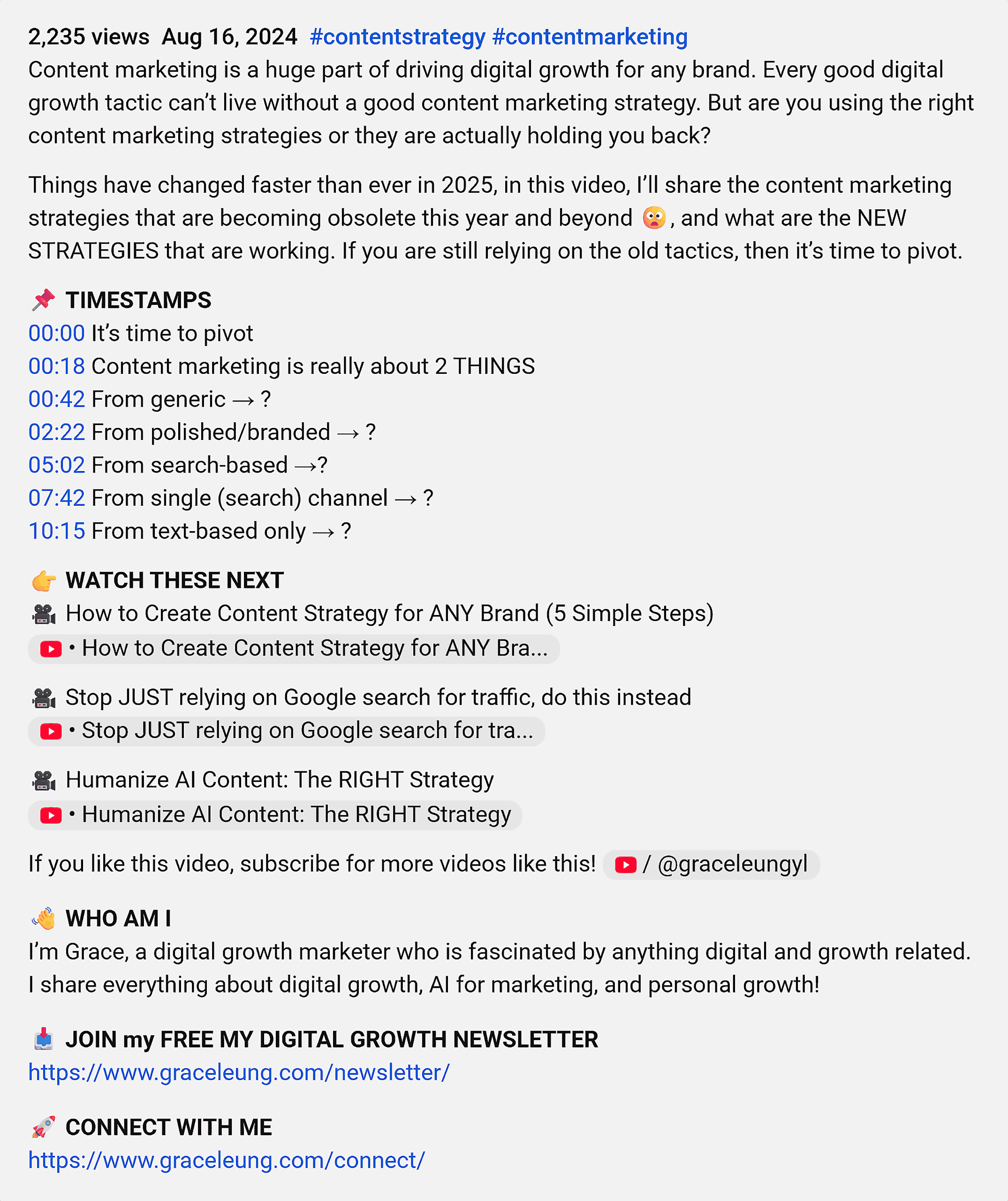
Visuals with Clear Captions and Context
Visual content keeps readers engaged.
But it’s also another way to give LLMs more context about your content.
Make your visuals LLM-friendly with these tips:
- Write full-sentence captions that explain what’s pictured and why it matters. Think: “Peach cobbler cookie from Good Cakes and Bakes, one of Detroit’s most beloved bakeries,” not just “Cookies on a plate.”
- Reference visuals directly in your copy. Instead of skipping over an image, say, “As you can see in the photo, this bakery’s seasonal peach cobbler cookies are a local favorite.”
- Add alt text that reflects both the subject and its importance. Try: “Peach cobbler cookie at Good Cakes and Bakes, a popular Detroit bakery known for seasonal desserts.”
- Use descriptive file names, like detroit-good-cakes-peach-cookie.jpg, to reinforce meaning for AI crawlers.

Tools, Templates, and Frameworks
Offer valuable resources that solve real problems to get referenced in LLM conversations.
For instance, I asked Perplexity how I can check keyword rankings for free.
And it recommended Backlinko’s free Google Keyword Rank Checker.
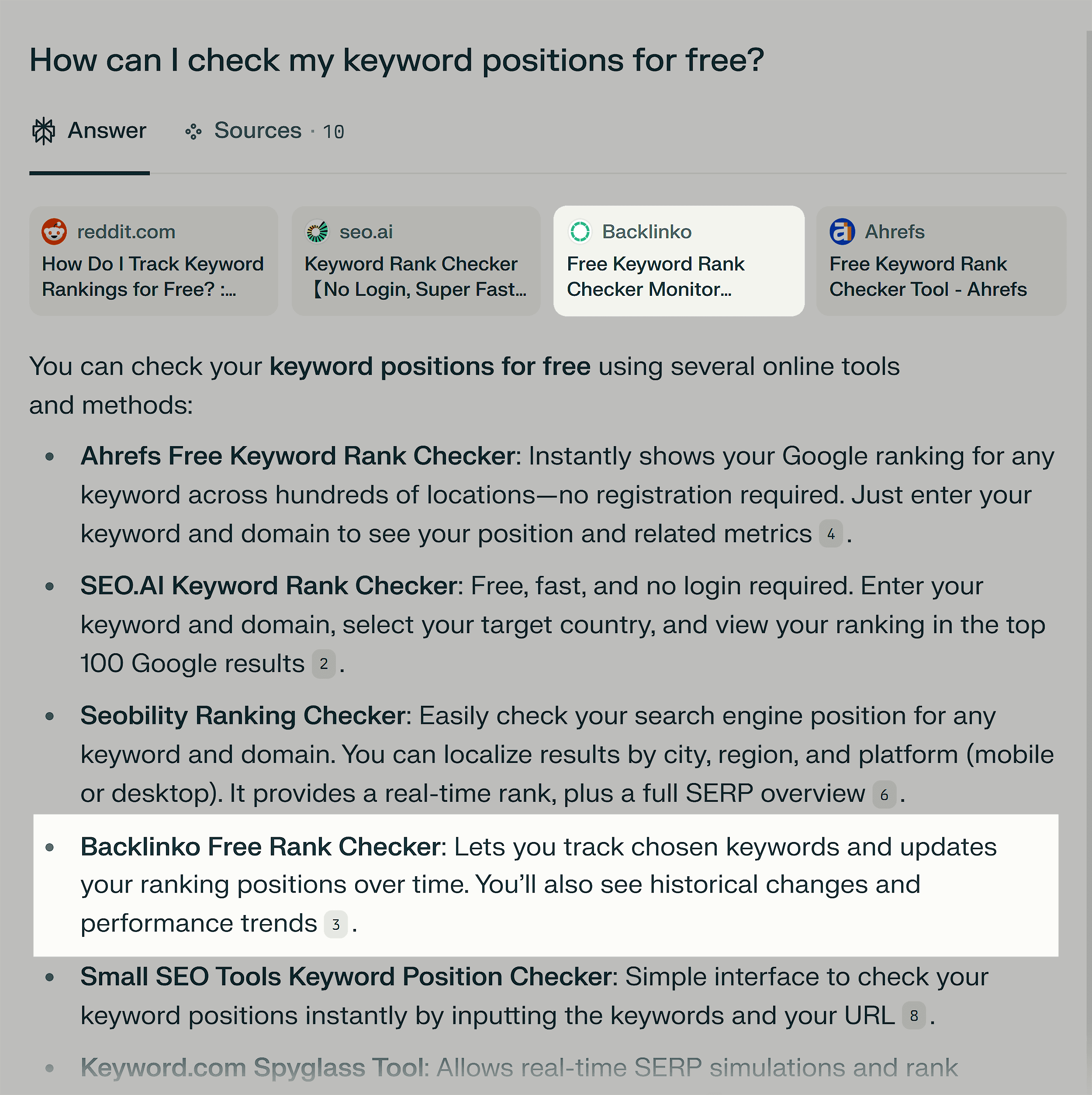
Depending on your industry, you might create free templates, frameworks, calculators, or interactive tools.
To make your resource citation-worthy, give it a clear, descriptive title that matches how users search.
Like “Budget Calculator for Freelancers” and “Free Grammar Checker.”
Include an intro that explains who it’s for, what it does, and how to use it.
Then, add supporting content (like examples, FAQs, or use cases) so LLMs understand its context and value.
The more useful and well-structured your resource is, the more likely it is to earn mentions from your target audience and AI platforms.
For example, our free rank checker lets users check rankings in seconds.
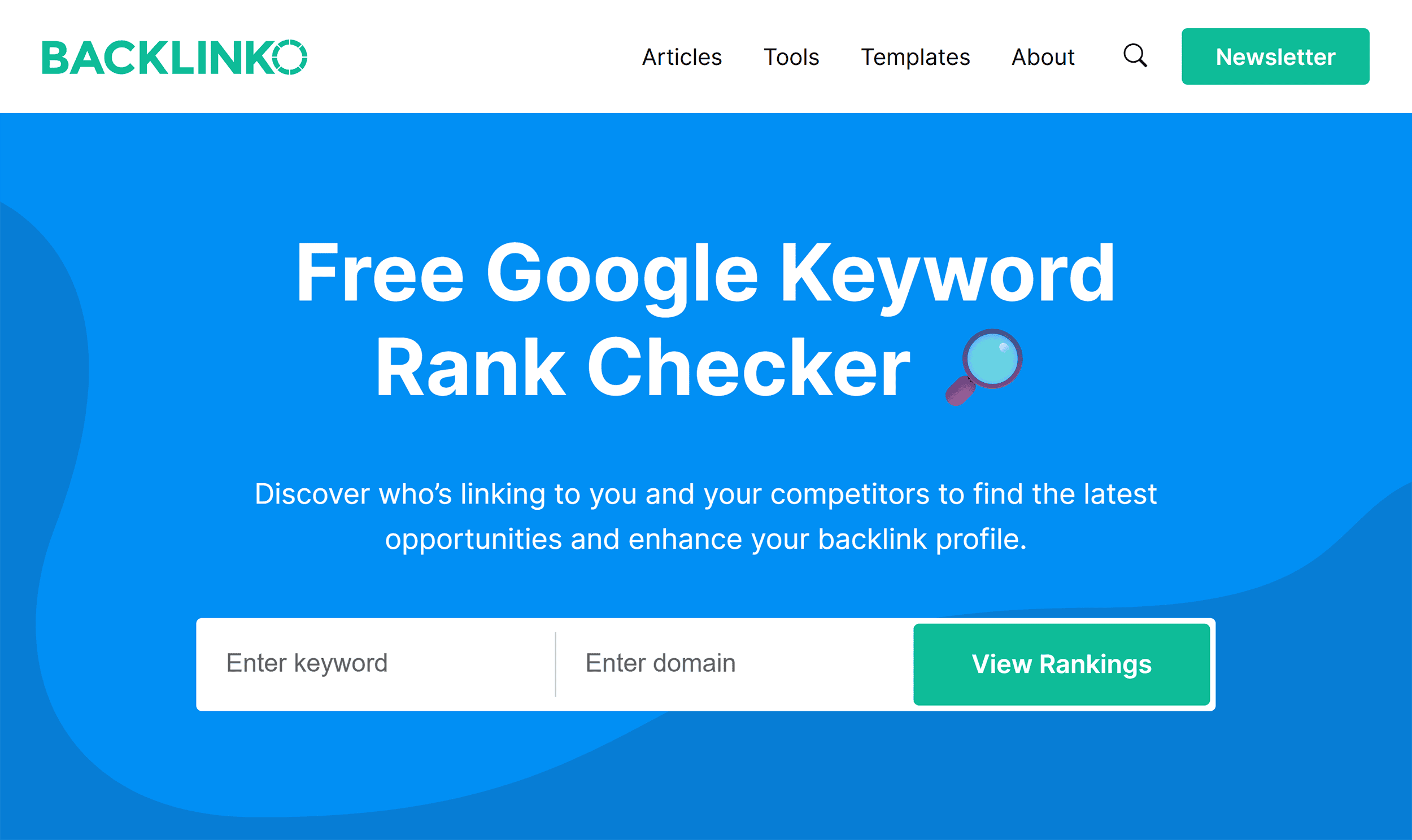
The tool’s design is clean and user-friendly.
And the description sums up the tool’s benefits well, which is important for scraping:
Discover who’s linking to you and your competitors to find the latest opportunities and enhance your backlink profile.
Since the tool is both easy to use and genuinely helpful, it’s recommended by third parties in blogs and forums.
These mentions are vital because LLMs pick up on them when deciding what to cite.
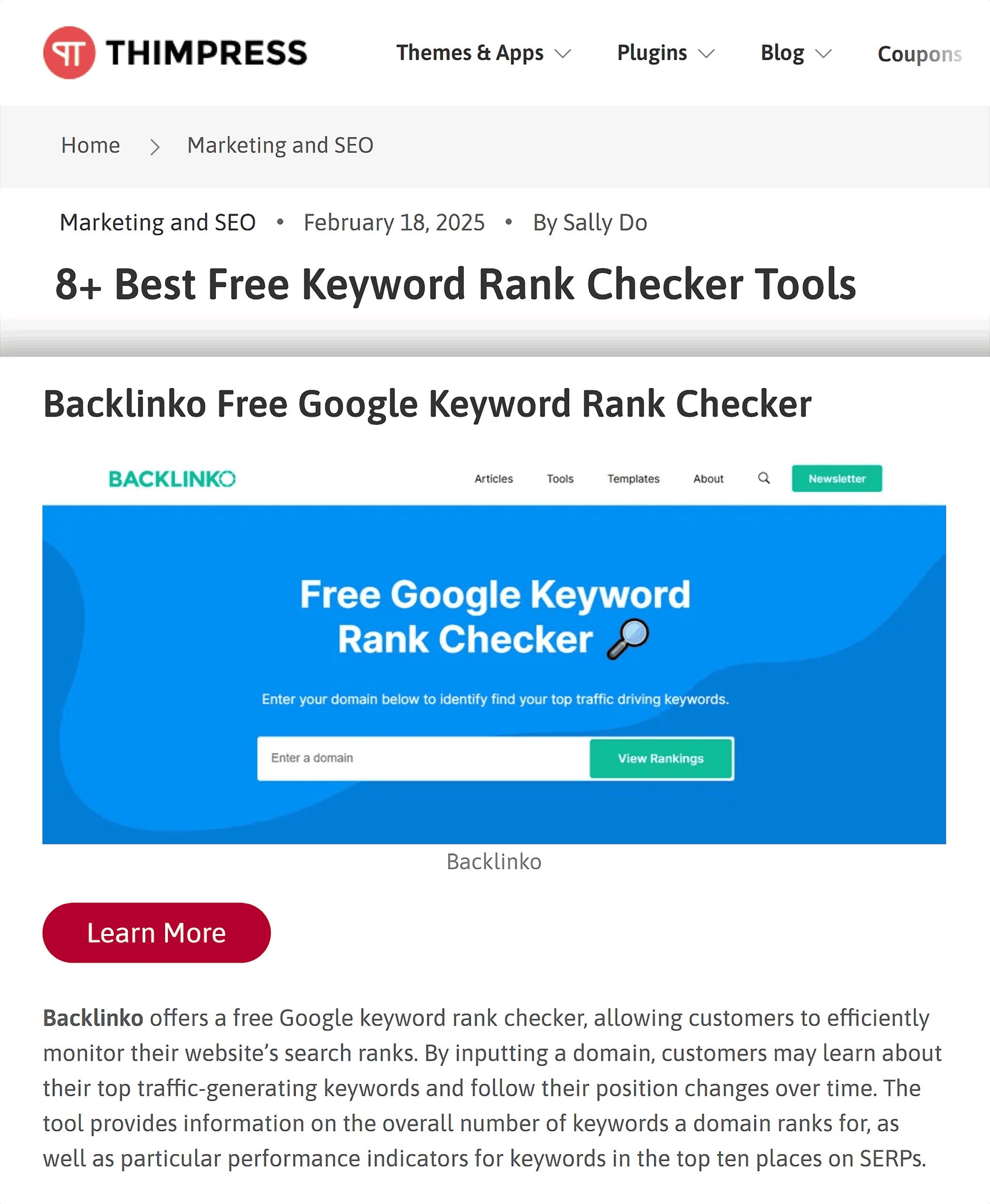
Where to Seed Your Content for Maximum LLM Pickup
Publishing great content is only half the battle.
The other half? Getting it in front of the right crawlers.
Publish in places that LLMs trust, crawl frequently, and find easy to parse.
Here’s where to focus your efforts:
Third-Party Platforms
Certain third-party platforms are LLM magnets.
Why?
Their clean layout, clear headings, and consistent quality make them easy for AI to read and cite.
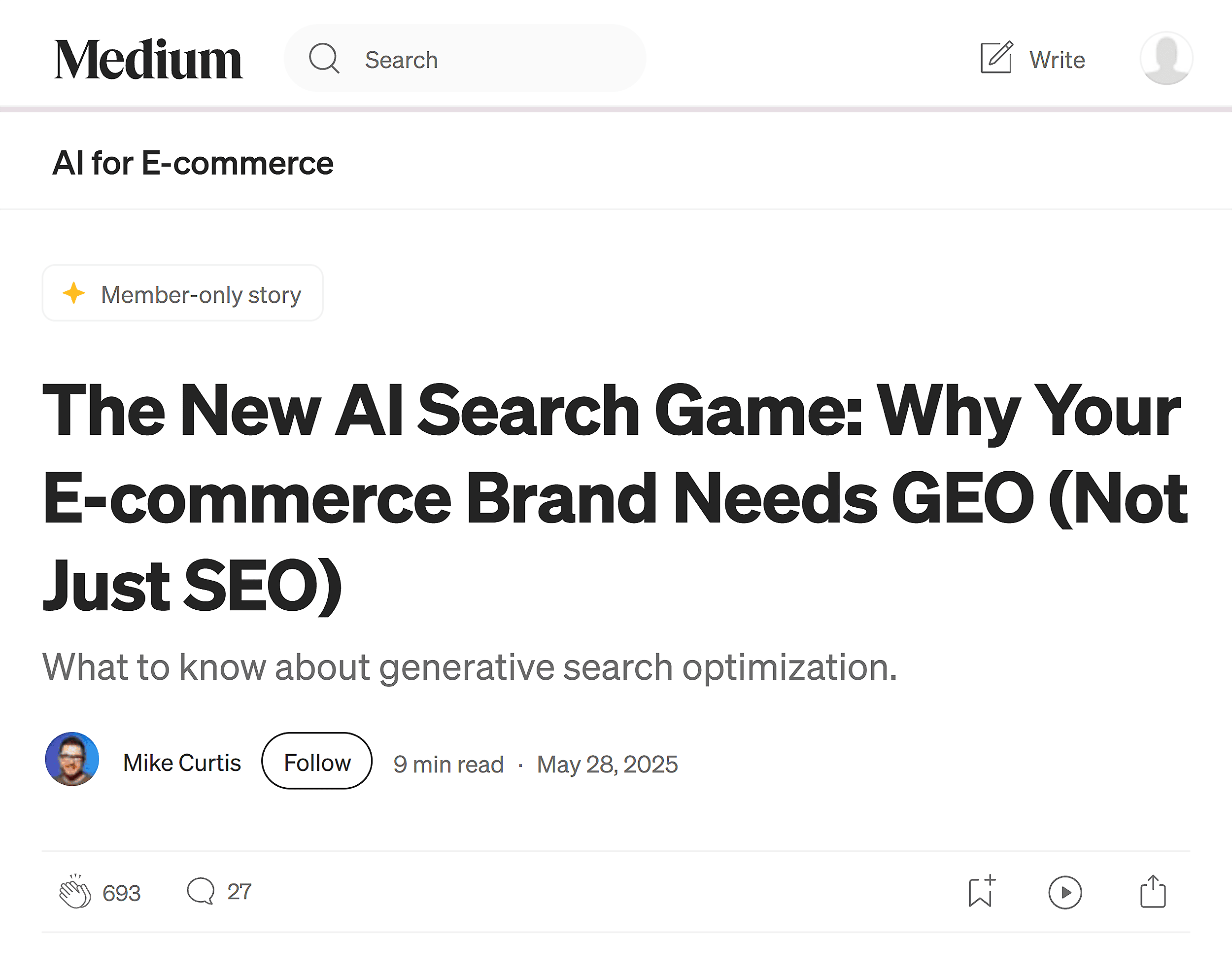
This includes:
- Medium: Repurpose your long-form blog content here. Medium’s minimalist layout and semantic structure make it ideal for LLMs. Include section headers, summaries, and internal links for added context.
- Substack: A great home for newsletter-style content and thought leadership commentary. Its emphasis on editorial voice and topical depth adds authority and makes your content easier for AI to recognize as expert-driven.
- LinkedIn articles: These articles are indexed well and often tied to real profiles (which gives your content a credibility bonus in LLMs)
Trusted Industry Publications
LLMs are more likely to trust and cite content that comes from respected industry sources.
So, create a strategy to share content and quotes in high-impact publications to boost your LLM visibility.
Here’s how:
Create Guest Posts
No, guest posting isn’t dead — it’s just not all about the links anymore.
It’s about visibility.
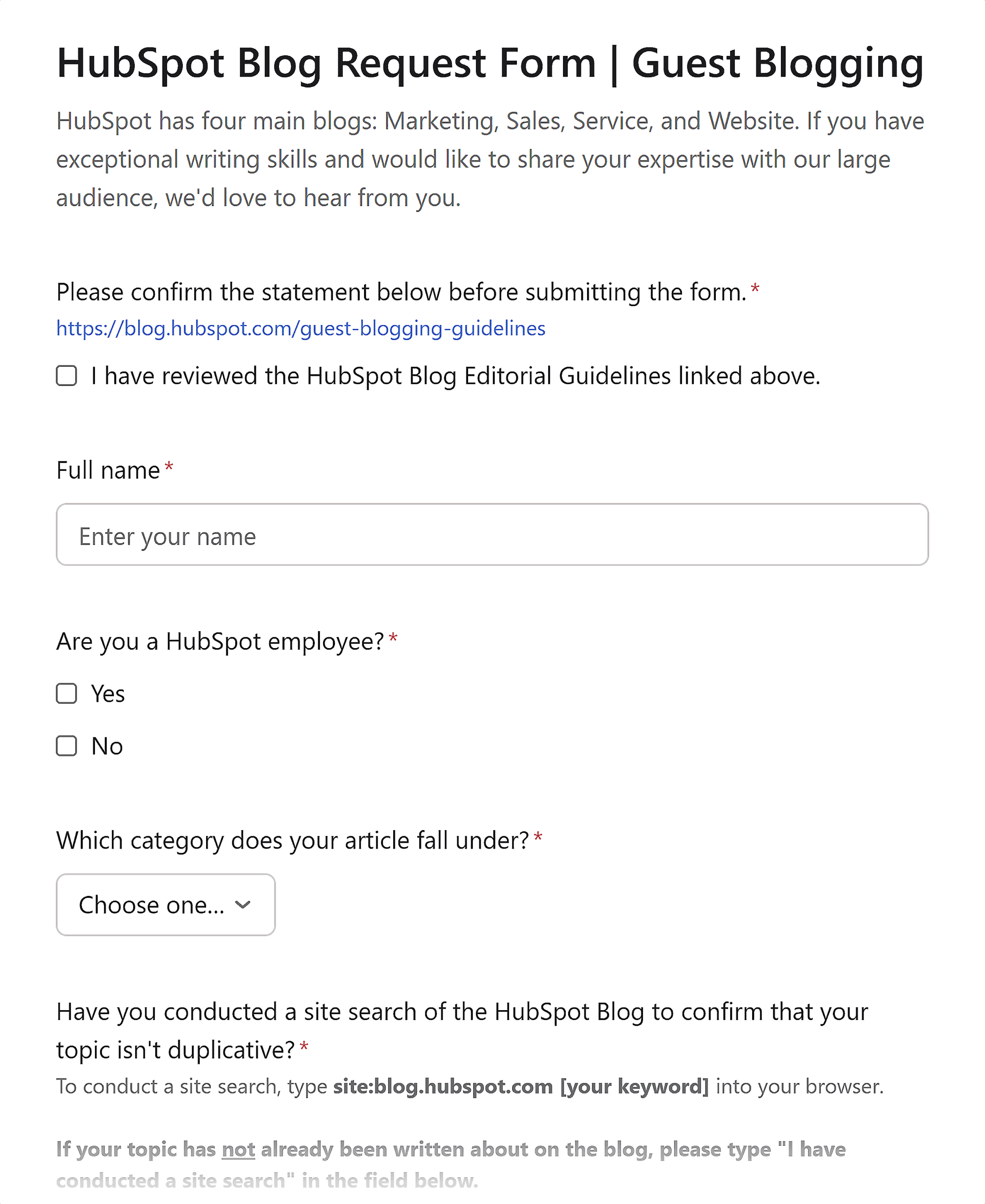
Choose topics that align with popular LLM prompts (like product comparisons, trends, or how-tos).
And format your content clearly with subheads, summaries, and data points.
Offer Expert Quotes
Reach out to journalists, editors, and bloggers in your niche.
Provide non-promotional, insight-driven quotes to increase your chances of being featured in articles that LLMs frequently reference.
Tools like HARO or Featured.com can help you find opportunities to share your expertise.
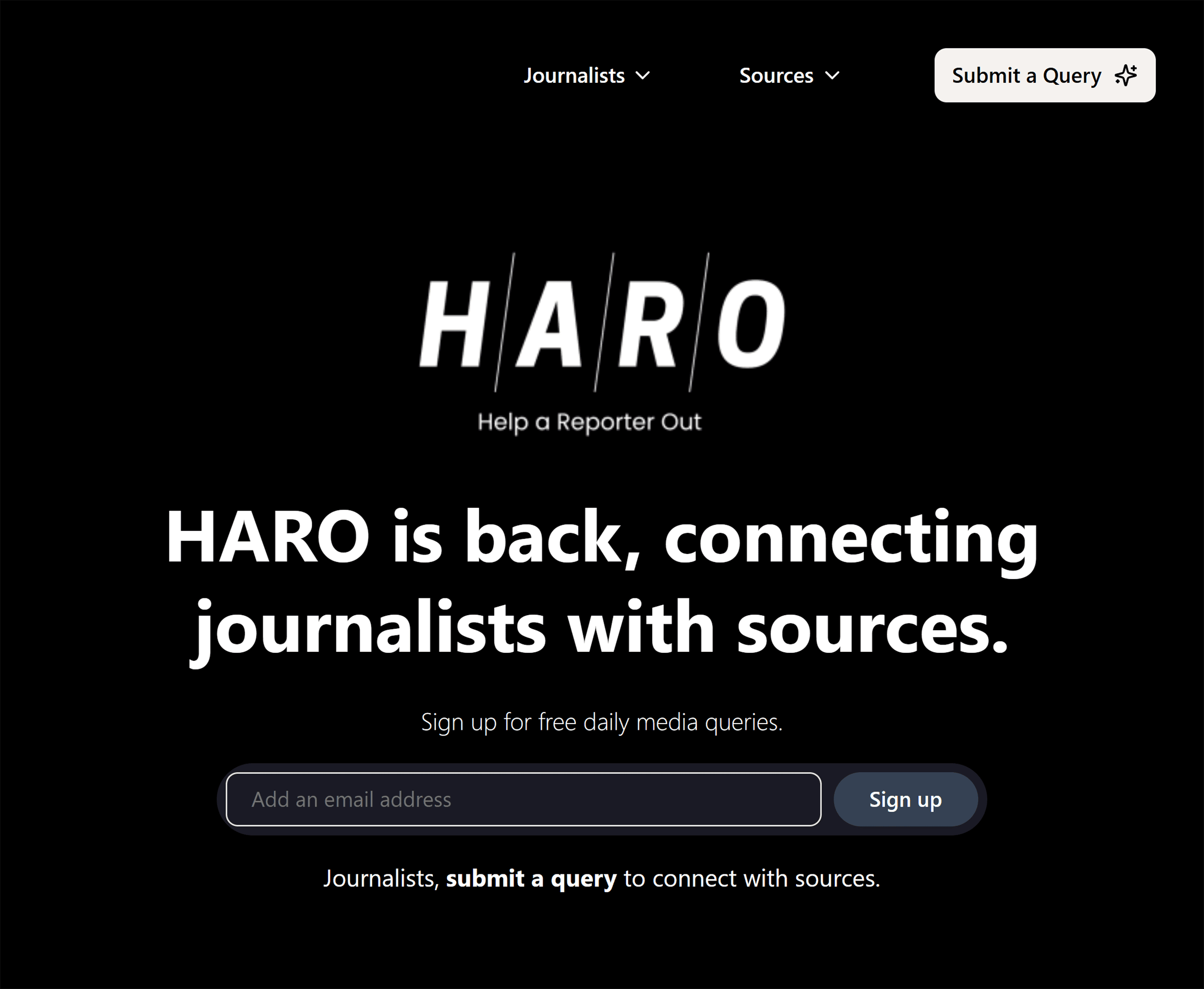
Get Featured in Roundups
As you’ve learned, LLMs love “best of,” “top tools,” and “expert tips” formats.
Pitch to writers creating these lists — whether newsletters, LinkedIn posts, videos, or blog posts.
And make it easy to include your brand by providing a concise, structured blurb with supporting context or proof points.
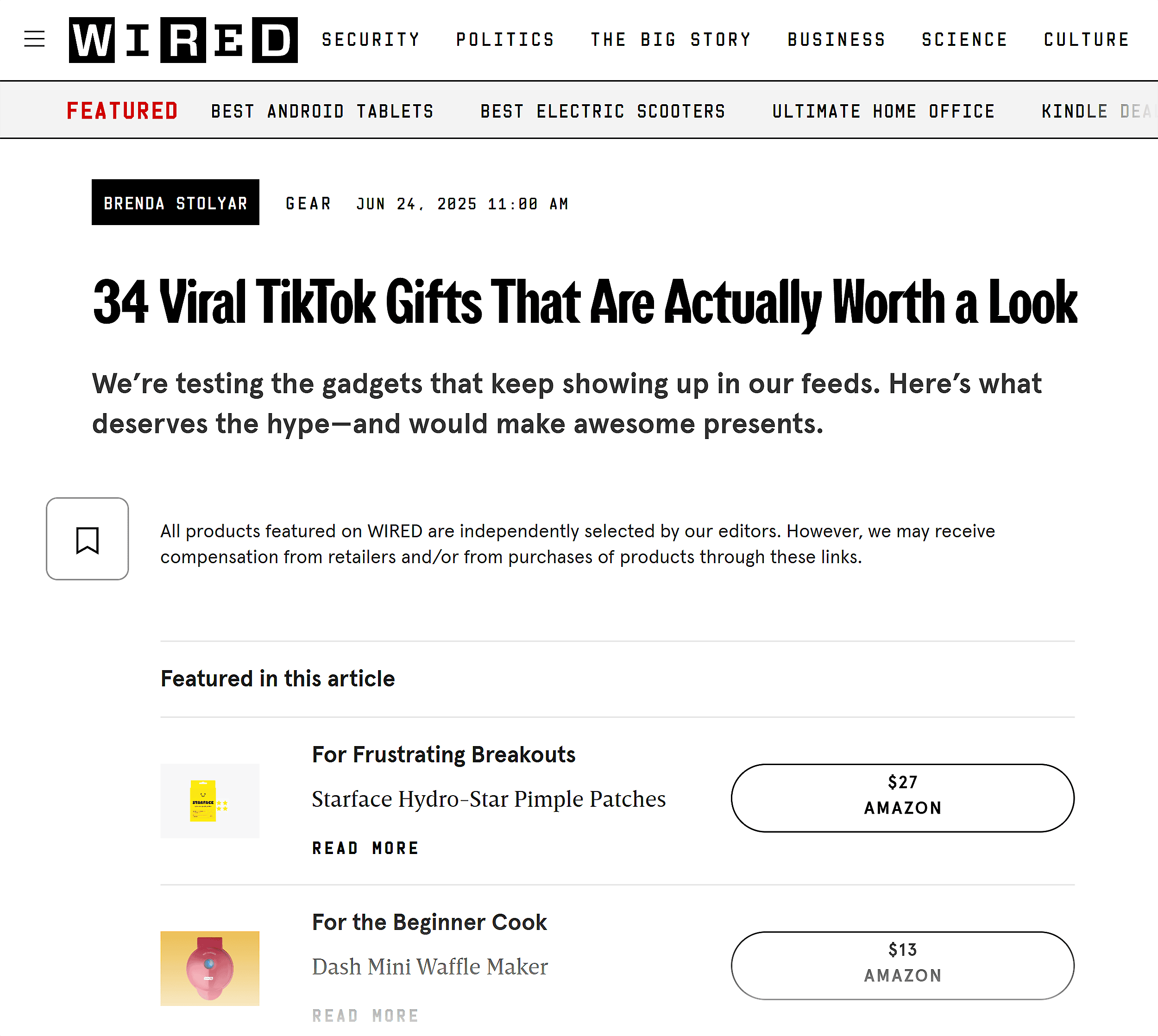
User-Generated Content Hubs
Why do LLMs and AI search engines love user-generated content hubs?
Because they’re full of real people asking real (often long-tail) questions. And subject matter experts providing highly specific, detailed answers.
Ones you often won’t find elsewhere.
That makes these platforms powerful spots to seed your expertise.
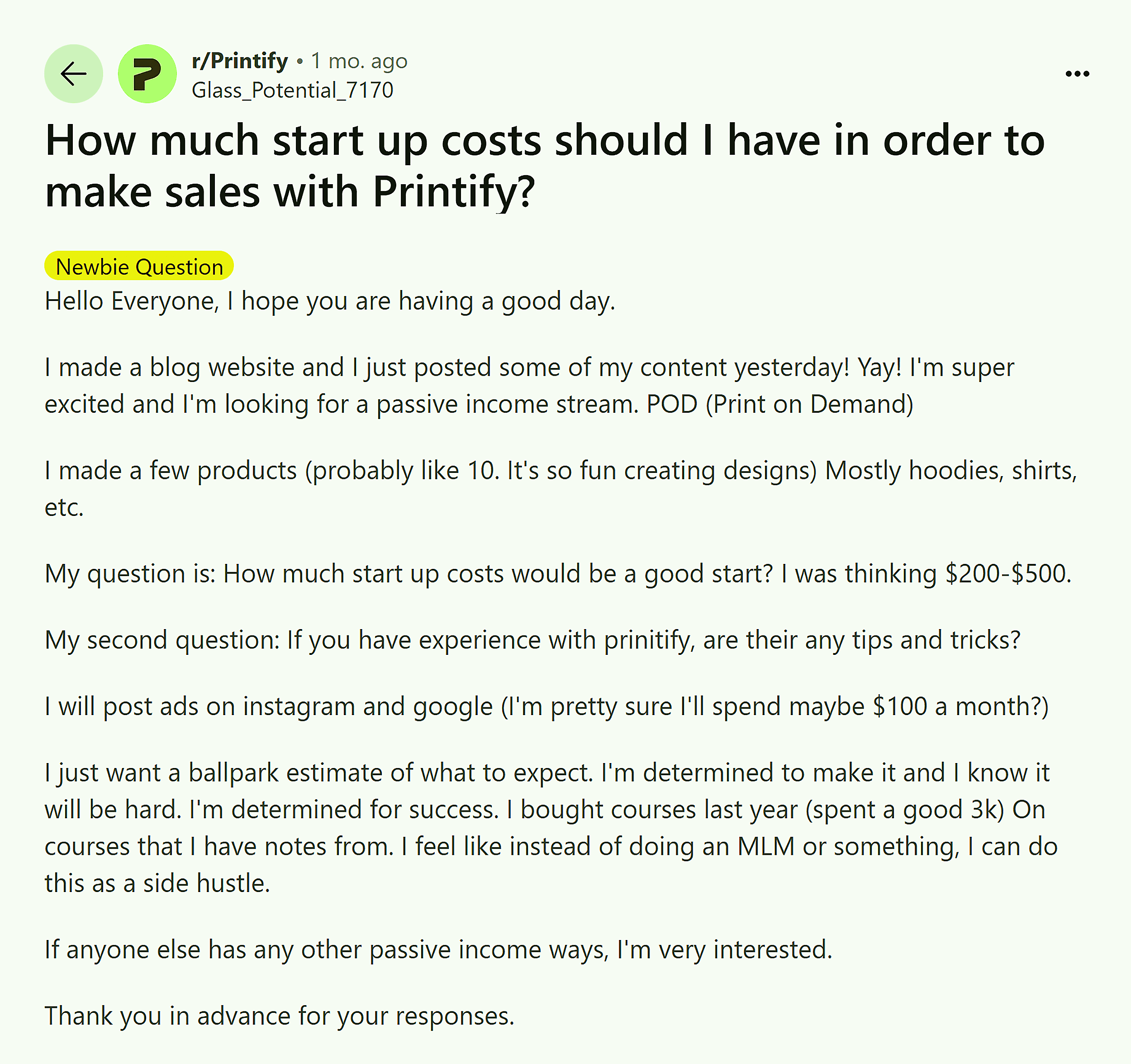
Here’s where to focus:
LLMs cite Reddit more than any other source, according to Semrush.
So, if Reddit wasn’t on your radar before, it should be now.
Participate in relevant subreddits where you can highlight your expertise and add genuine value.
Answer questions and respond to comments.
And then do it all over again.
Make Reddit a part of your regular rotation to boost your chances of LLM citations.
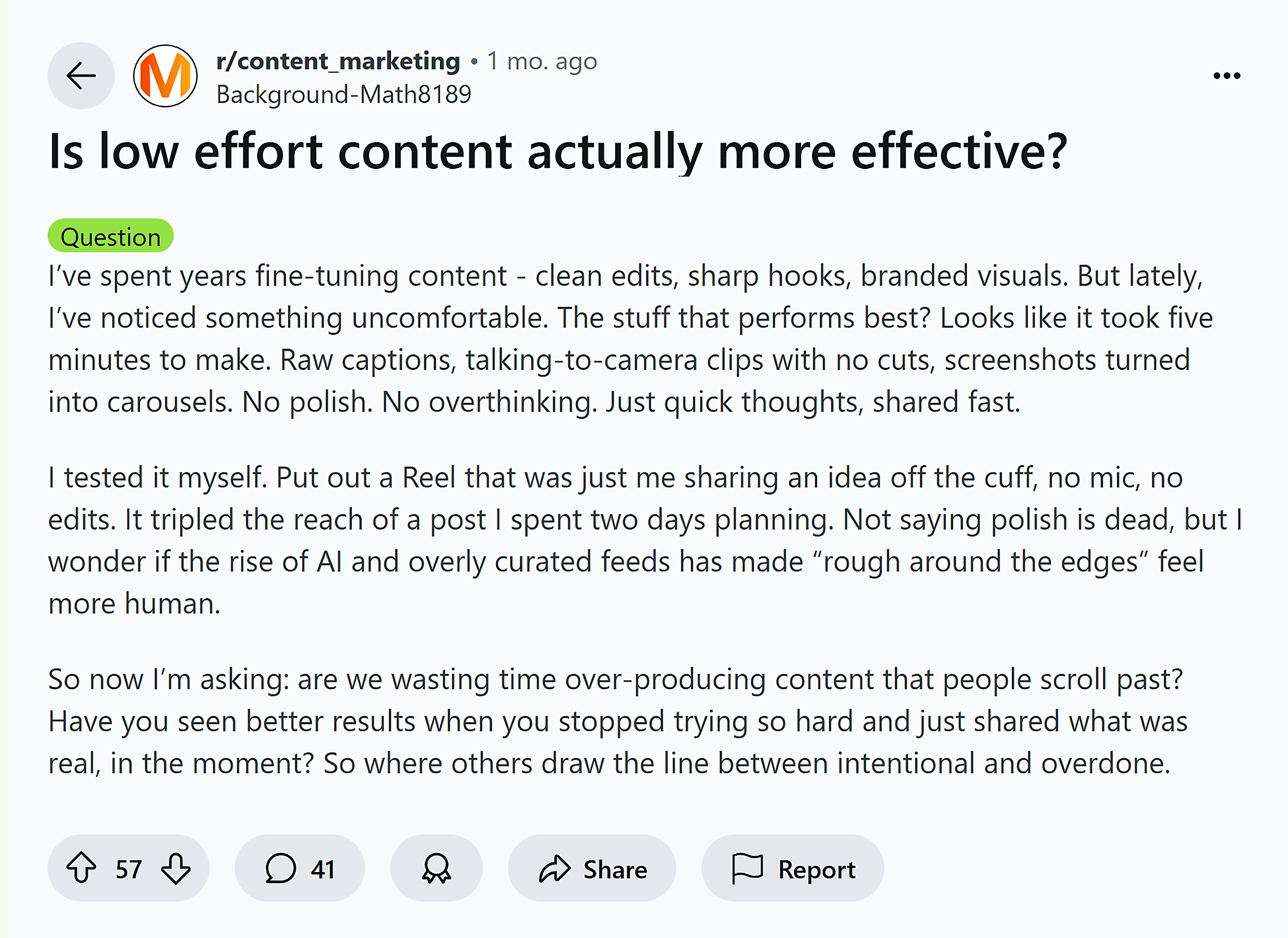
Quora
Reddit may be the darling of LLMs, but Quora isn’t far behind.
For this reason, you’ll want to add this platform into the mix as well.
Side note: Quora is the most commonly cited website in Google’s AI Overviews, according to Semrush’s AI search study.
Provide comprehensive answers to industry questions.
Include specific examples, comparisons, or step-by-step explanations to increase your chances of LLM citations.
But don’t let formatting slide just because you’re on an informal platform.
Add clear headlines, subheads, and bullet points to increase your chances of LLM scraping.
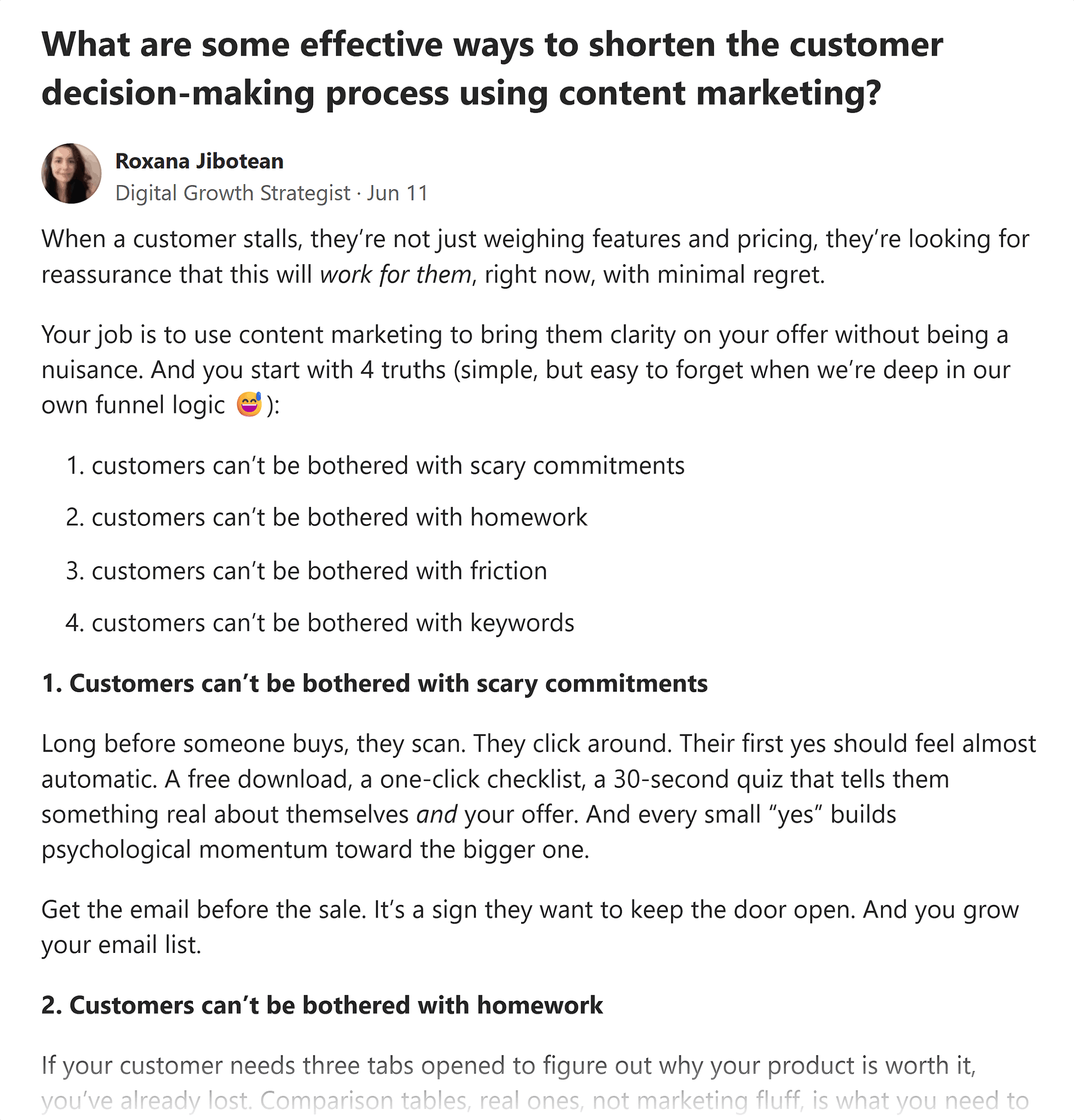
GitHub Discussions
Have a technical brand?
Get involved in community discussions beyond your product.
Share helpful bug fixes, answer questions, and offer support.
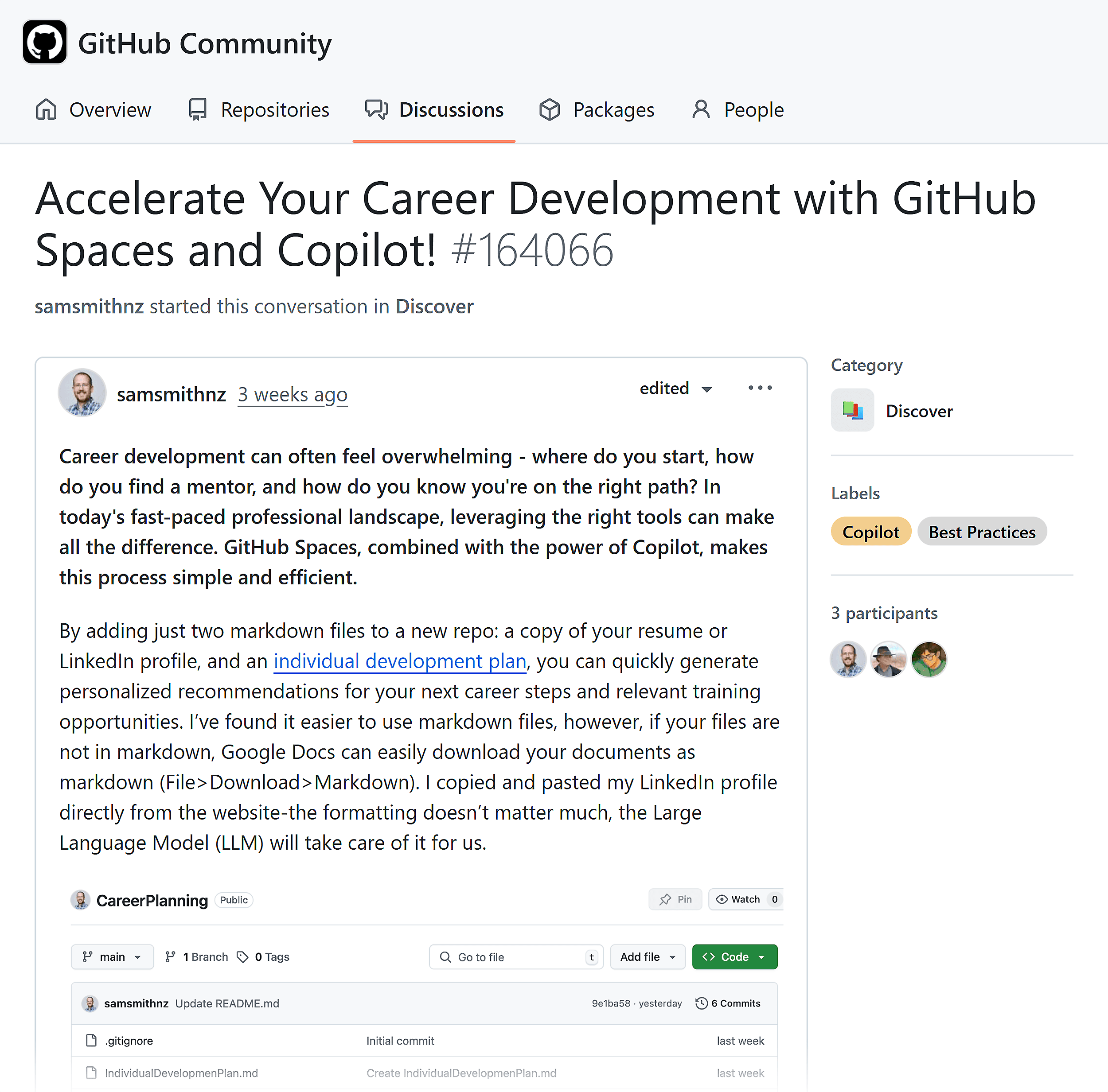
Building credibility makes it easier to reference your tool or solution when it’s genuinely relevant.
Niche Forums and Public Facebook Groups
Don’t overlook specialized communities.
LLMs scan niche forums and public Facebook groups for in-depth, experience-based insights.
Look for active, topic-specific forums like:
- ContractorTalk: Home improvement and construction professionals
- Chronicle Forums: Equestrian and horse care advice
- GardenWeb forum: Gardening and plant tips and advice
- AVS Forum: Home theater and tech product discussions
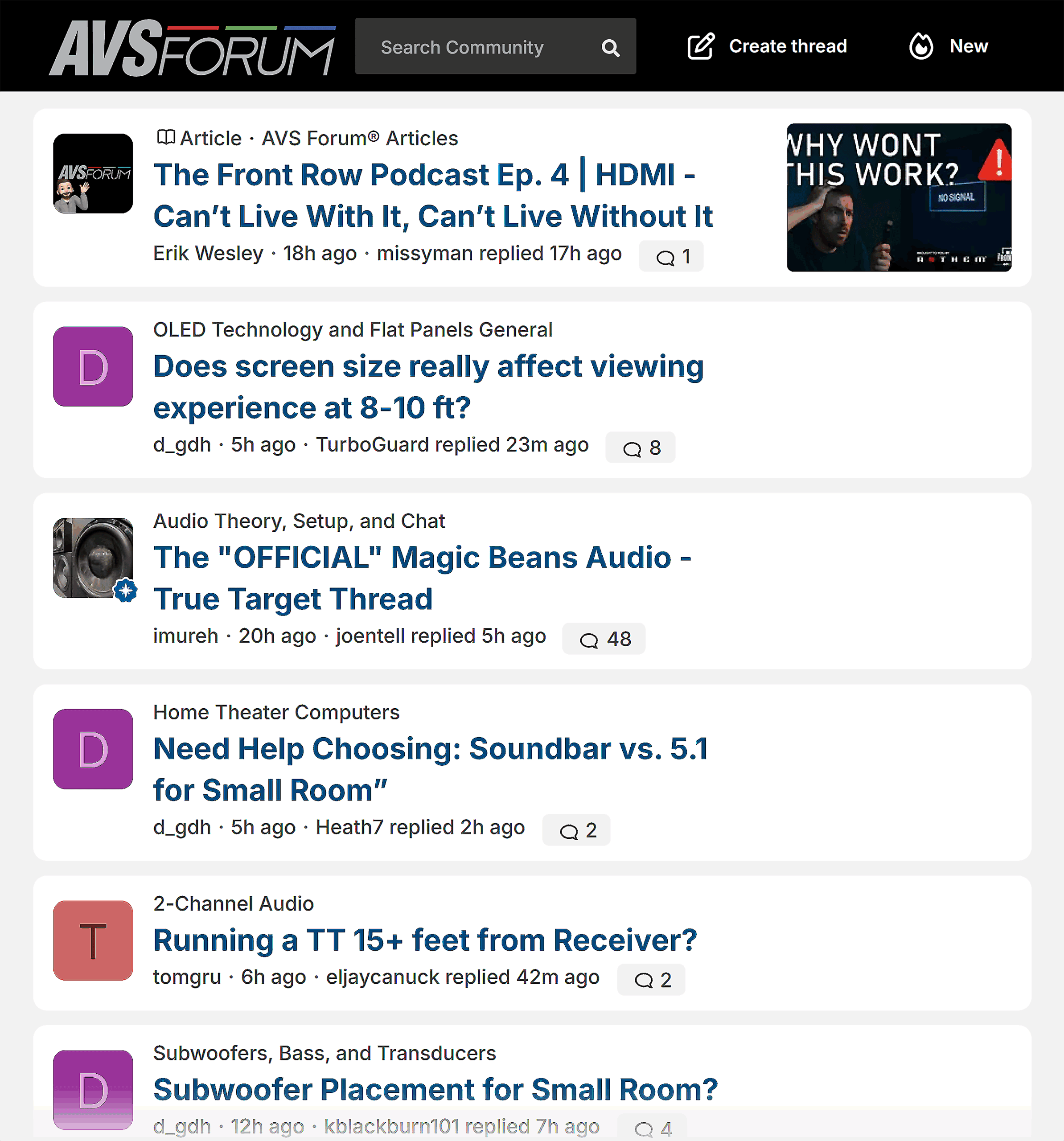
Contribute regularly with meaningful, non-promotional input.
Answer niche questions, clarify common misconceptions, or share first-hand experience.
These authentic contributions increase your chances of getting cited in AI-generated responses where nuance and expertise matter most.
Editorial-Style Microsites
Want to boost your chances of getting cited by LLMs? Build an editorial-style microsite.
These standalone sites tend to carry more credibility than heavily branded company pages.
Why?
Because you can structure them like independent publications.
Like this microsite IKEA built to highlight original research:
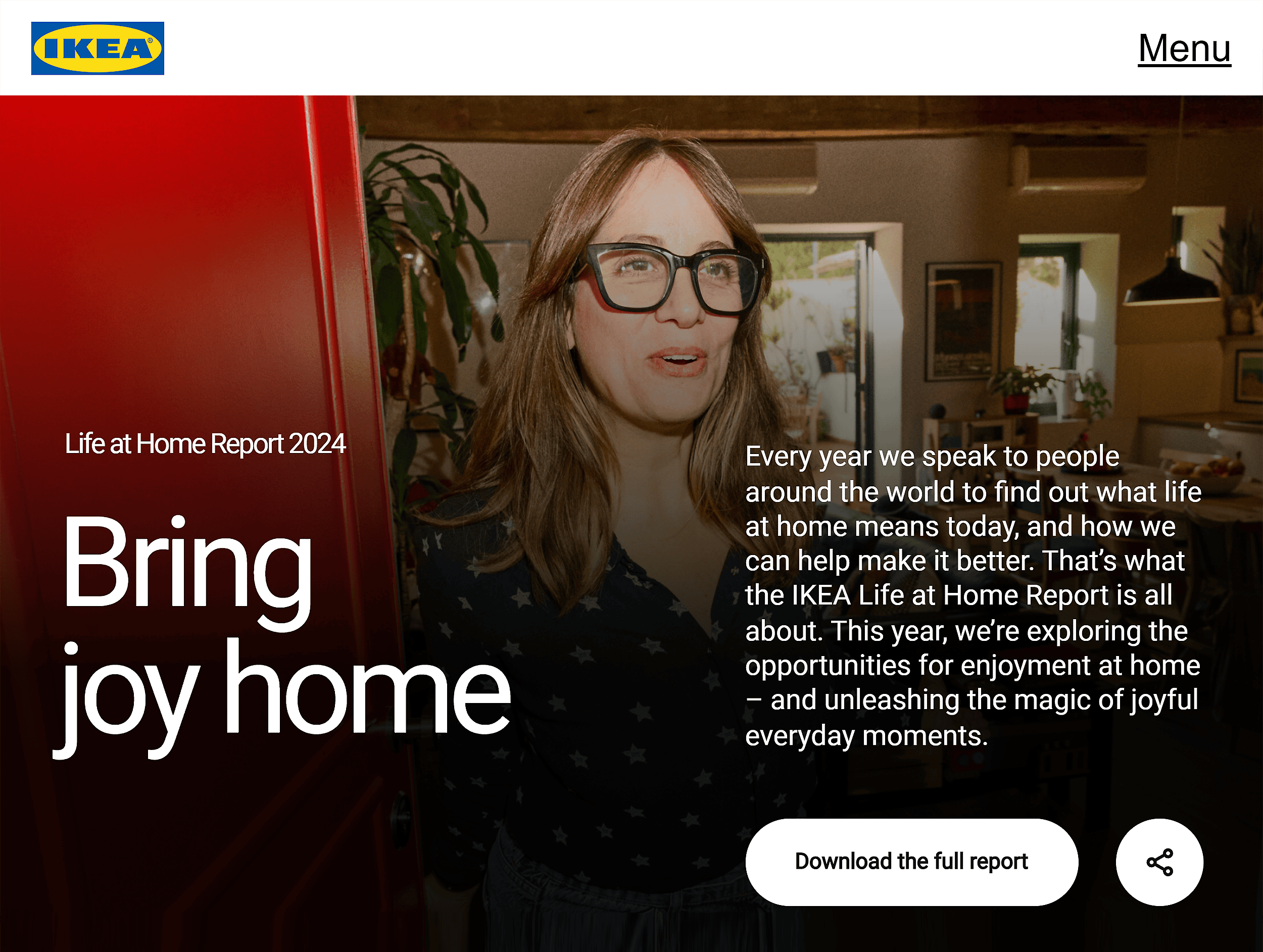
The goal is to create a trusted, well-organized resource that covers your entire industry, not just your own product.
For example, IKEA’s microsite includes statistics on happiness and enjoyment at home, which ties into its core offering: home products.
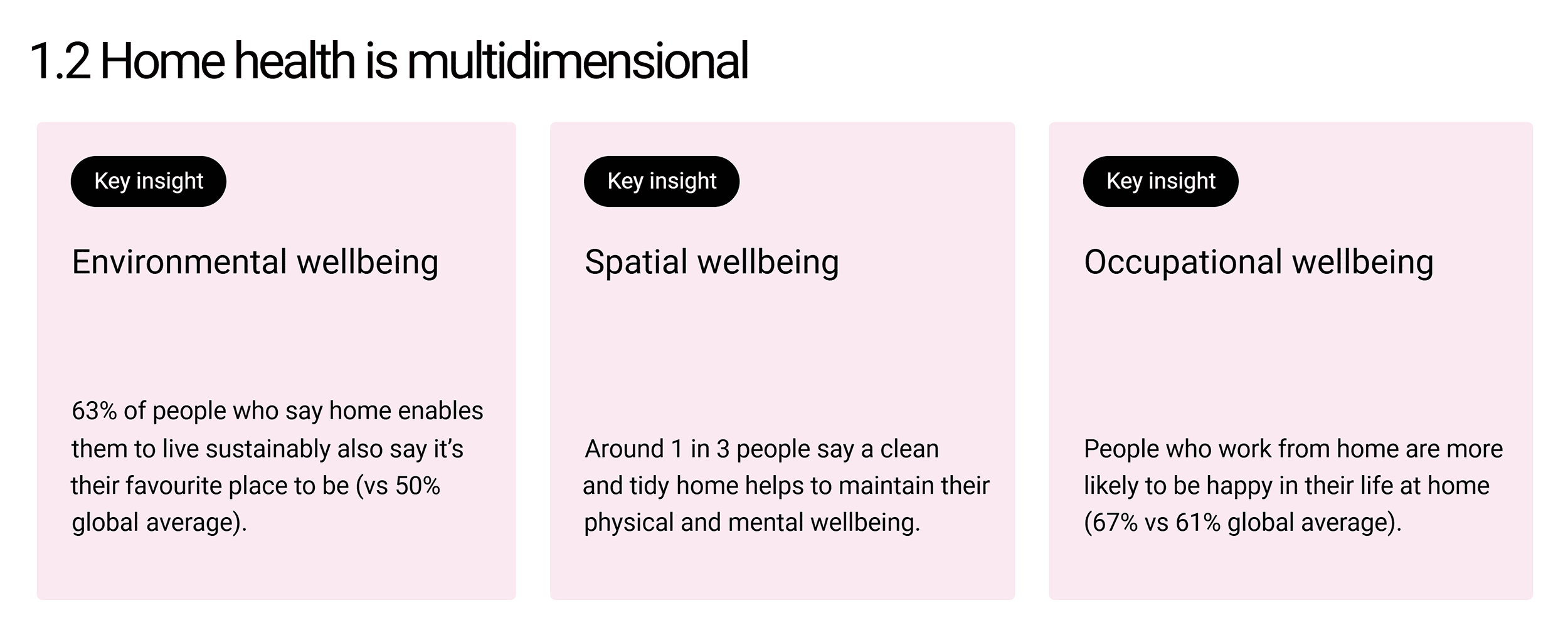
To earn trust (from both readers and LLMs), focus on E-E-A-T signals.
Include author bios with credentials, cite reputable sources, and make your editorial policies easy to find.
Clearly state who’s behind the site and why it exists.
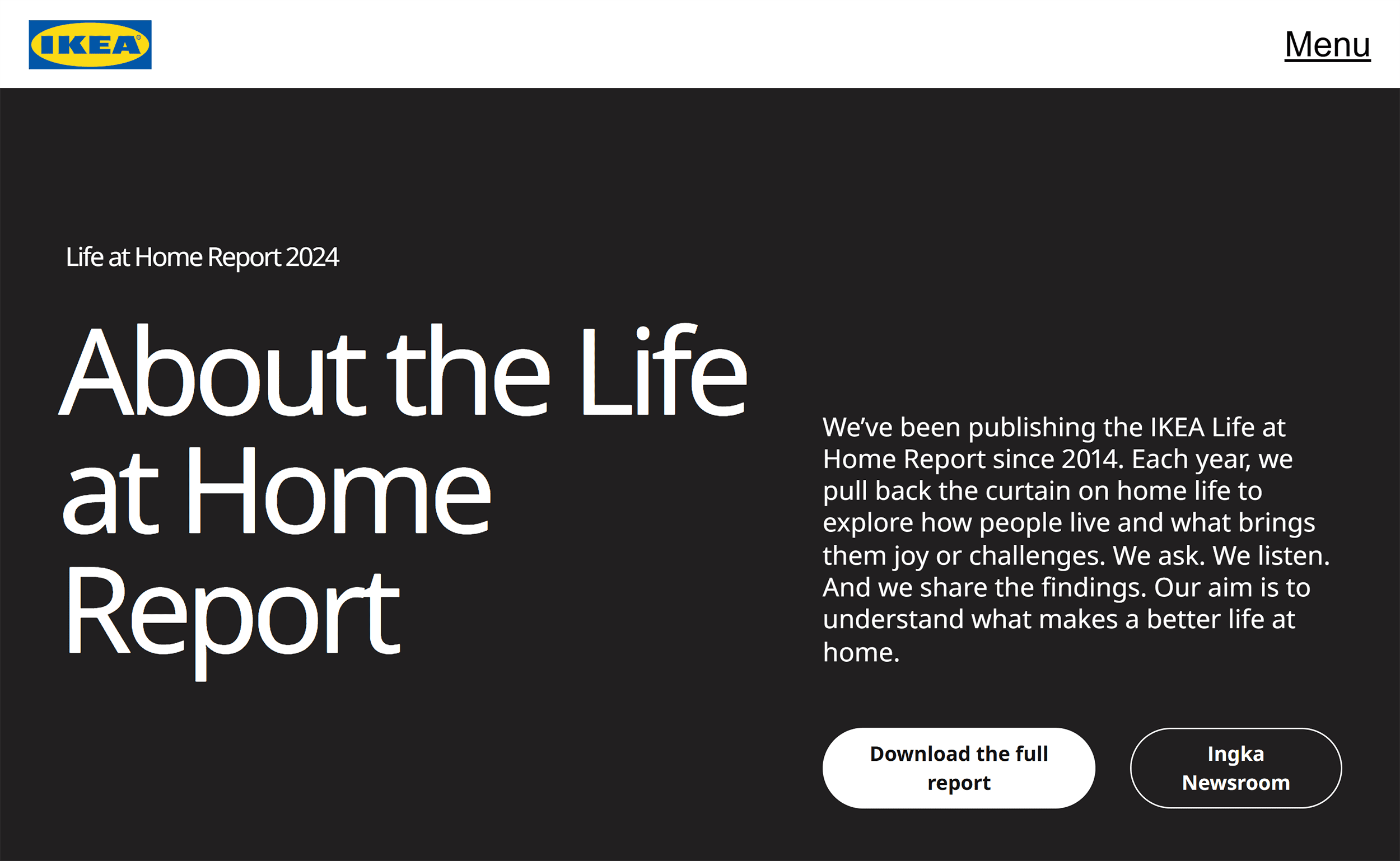
Comparison and Review Sites
Content from review platforms is often cited in LLMs, and for good reason.
Sites like G2, Capterra, and TrustRadius follow a formula that attracts LLMs:
Feature breakdowns + pros & cons + user reviews = LLM-friendly content
You can’t always control how your product is described on these platforms, but you can influence how well it performs there.
Start by actively encouraging customers to leave honest, detailed reviews.
Encourage them to explain why they chose your product and what results they’ve seen.
Follow up with power users, beta testers, and long-term customers.
Prompt them with questions like:
“What specific feature helped you solve a key problem?” and “How does this tool compare to others you’ve used?”
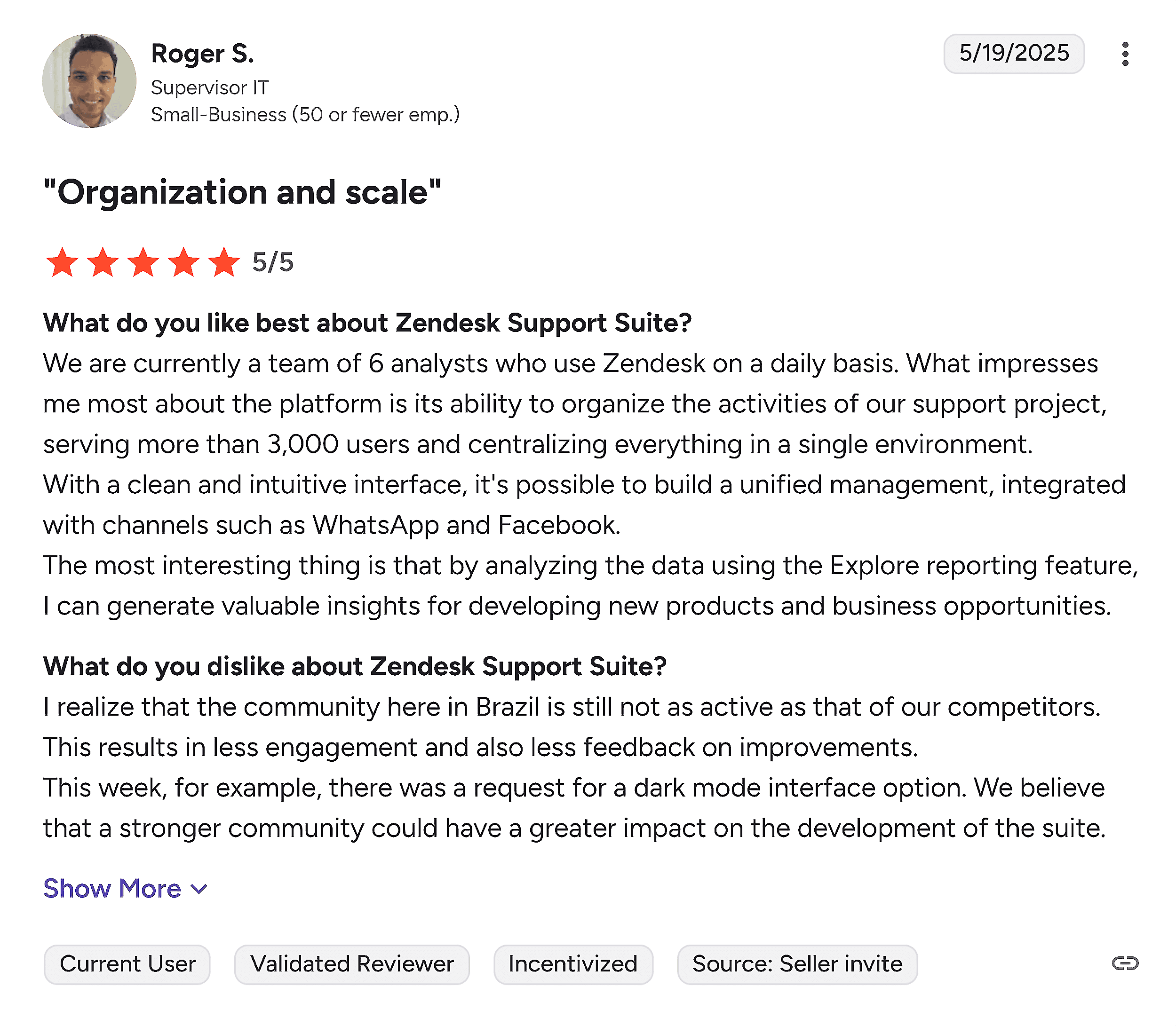
The more detailed and context-rich the reviews, the more useful your listing becomes to buyers and LLMs.
Social Platforms
Just like us, LLMs have clear preferences when it comes to social media platforms.
Particularly the ones that attract valuable content that’s easy to parse and cite.
To increase your chances of LLM citations, always use clear, searchable language on the following platforms:
- X: Educational threads tend to perform better than quick takes. Focus on multi-post insights that break down processes, strategies, or frameworks
- YouTube: Boost your chances of being referenced by including descriptive titles, detailed titles, video descriptions, and accurate captions
- Pinterest: Ideal for visual brands — but only if your pins include rich descriptions and link to structured content
- Instagram: As of July 2025, Instagram posts (if opted in) can be indexed by search engines and LLMs. Add captions, alt text, and hashtags to help shape how your brand appears in AI platforms.
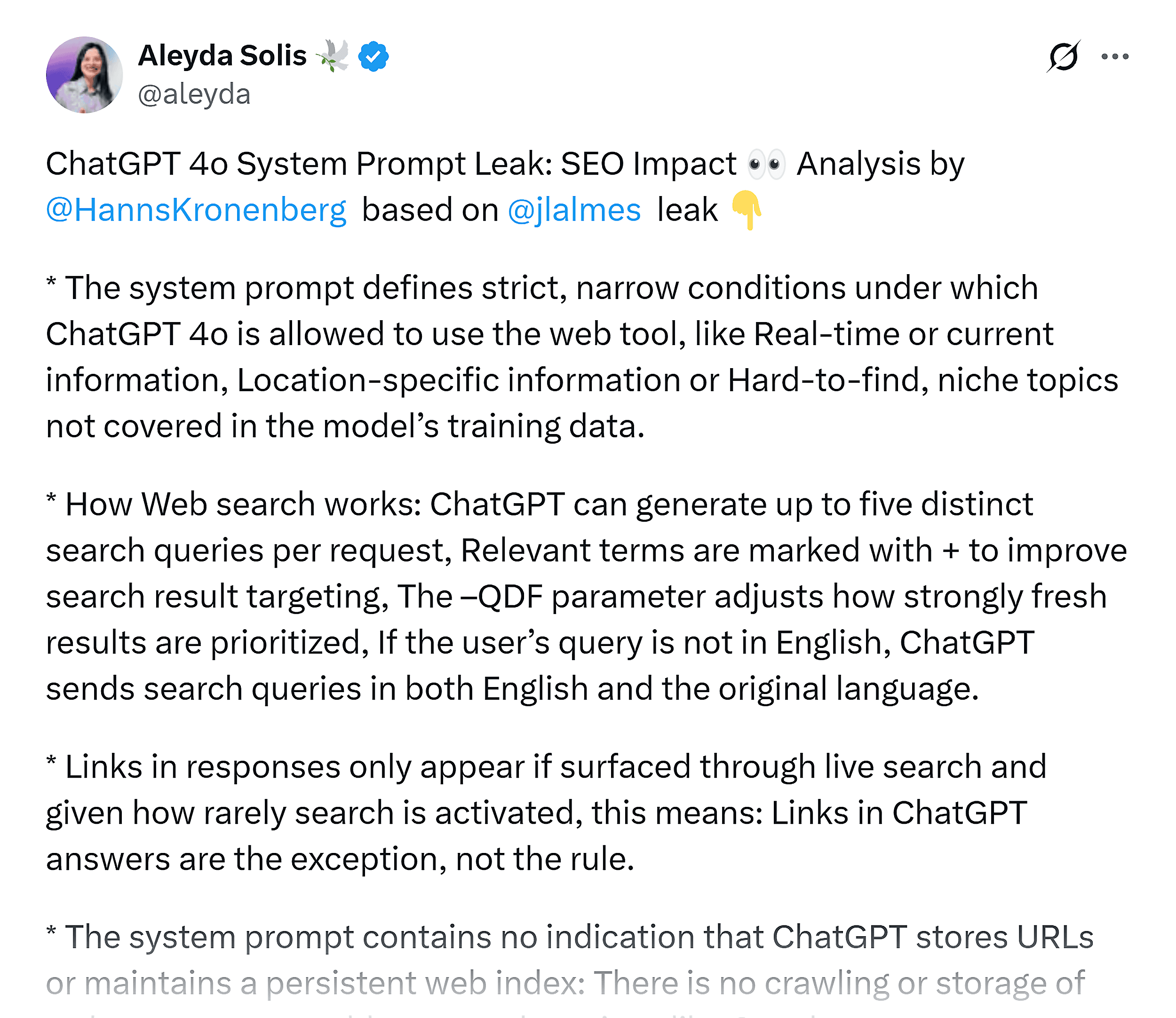
How to Track LLM Seeding Success
Here’s where things get tricky.
Understanding LLM impact isn’t as straightforward as tracking clicks or traffic.
So, how do you measure this influence?
Here are a few smart ways to assess your brand’s visibility across LLMs.
Branded and Direct Traffic Growth
Noticed something weird going on in Google Search Console lately?
Your impressions are increasing … but clicks are decreasing.
LLMs might be to blame.
For example, at Backlinko, our impressions increased by 54% over the past three months, while our clicks decreased by 15%.
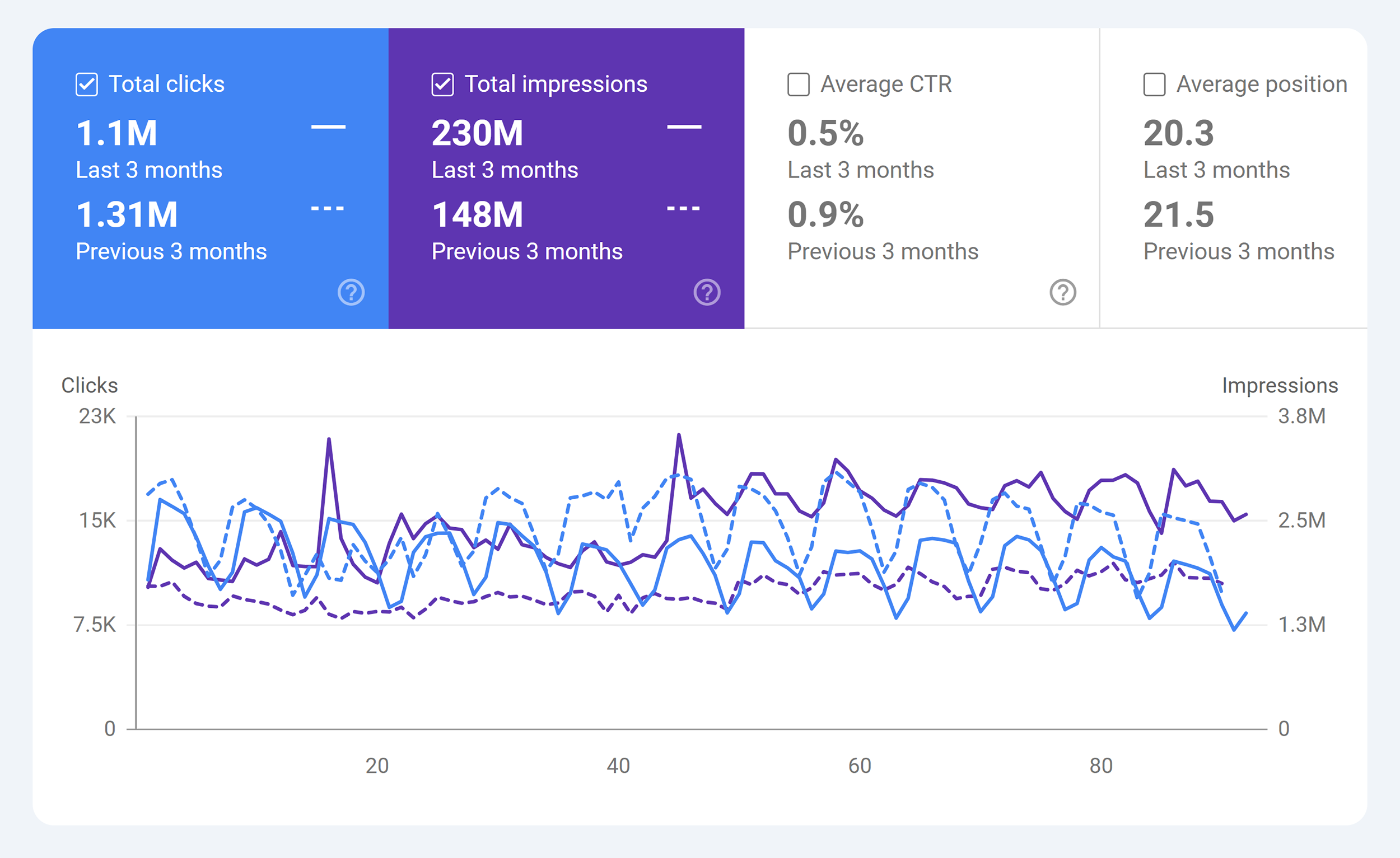
Here’s what’s happening:
Users see your brand mentioned in AI responses, make a mental note, then research you directly days or weeks later.
They’re not clicking through immediately. They’re bookmarking your name in their minds.
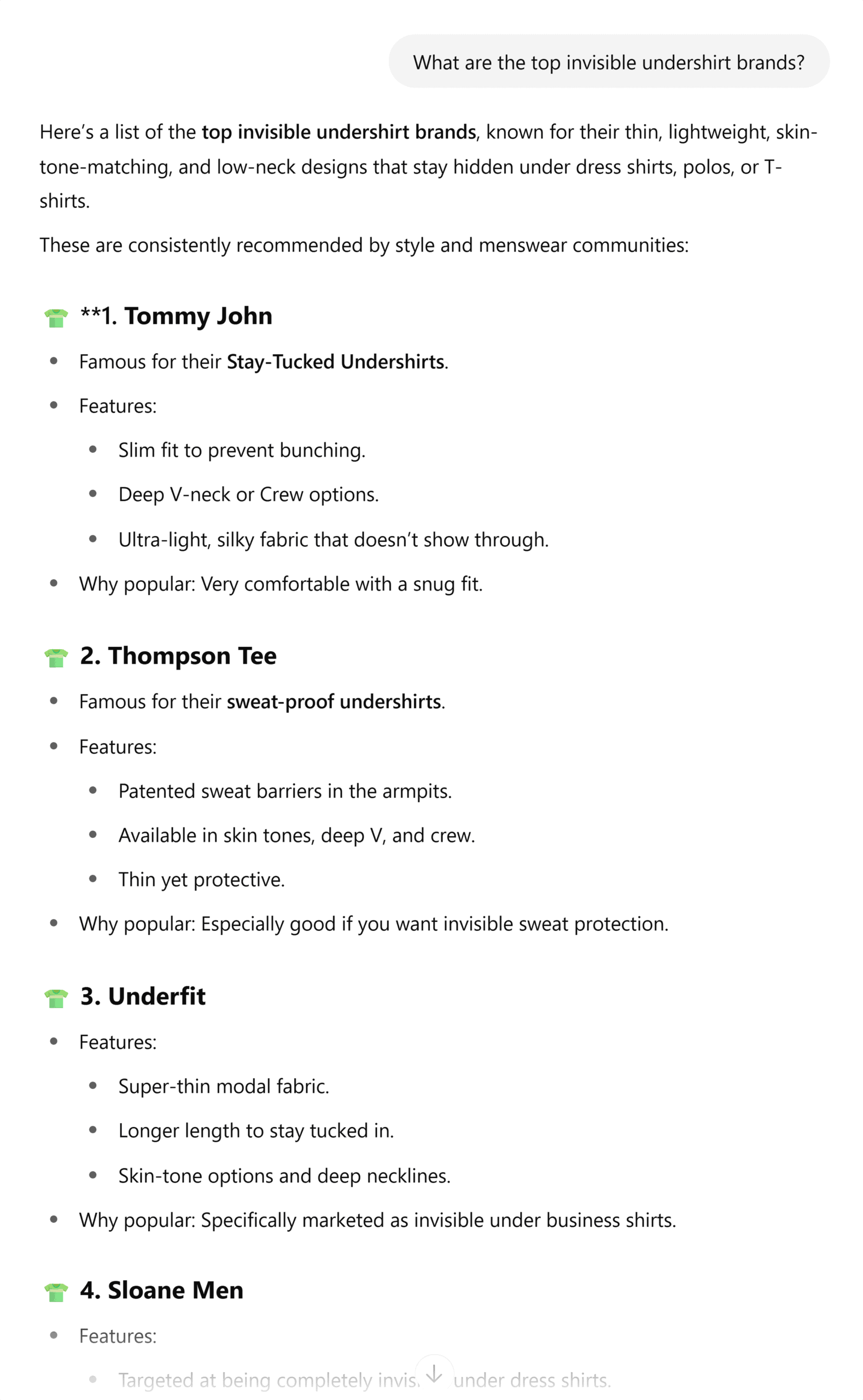
This creates declining organic clicks paired with stable or growing branded searches. And it’s the signature pattern of LLM influence.
Here’s how to spot it in your data.
Open Google Analytics (GA) and go to Reports > Acquisition > Traffic Acquisition.
Compare your direct traffic trends over the past three to six months.
If your direct traffic increased, this is a positive sign that LLMs are mentioning your brand.
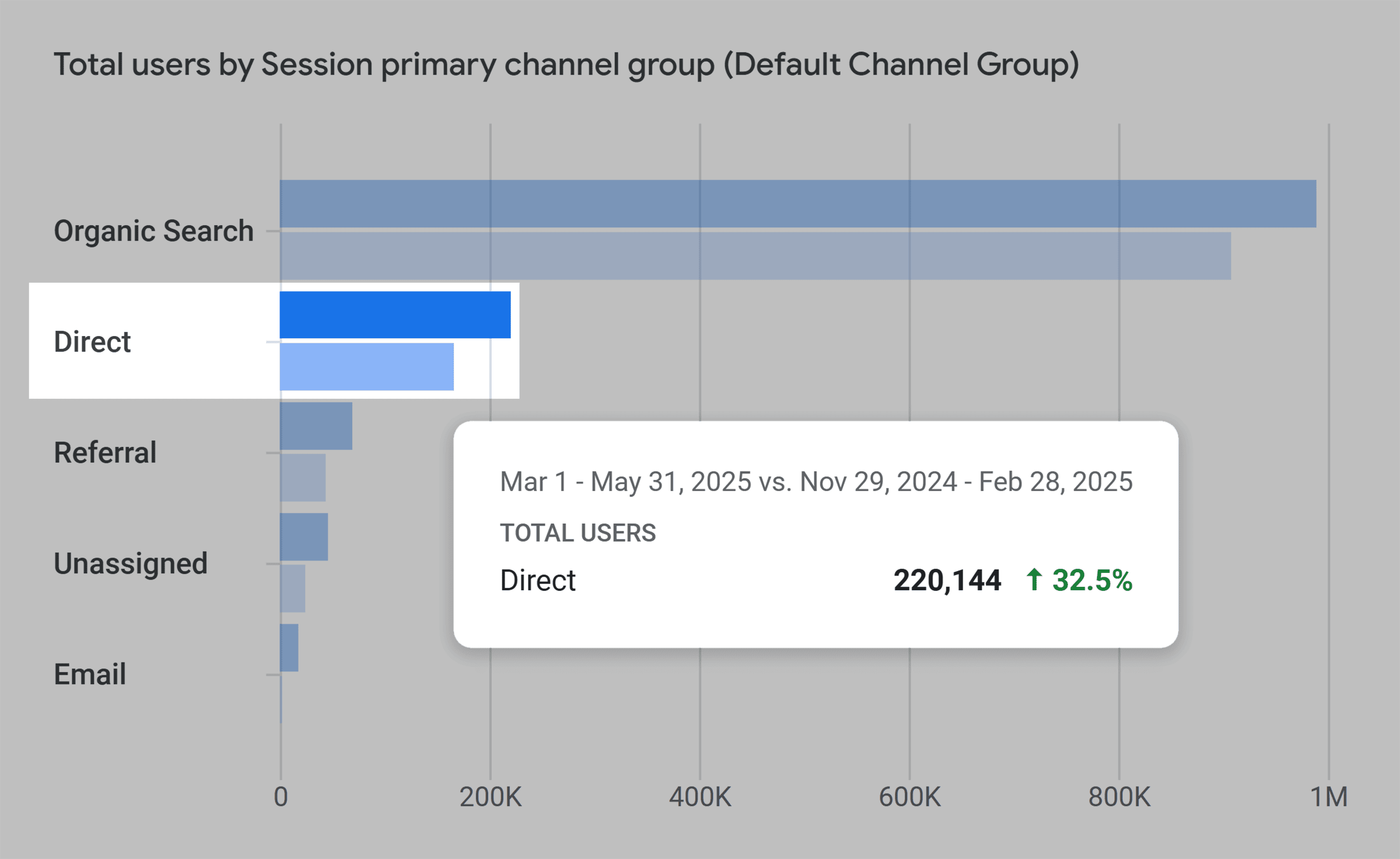
Next, compare these patterns to your organic traffic changes in Google Search Console (GSC).
Go to Performance > Search results.
Declining clicks + growing direct traffic = LLM visibility.
If your data is pointing to LLM influence, this is a good thing.
But it’s important to verify your findings with manual prompt analysis.
Pro tip: Getting branded traffic? Great. Now, ensure your branded SERP is optimized so users searching for your name land on high-converting pages. Like product quizzes, comparison guides, or testimonials.
Brand Mentions in AI Tools
The clearest way to gauge your LLM visibility is to see if (and how) your brand shows up in AI-generated answers.
Run manual prompts across different tools like ChatGPT, Claude, Perplexity, and Gemini.
Use a private or incognito browser to avoid skewed results from past queries or personalization.
Then, search the way your audience would … naturally and with clear search intent.
Try prompts like:
- Best project management tools for remote teams
- What is the best project management software for startups
- Top budget-friendly productivity tools for small businesses
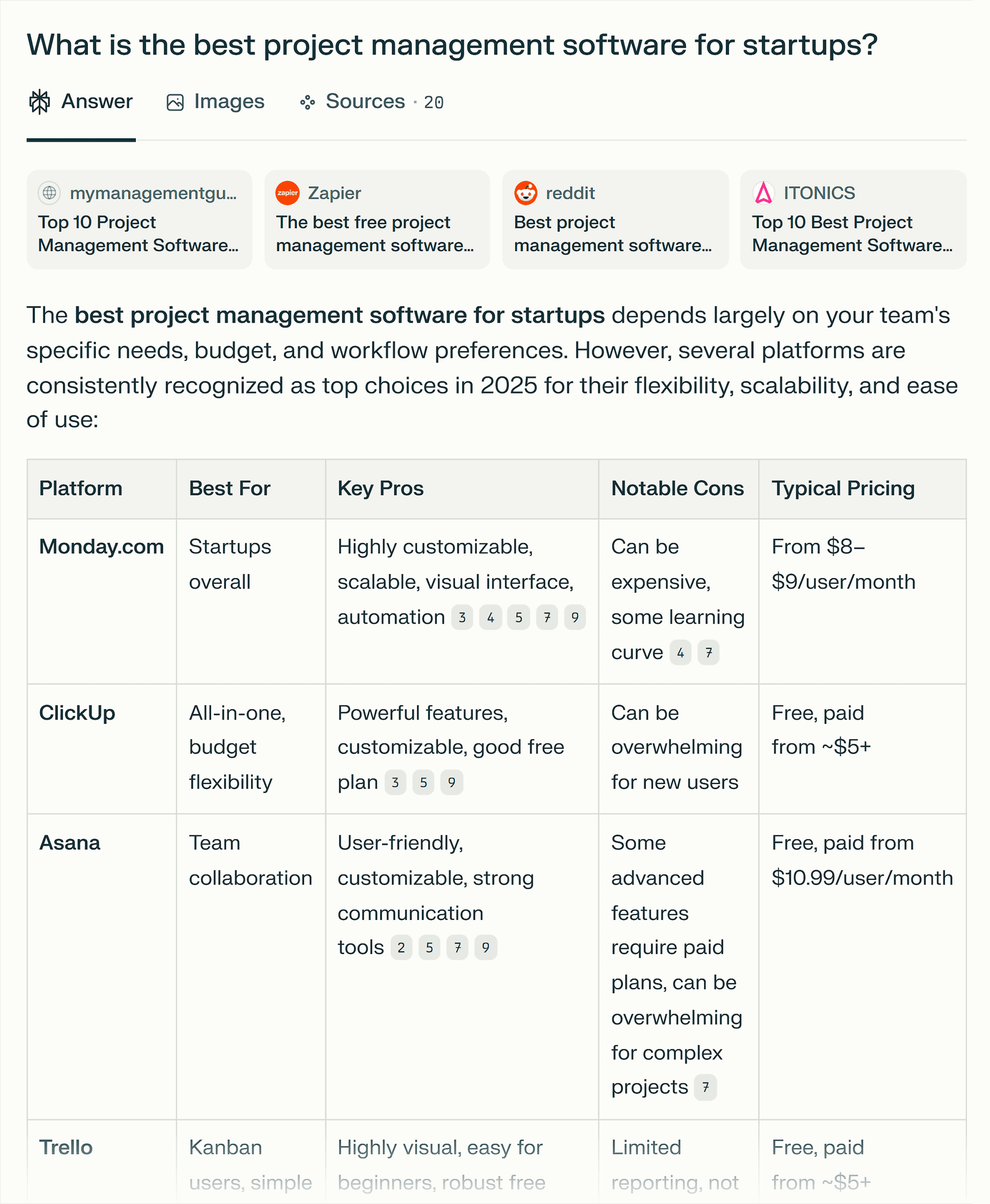
Document the sentiment and context of each mention.
Are you positioned as a budget option? A premium choice? The innovative newcomer?
Do certain LLMs recommend your product more or less?
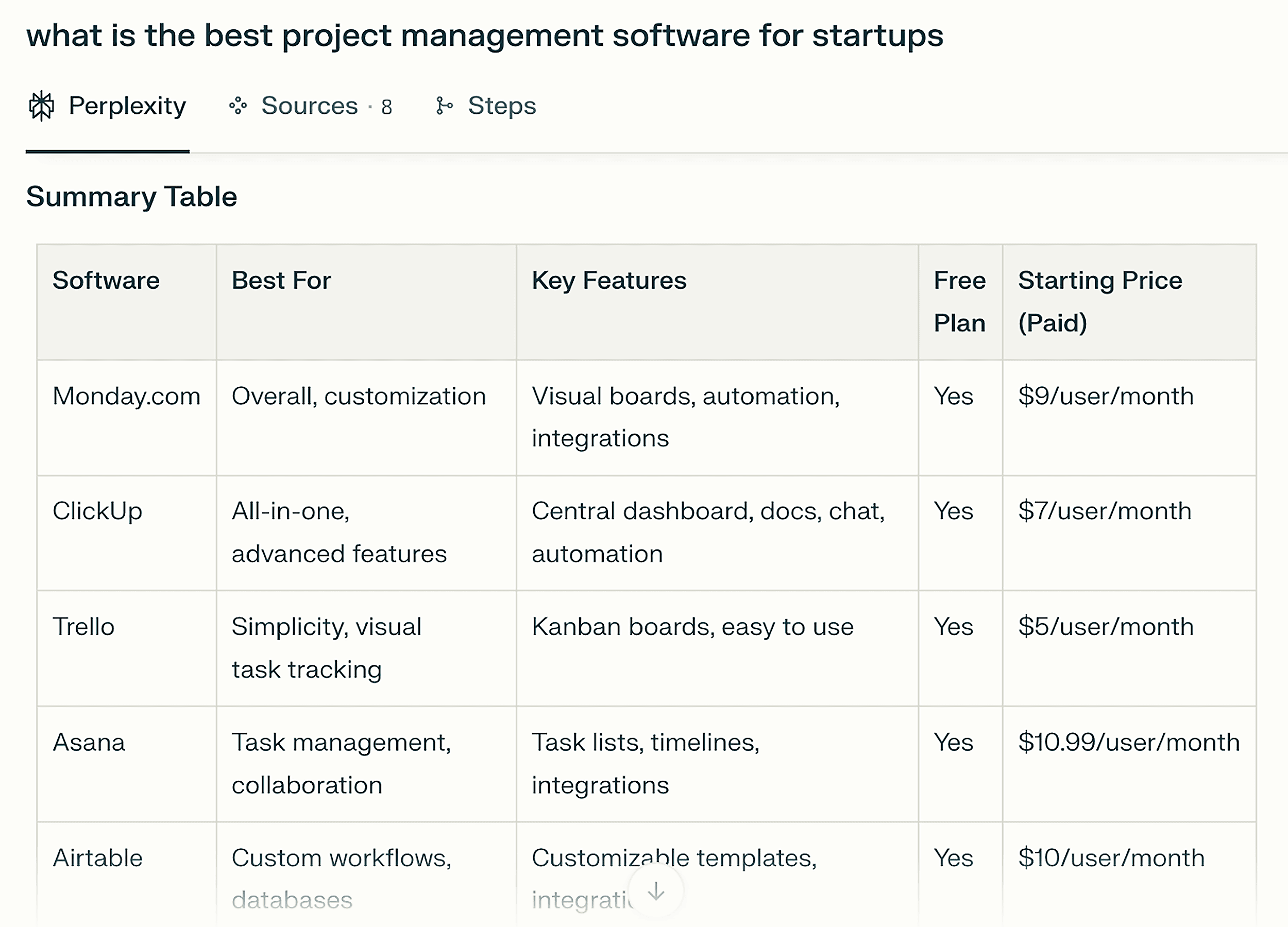
Document these results monthly in a spreadsheet or tracking doc.
Include the tool used, the prompt, the exact language cited, and your position in the response.
This lets you identify shifts in brand positioning, message clarity, and which prompts consistently trigger mentions.
Not showing up yet?
You’ll still learn what LLMs are citing so you can reverse-engineer how to get included.
Pro tip: Make your LLM citations work harder. Add email capture opportunities to your top pages. (Especially ones on topics LLMs are likely to mention.) Use content upgrades, templates, and discounts to turn visitors into subscribers.
Unlinked Brand Mentions
Not every brand mention includes a link to your site, making this influence harder to track.
But since LLMs weigh authentic, third-party references heavily when determining what content (and brands) to trust and cite, these mentions are vital.
Use tools like Semrush Brand Monitoring, SparkToro, or Google Alerts to track brand mentions.
Set up alerts for your brand name, product names, and key team members.

As you get mentions, dig into the context.
- Are you being cited as an expert?
- Recommended as a tool?
- Compared to a competitor?
If you’re not getting many mentions, look for opportunities to contribute.
Pitch newsletter authors or podcast hosts with useful, non-promotional content that fits their audience.
Join relevant discussions, offer expert insights, and speak at industry events.
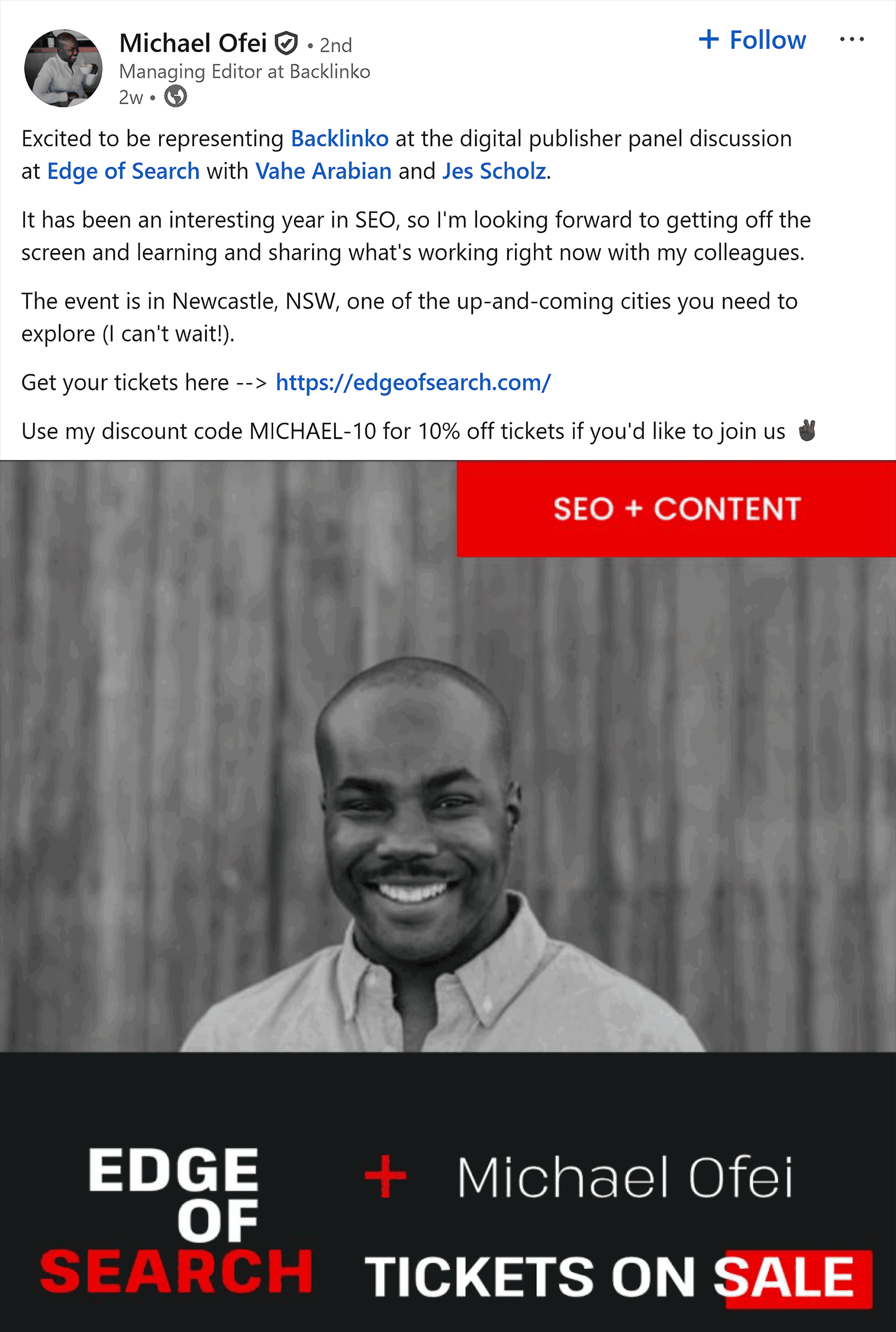
Continue tracking mentions over time to measure whether your efforts result in increased LLM visibility.
LLM Visibility Across Platforms
We’re all used to tracking rankings and referral traffic.
But those signals no longer tell the full story.
Tracking your performance across AI platforms is now a core part of measuring your success.
But you’ll need specialized tools for this.
Semrush’s Enterprise AIO lets you track how your brand is perceived and cited in popular AI platforms.
Once you set it up with the AI models and prompts that you want to track, it’ll tell you how your LLM visibility compares to competitors.
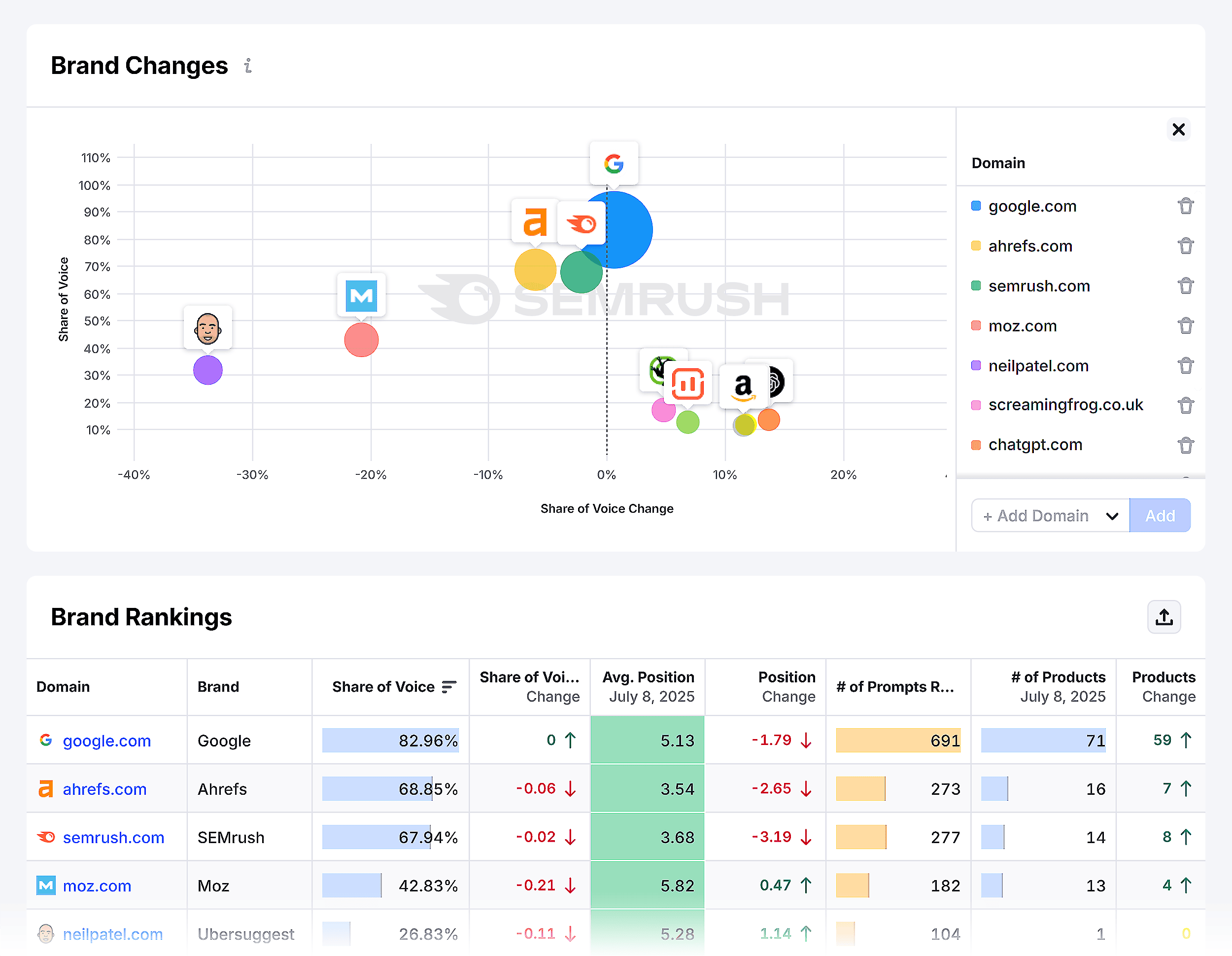
That’s just scratching the surface. You can also track your brand’s overall market share, sentiment, and consumer engagement across AI platforms.
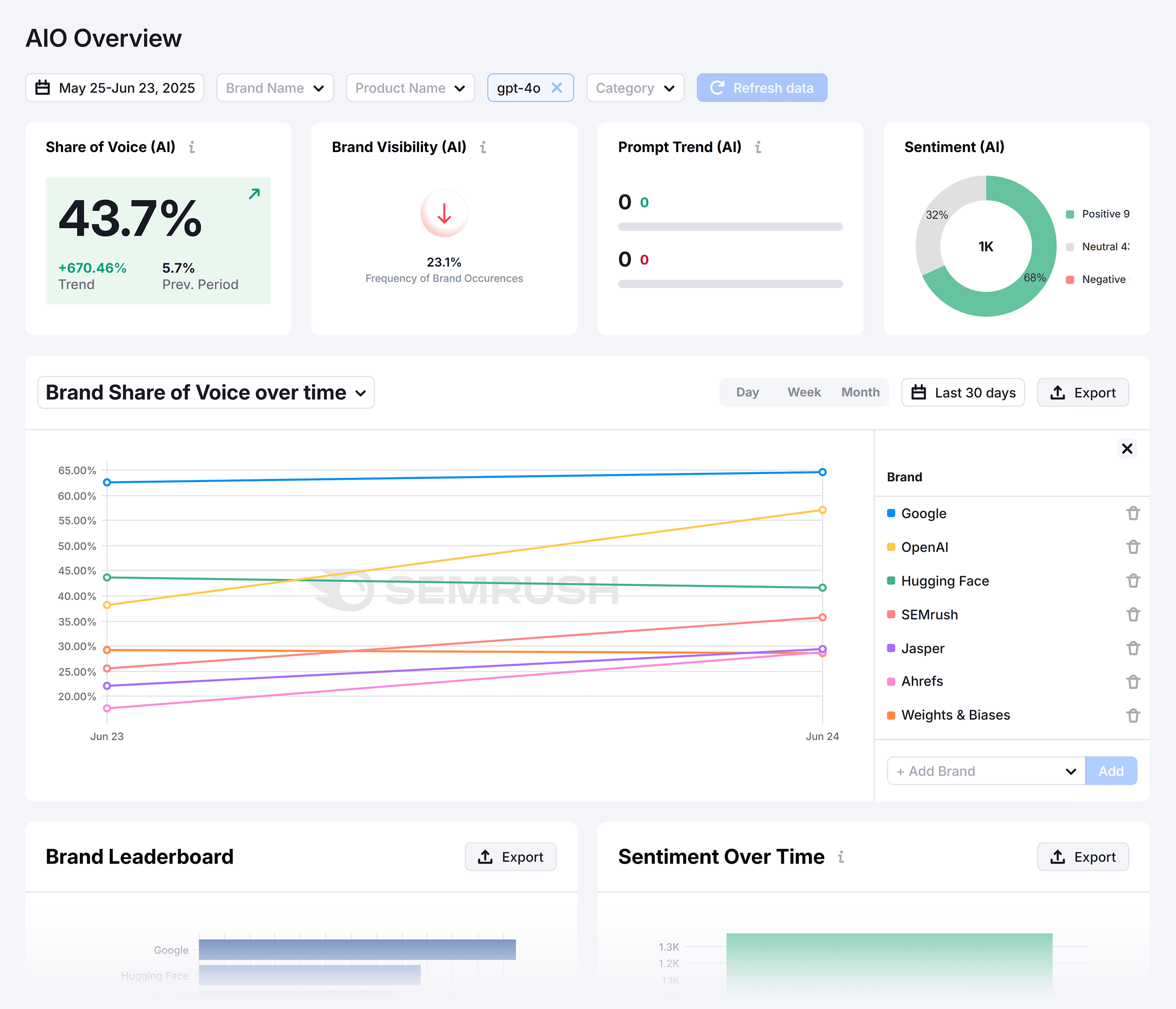
Semrush’s AI Visibility Toolkit also lets you track how your domain and overall brand are perceived by individual models. It’s not super customizable yet, but you can still gain a lot of insights.
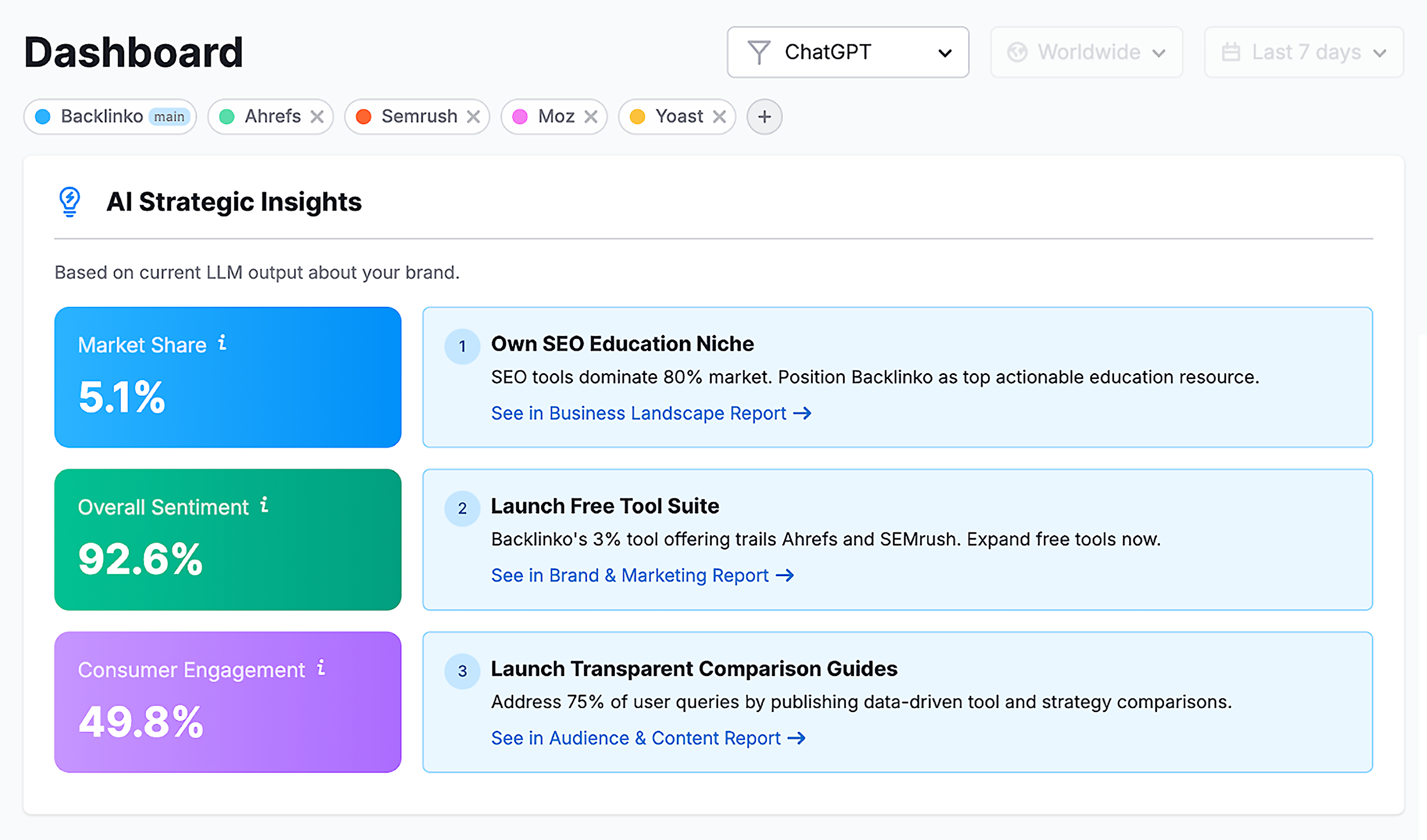
From there, individual reports break those metrics down by platform.
This gives you a clear view of where you’re gaining traction. And where you may be falling behind.
For example, pet company Petlibro currently holds a much smaller market share in ChatGPT than its competitors.
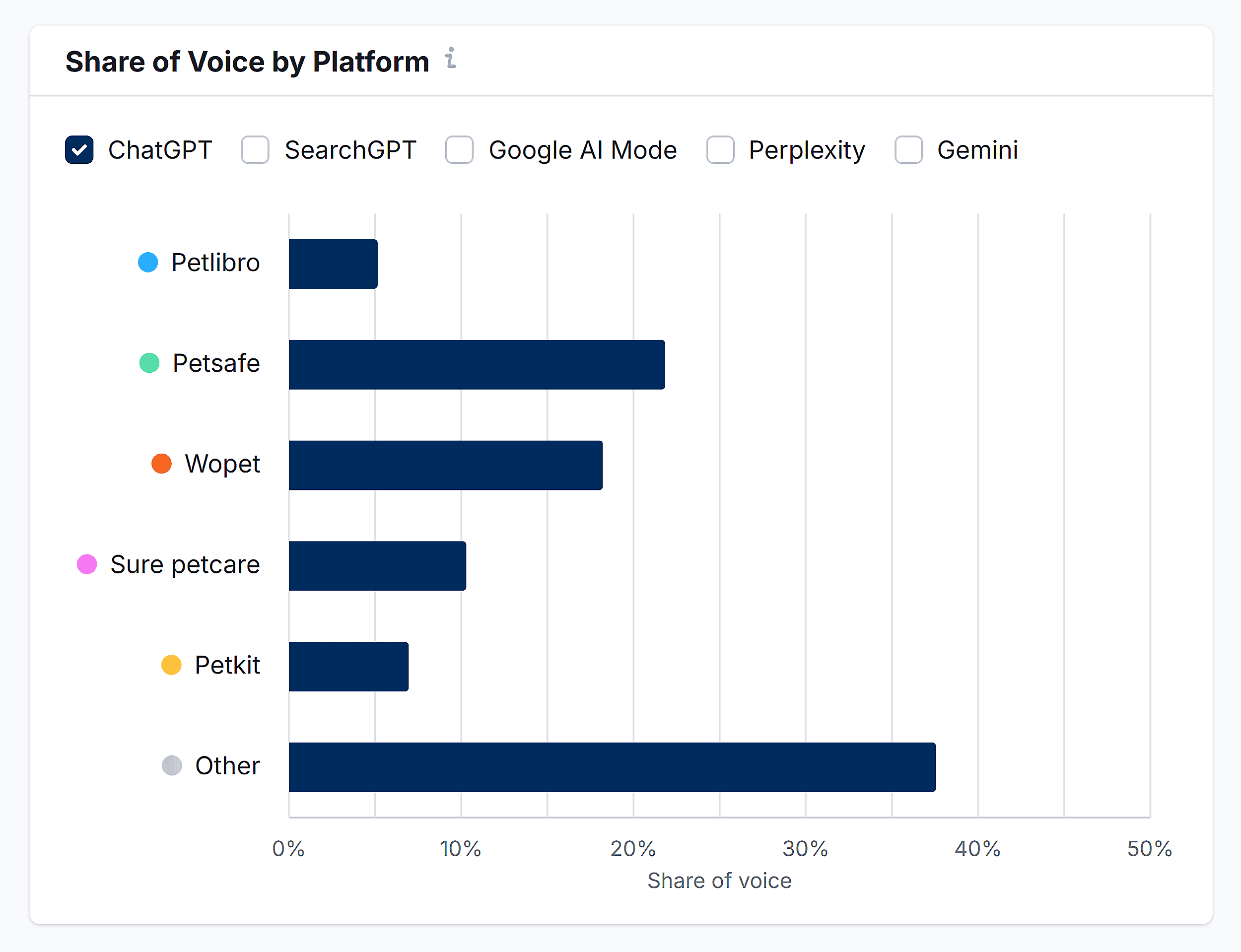
But in Google’s AI Mode, Petlibro significantly outperforms those same brands.
This is important data because it shows that performance can vary widely by platform.
And tells you where to focus your efforts.
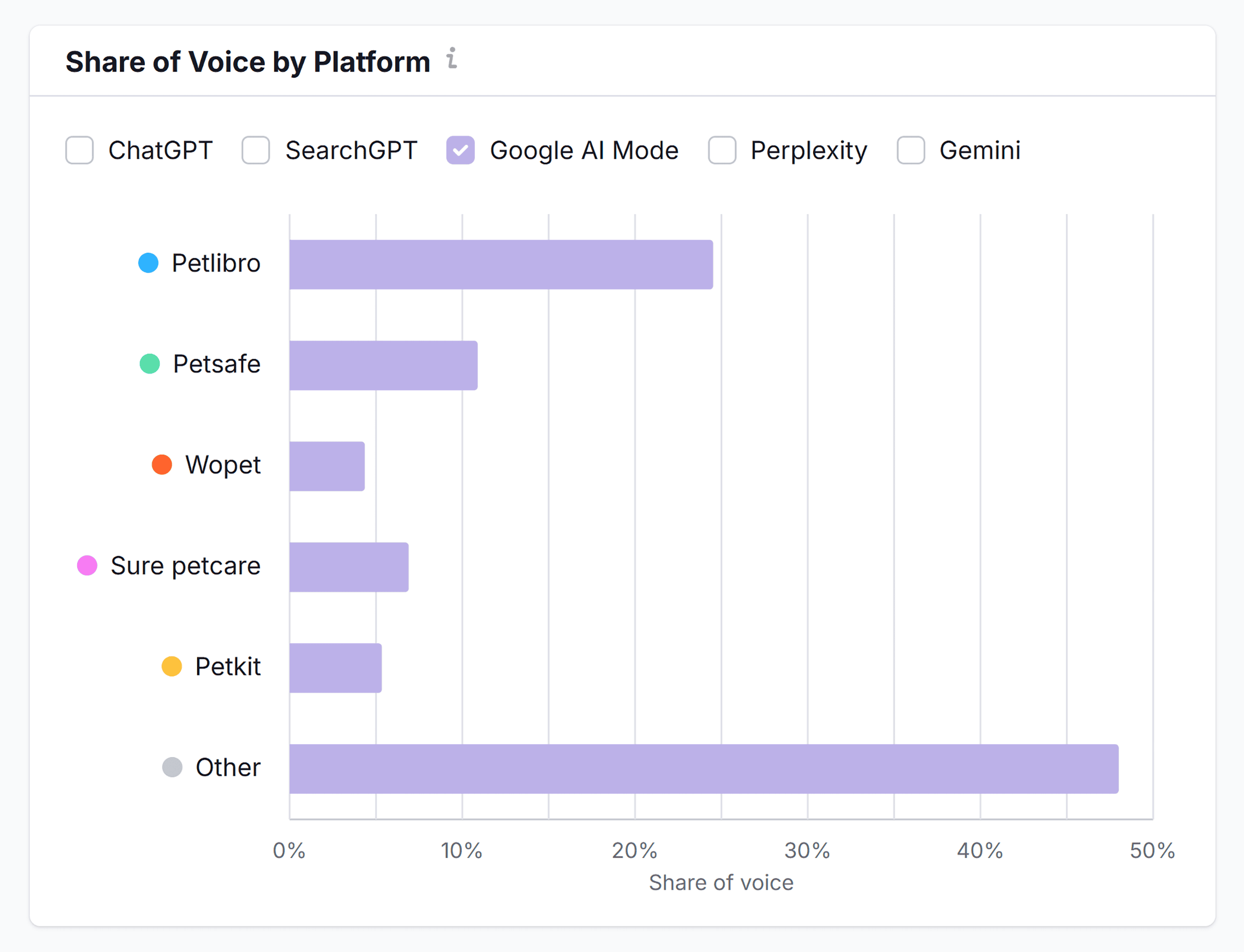
The toolkit also provides sentiment analysis reports so you know how AI platforms describe your brand.
Whether positively, neutrally, or negatively.
This gives you a clearer picture of how LLMs frame your brand in their responses.
Petlibro, for instance, has a 64% favorable overall sentiment score, indicating generally positive positioning.
But also room to strengthen how it’s perceived.
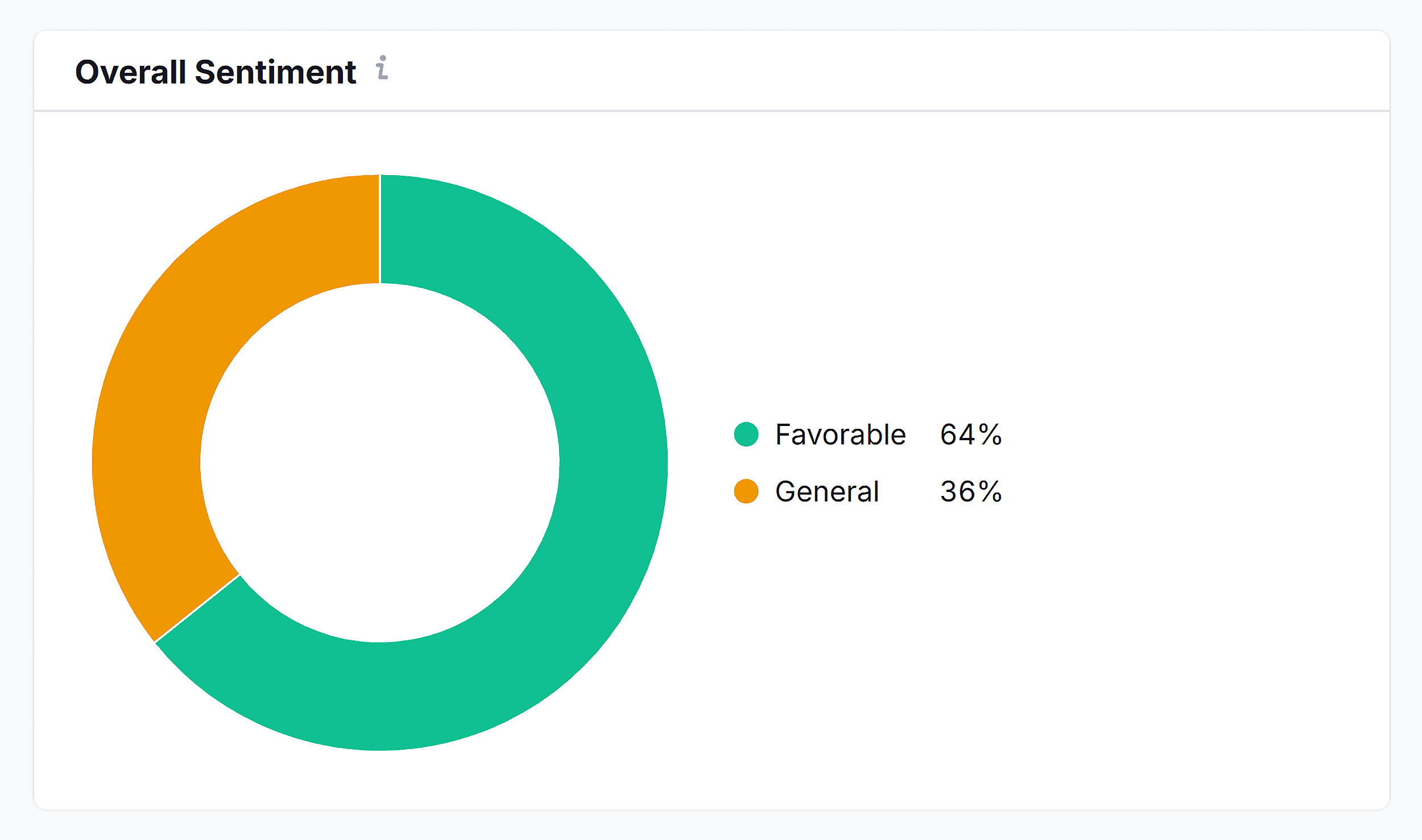
You can drill down further to see what’s behind your sentiment score.
Both the positives and the pain points.
For Petlibro, strengths like convenience, automation, and food freshness drive favorable mentions.
On the flip side, app connectivity issues and limited advanced features are flagged as recurring concerns.
This insight tells you what to highlight in content.
And identifies potential fixes to maintain or improve sentiment.
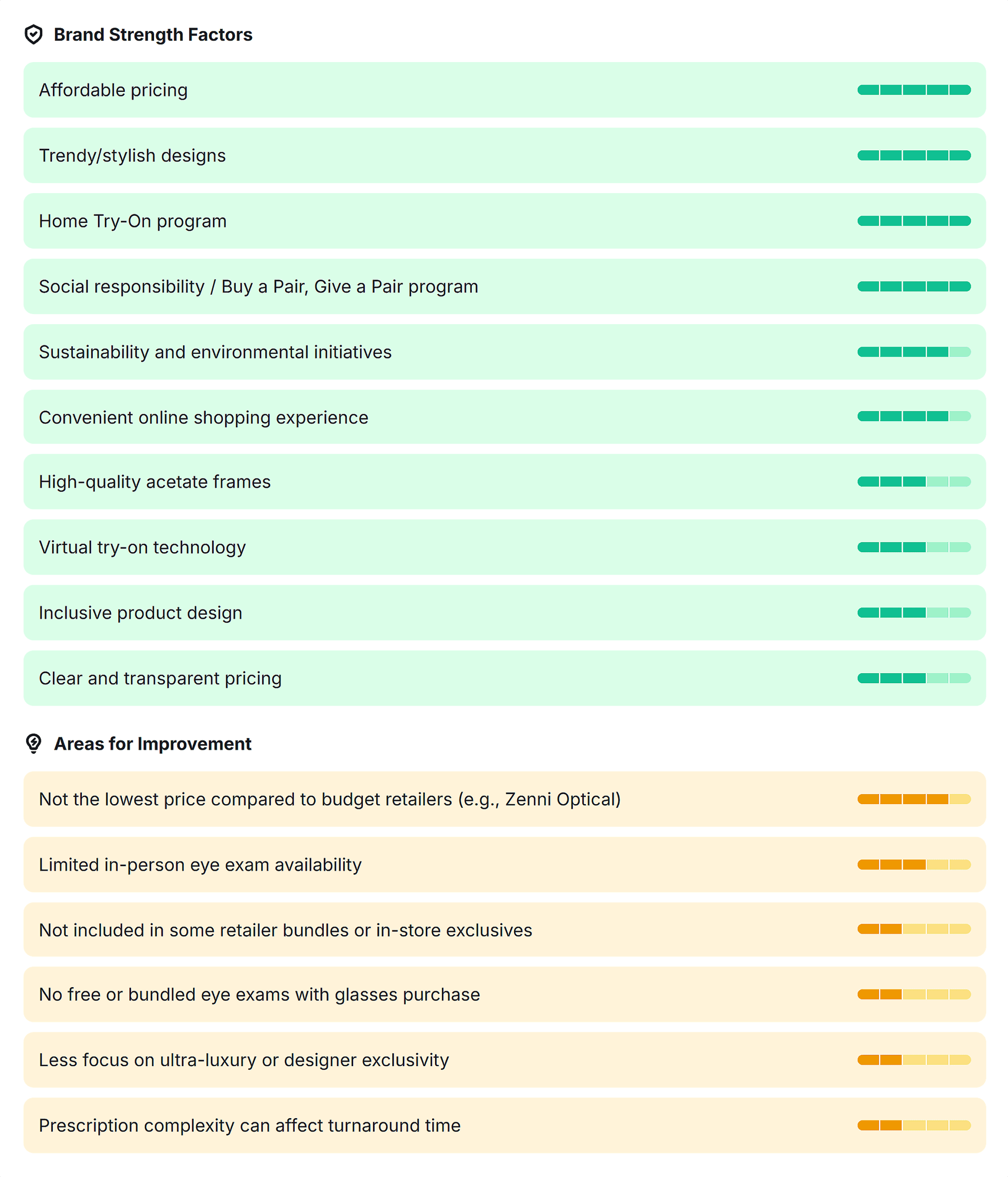
You’ll also learn the types of queries users ask about your brand. And the intent behind them.
For Petlibro, the majority are educational, followed by research-based queries.
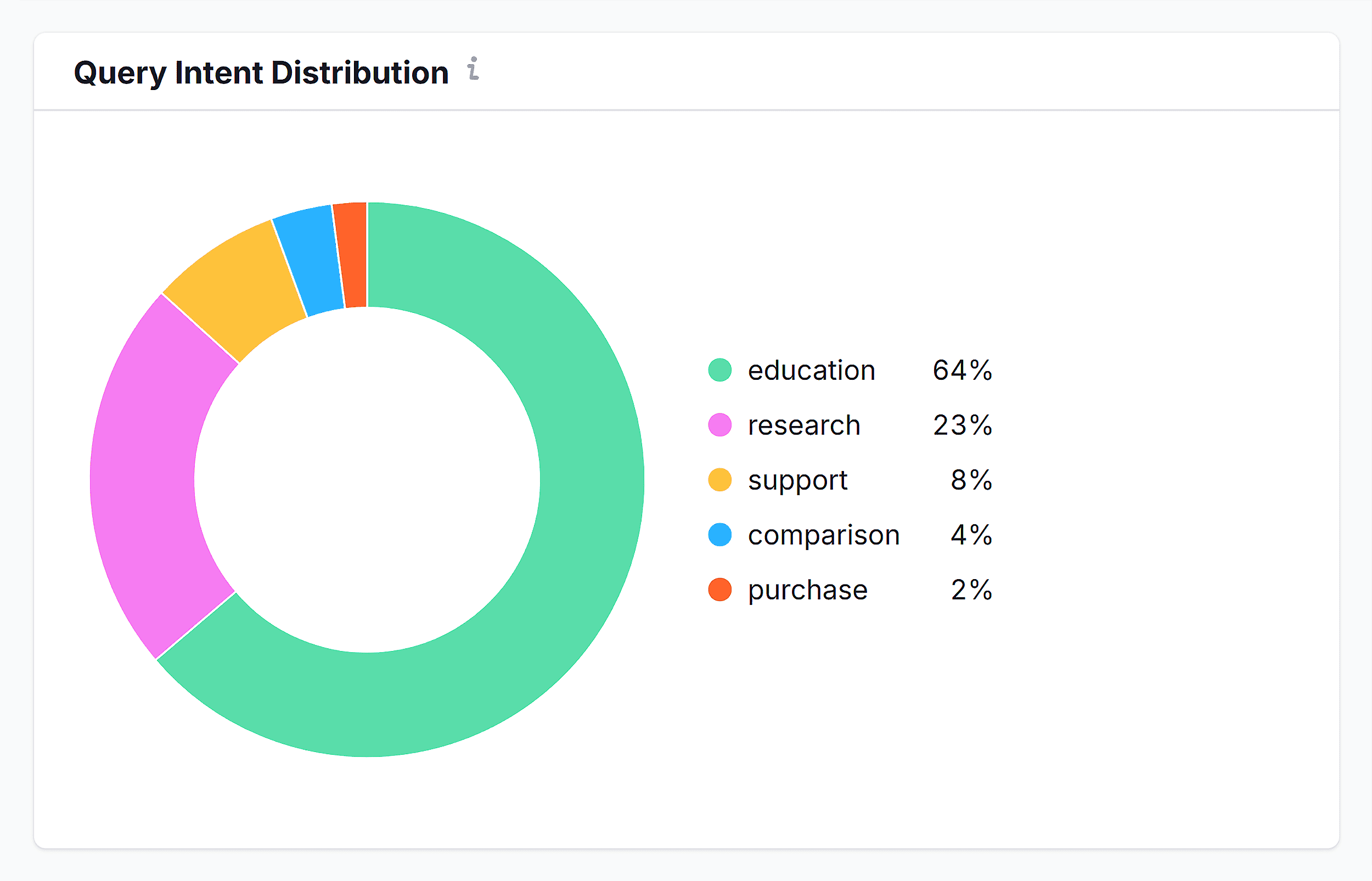
This tells you exactly what types of content to prioritize in your LLM seeding strategy.
For Petlibro, the toolkit suggests creating comparison charts, highlighting smart features, and showcasing testimonials that reinforce brand strengths.
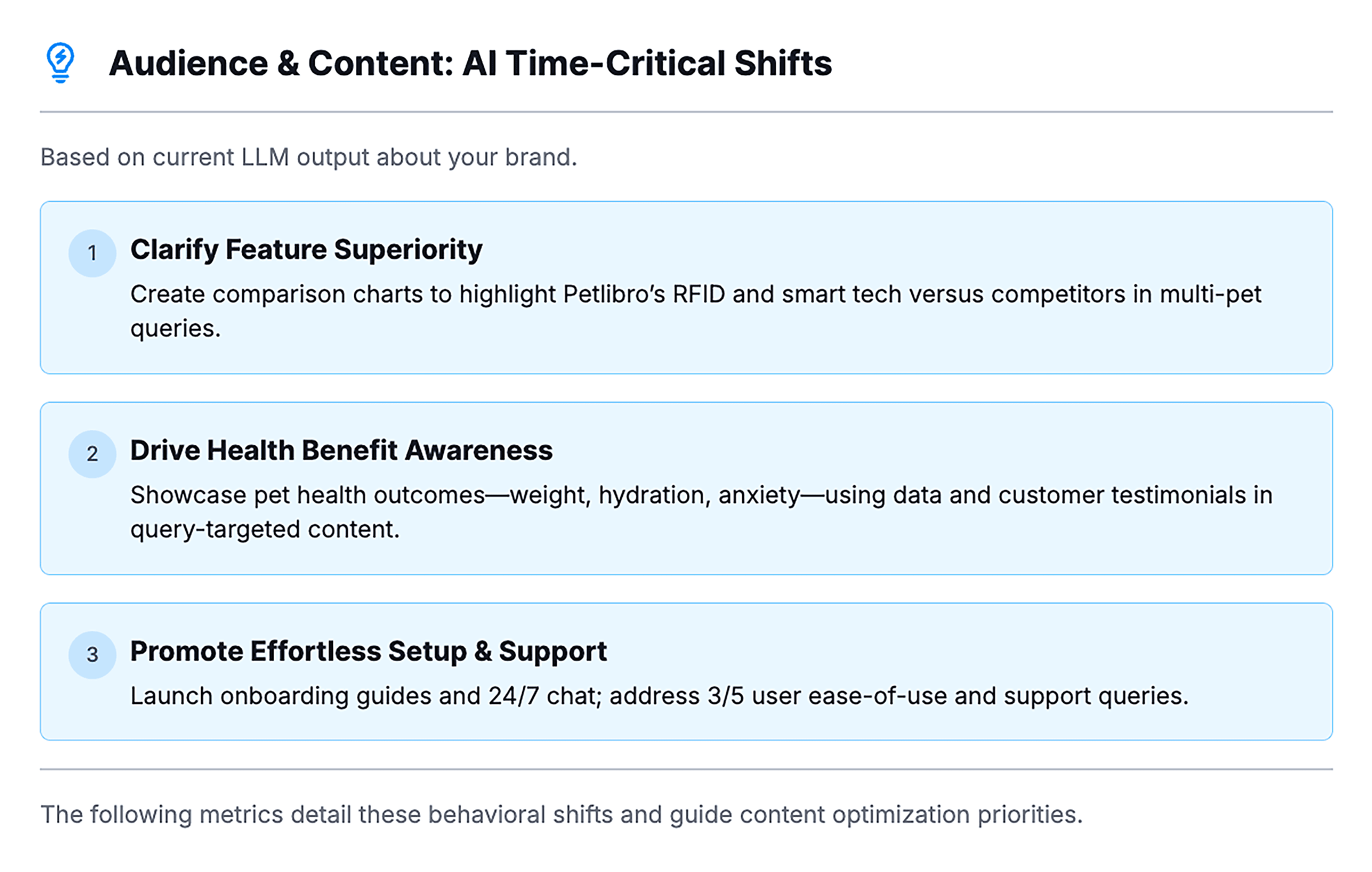
As you gather data, refine your seeding strategy.
Double down on what’s working, whether it’s a specific content format, platform, or message.
And use gaps in visibility or sentiment as signals for where to publish, what to say, and how to position your brand for maximum LLM impact.
Make LLMs Work for You, Not Against You
Moral of the story? Don’t fight the machine — work with it.
AI isn’t coming. It’s here.
And it’s already changing how your audience discovers, evaluates, and chooses brands.
The brands that get cited in AI answers will win mindshare — even if they never rank #1 or get a single click.
That’s what LLM seeding is about.
You’re not optimizing for traffic. You’re engineering trust.
You’re not chasing backlinks. You’re earning brand mentions.
So, if you want to stay relevant?
Get your brand into the conversation now so you don’t get left behind.
Then, use our Search Everywhere Optimization guide to expand that visibility across every surface your customers trust — from AI to Amazon and beyond.
Backlinko is owned by Semrush. We’re still obsessed with bringing you world-class SEO insights, backed by hands-on experience. Unless otherwise noted, this content was written by either an employee or paid contractor of Semrush Inc.



